
- Ancient Indian History - Home
- Study of Indian History
- Writing of Ancient Indian History
- Imperialist Historiography
- Historiography Nationalist Approach
- Marxist School of History
- Sources of Ancient Indian History
- Archaeological Sources
- Geographical Background
- Geography in Ancient Literature
- Stone Age Cultures
- Mesolithic Culture
- The Neolithic Age
- Chalcolithic Period of India
- Chalcolithic Culture In India
- Harappan Civilization
- Harappan Town Planning
- Harappan Crafts & Industries
- Harappan Culture
- Harappan Religion
- Harappan Chronology
- Vedic Civilization
- Vedic Society
- Vedic Politics
- Vedic Religion & Philosophy
- The Aryan Invasion
- Later Vedic Age
- Social System after Vedic Age
- Achievements of Indian Philosophy
- Evolution of Jainism
- Evolution of Buddhism
- Alexander’s Campaign in India
- Maurya Dynasty
- Kalinga War & its Impact
- Society & Economy during Mauryas
- Mauryan Governance
- Early History of South India
- Age of Smaller Dynasties
- Literature of Satavahana Period
- Society of Satavahana Period
- Economy of Satavahana Period
- Technology of Satavahana Period
- Chola Dynasty
- Pandya Dynasty
- Chera Dynasty
- Period of Foreign Invaders
- Gupta Period
- Decline of Guptas
- Governance of Gupta Period
- Literature of Gupta Period
- Economy in Gupta Period
- Science & Tech of Gupta Period
- India after the Gupta Period
- Period of Harsha
- South India during the Harsha Period
- Kadamba Dynasty
- History of Kamarupa
- India after Harsha
- Gurjara Pratiharas
- Palas of Bengal
- Rashtrakutas of Deccan
- Literature after the Harsha Period
- Society after the Harsha Period
- Economy after the Harsha Period
- Religion after the Harsha Period
- References & Disclaimer
Ancient Indian History - Quick Guide
Study of Indian History
Important Features of History
-
The important aspects of the study (of History) are −
To know - how did agriculture or other means of existence begin.
When did our primitives begin the use of metal and how did they develop spinning, weaving, metalworking, etc.
How did the political and administrative systems evolve
How did the development of literature, urban life, science, and architecture evolve, etc.
History does not mean only the description of the dates and events related to the kings or dynasties, but rather it also means to study various aspects that shaped the overall personality of the society and the people.
Therefore, the study of history is the study of the entire human past, which goes back to millions of years.
Throughout the period (starting from Ancient, Medieval, and Modern), every society has developed over a long period of time; however, they differ in terms of courses they followed and the processes they underwent.
The primitives experienced stone-age, hunter-gatherers and they all practiced agriculture. Over a period of time, the primitives began to use metal at one time or the other. In spite of so much similar activities, still they differ in their cultural, social, political, and religious identity.
The study of history helps in understanding the people, societies, and nations and finally, the whole humanity gets a sense of identity and belonging.
-
It may be a very superficial view to ask −
Why should study history?
Does it contribute anything economically to our society?
Does it solve the problem of poverty and unemployment?
Of course, History does not answer these question, but History helps us in knowing the past people, their cultures, their religions, and their social systems, and suggests us how to make future better.
History, further, makes us learn lessons from the past for the present and future. It reminds us not to repeat the mistakes, which led to various manmade calamities and disasters like wars (in the past).
History guides us why and how to ignore the bad things that created problems in society and follow the things, which promote harmony, peace, and prosperity.
-
Ashoka (the king of ancient Patliputra), in his Rock Edict XII, insisted on the following measures and practices to maintain harmony, peace, and prosperity in the society −
Promotion of the common ground or root of all religion.
Cultivation of the sense of unity of all religions by the practice of vachaguti or restraint of criticism of other religions and sects.
The coming together (samavaya) of exponents of different religions in religious assemblies
Learning the texts of other religions so as to become bahusruta or proficient in the scriptures of different religions.
Purpose of Studying History
The study of past does not mean that one lives in the past, but one learns to live with the past.

History gives a society or a nation an identity. It is not something that we can disown.
Voltaire (a great intellectual and statesman from France) contended that India is the cradle of worldly civilizations and homeland of religion in its oldest and purest form.
Voltaire, further, wrote, "In short I am convinced that everything - astronomy, astrology, metaphysics, etc. comes to us from the bank of Ganges".
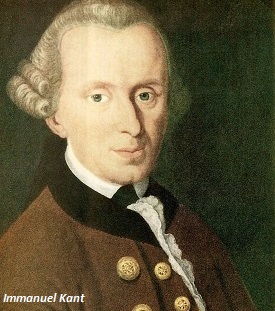
Pierre de Sonnerate, a French naturalist and traveler, believed that all knowledge came from India, which is the cradle of civilizations.
Immanuel Kant (a great philosopher of Germany) recognized the greatness of ancient Indian culture and civilization. He acknowledged that Indian religious thoughts were free of rigidity and intolerance.
Immanuel Kant wrote (about India), "Their religion has a great purity ... (and) one can find traces of pure concept of divinity which cannot easily be found elsewhere".
Writing of Ancient Indian History
During the 4th century B. C., Kautilya in his book Arthashastra advises the king to dedicate some time for hearing the narrations of history.
History was conferred holiness equal to pious Veda, Atharvanaveda, Brahmanas, and Upanishads. The Itihas-Purana is one of the branches of knowledge of history.
Puranas
There are 18 main Puranas and 18 subsidiary Puranas.
-
The subject matters of history are (As per the Puranas),
Sarga (evolution of the Universe)
Pratisarga (involution of the Universe)
Manvantantar (recurring of the Time)
Vamsa (genealogical list of the kings and sages)
Vamsanucharita (life stories of some selected characters)
The reign of Parikshit (the grandson of Arjuna) was considered as a benchmark for the reference of the royal genealogies given in the Puranas.
In Puranas, all the earlier dynasties and kings prior to reign of Parikshit, have been mentioned in past tense. While the latter kings and dynasties have been narrated in a future tense.
This may be due to the fact that the Puranas were completed during the reign of Parikshit. As mentioned in the Puranas, the coronation of Parikshit marks the beginning of Kali Age.
In the context of the Puranas, it is observed that in ancient India, ltihas (History) was looked upon as a means to illuminate the present and future in the light of the past.
The purpose of history was to understand and inculcate a sense of duty and sacrifice by individuals to their families, by the families to their clans, by the clans to their villages, by the villages to Janapada and Rashtra, and ultimately to the whole humanity.
During the ancient time, history was treated as a powerful vehicle of the awakening of cultural and social consciousness. Therefore, the narrations of Puranas were a compulsory part of the annual ritual in every village and town (especially) during the rainy season and at the time of festivals. F. E. Pargitar and H. C. Raychaudhury have attempted to write history on the basis of genealogies of various dynasties mentioned in the Puranas.
Rajatarangini written by Kalhana is another work of history, which enjoys the great respect among the historians for its approach and historical content.
Early Foreigners
Important Greek writers were Herodotus, Nearchus, Megasthenese, Plutarch, Arrian, Strabo, Pliny, Elder, and Ptolemy.
The contribution of Greek writers in the history of ancient India was restricted to the northwestern region of India.
Megasthenese
During 324-300 B.C., Megasthenese (a Greek ambassador) visited in the court of Chandragupta Maurya.
Megasthenese in his famous book Indica gave detailed account of society and polity of the contemporary India, but unfortunately, it is no longer available to us.
Megasthenese affirms about the existence of an array of 153 kings whose reigns had covered the time period of about 6,053 years up till then.
The writings of Megasthenese, further, had been a source of the information about the ancient India for most of the Greeks writes, including Diodorous, Strabo, and Arrian.
Al-Biruni
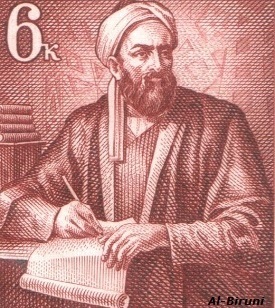
Al-Biruni was born in A.D. 913 in the central part of Asia. He was contemporary of Mahmud of Ghazi and accompanied Mahmud when he conquered part of central Asia; likewise, he came in contact of the Indian culture.
Al-Biruni learned the Sanskrit language to gain a precise knowledge of Indian society. He made multidimensional observations ranging from philosophy, religion, culture, and society to science, literature, art, and medicine.
The work of Al-Biruni is free from all religious or racial biases.
Al-Biruni died in Ghazni (Afghanistan) in A.D. 1048.
Christian Missionaries and Enlightenment
The contribution of Christian Missionaries during the 17th and 18th centuries was mainly affected by the religious and political movements in Europe.
A large number of works were produced on India by the Christian Missionaries, but their writings can hardly be said to be fair. In fact, their interest in learning and writing about India was to show faults in Indian society and culture driven by zealous activities.
A large number of works were produced by the Christian Missionaries on India, but none of them stands near to the works of AI-Biruni.
Some other group of European Scholars, including John Holwell, Nanthaniel Halhed, and Alexander Dow had written about Indian history and culture proving the pre-eminence of the Indian civilization in the ancient world.
Holwell had written that Hindu texts contained a higher revelation than the Christian one.
Halhed had discussed the vast periods of time of human history assigned to four Yugas and concluded that human reason can no more reconcile to itself the idea of Patriarchal longevity of a few thousand years for the entire span of human race.
Imperialist Historiography
The Asiatic Society of Bengal established in 1784 that contributed towards the writing of the Indian History.
Imperialist Writings were mostly reflecting the contemporary debate on religious faith and nationality and also their interests in enlarging the European colonies for economic exploitation.
Imperialist Intellectuals
- Leading imperialist intellectuals of the 19th century were −
- Max Muller,
- J.S. Mill,
- William Jones,
- Karl-Marx, and
- F. W. Hegel.
The works of a few intellectuals have been described below −
Max Muller
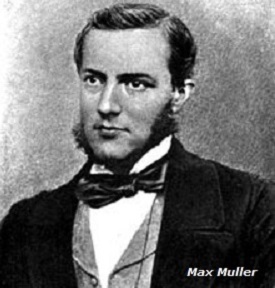
Friedrich Max Muller is considered as one of the most respected Indologists of the nineteenth century. He was a German, but lived in England. On the financial support of the British East India Company, he undertook massive jobs of translation and interpretation of the Indian religious texts in English.
He attained the best achievement of getting translated a huge mass of Sanskrit texts into English, but his approach and intention were never free from the prejudice.
Muller was inspired by his religious belief and political requirements that affected his entire approach of unbiased writing and interpretation of Indian history.
The guiding principle under which William Jones, Max Muller, and Vincent Smith wrote Indian history, was to settle all history within the period up to 4,000 B.C.
In 1868, Max Muller wrote to the Duke of Argyll The ancient religion of India is doomed, and if Christianity does not step in, whose fault will it be?"
The majority of works done on Indian history during the 18th and 19th centuries were guided by the preconditions imposed by the belief in the Genesis and to reject all the writing that were projecting India's past in terms of great civilization and Indian philosophy and thoughts indicating great antiquity for the origins of universe and human beings.
The major factor that is responsible for the distortion of the ancient Indian history was the British imperial interests in India. They were worried about the fact that popularity of the Indian text among British civilians might develop an inferiority complex in them.
James Mill
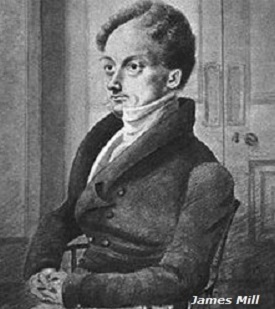
-
Between 1806 and 1818, James Mill wrote six volumes on the history of India without ever visiting India or knowing any Indian language. He divided Indian history into three periods i.e.
Hindu Period,
Muslim Period, and
British Period (all he did without any logic and justification).
Mill presented an extremely demeaning picture of Hindu periods. He condemned every institution, idea, and action of the Hindu period and held Hindus responsible for all the ills of the country.
Mills book was introduced as a text book in the Harley bury school in England, which was established to educate the young Englishmen coming to India as administrators and civil servants.
James Mill, his son John Stuart Mill, and his disciple Thomas Macauley played a very important role in shaping the imperialist policy in India and the future of Indian education in the core of which was the distorted history of ancient India.
V.A. Smith, an officer serving the British Government in India, prepared the text book called Early History of India in 1904. He emphasized the role of foreigners in ancient India. Alexander's invasion accounted for almost one-third of his book.
Smith's racial superiority is clear with his sentence i.e. "The triumphant progress of Alexander from the Himalayas to the sea demonstrated the inherent weakness of the greatest Asiatic armies when confronted with European skill and discipline".
Smith had given the impression that Alexander had conquered the whole of India from the Himalayas to seas while the fact is that, he only touched the northwestern borders of India.
Smith had presented India as a land of dictatorship, which did not experience political unity until the establishment of the British rule.
The whole approach of Imperial historians was to give such interpretations of Indian history to denigrate Indian character and achievements, and justify the colonial rule.
Vincent Arthur Smith (1843-1920) prepared the first systematic history of ancient India that published in 1904.
On the basis of the Bible story of Creation Bishop Usher had calculated that the whole universe was created at 9.00 a.m. on 23rd October 4004 B.C. and the Great Flood took place in 2,349 B.C.
In the light of Indian concept, the age of the Earth is several hundred million years that the Bible stories of creation appears to be wrong and threatened the very foundation of the faith.
With the object to promote the Sanskrit learning among the English, Boden Professorships of Sanskrit at Oxford University was endowed by Colonel Boden. This was precisely for enabling his countrymen to proceed in the conversion of the natives of India to the Christian religion.
Prizes were offered to the literary works for refutation of the Hindu religious systems and undermining Indian tradition.
Historiography: Nationalist Approach
In the late 19th century, there were some of the eminent Indian scholars who studied and researched Indian History with Indian point of view.
Nationalist Intellectuals
-
Some of the nationalist scholars who understood and interpreted Indian History with Indian perspective are like −
Rajendra Lal Mitra,
R.G. Bhandarkar,
R. C. Majumdar,
V. K. Rajwade etc.
Bhandarkar and Rajwade worked on the history of Maharashtra region and reconstructed the social, political, and economic history of the area.
D. R. Bhandarkar, H. C. Raychaudhary, R. C. Majumdar, P. V. Kane, A. S. Altekar, K. P. Jayaswal, K. A. Nilakant Sastri, T. V. Mahalingam, H. C. Ray, and R. K. Mookerji were some other Indian historians who attempted to describe Indian History (according to Indian point of view).
D. R. Bhandarkar (1875-1950), in his books, on Ashoka and on Ancient Indian Polity helped in clearing many myths created by the imperialist historians.
K. P. Jayaswal (1881- 1937), in his book, Hindu Polity published in 1924, effectively knocked down the myth that Indians had no political ideas and institutions.
Jayaswal revealed (on the basis of his study of literary and epigraphical sources) that India was not a despotic country as propagated by the imperialist historians, but rather India had the tradition of republics right from Rig Vedic times.
K. P. Jayaswals book Hindu Polity is considered as one of the most important books ever written on ancient Indian history.
H. C. Raychaudhury (1892-1957) reconstructed the history of ancient India from the time of Mahabharata War to the time of Gupta Empire and practically cleared the clouds created by V. A. Smith. The title of his book is Political History of Ancient India.
R. C. Majumdar wrote a number of books covering the time period from ancient India to the freedom struggle.
Majumdar is considered as a leader among Indian historians. The most outstanding achievement under his editorship is the publication of History and Culture of the Indian People in eleven volumes.
K. A. Nilakant Sastri (1892-1975) in his books A History of Ancient India and A History of South India contributed immensely towards the understanding of South Indian history.
R. K. Mookerji (1886-1964) in his books including Hindu Civilization, Chandragupta Maurya, Ashoka, and Fundamental Unity of India, expressed the cultural, economic, and political history of India in simple terms and made it accessible even to a lay reader.
P. V. Kanes (a great Sanskritist, 1880-1972) work i.e. the History of Dharmasastra in five volumes is considered as an encyclopedia of social, religious, and political laws and customs.
Marxist School of History
The Marxist school of historiography was significant in the second half of the 20th century. They believe in universal laws and stages of history.
Stages of History

-
The Marxist, further, believe that all the societies pass through at least five stages of history. These stages were defined by Karl Marx and F. Engels as −
Primitive Communism
Slavery
Feudalism
Capitalism
Communism
The stages of history proposed by Marx and Engels were based on their understanding of European history. They clearly acknowledged their intellectual debt to F. W. Hegel and Lewis Henry Morgan.
G. W. F. Hegel (1770-1831) was a great western philosopher. He made no attempt to learn Sanskrit or any other Indian language. His writings on Indian history and philosophy were based mainly on the writings of William Jones, James Mill, and other British writers whose approach to ancient Indian history has already been discussed above; so, the results were really disastrous.
Hegel reluctantly accepted that India had a philosophical system and its history had great antiquity and he explicitly considered Indian system to be inferior to that of the Greeks and the Romans.
Marx knowledge about India was not really free from racial considerations. He took his lead from Hegel.
Marx was a great supporter of British rule in India and dismissed India as a backward and uncivilized nation with no history.
The Hegelian and Marxian approach to Indian history by and large remained dormant for a long time. It was largely non-existent during the British rule in India.
The Marxist school of historiography became one of the most influential and dominant schools after the independence of India.
Marx held that all that is good in Indian civilization is the contribution of conquerors. Therefore, according to this school, the Kushana period is the golden period of Indian history and not the Satavahanas or Guptas.
According to Marxist School of History, the period from the Gupta's to the conquest of Muslims in the 12th century A.D. has been termed as the "Period of Feudalism" i.e. "Dark Age" during which everything degenerated.
D. D. Kosambi was the first among the pioneers of the Marxist school of thought.
D. R. Chanana, R. S. Sharma, Romila Thapar, Irfan Habib, Bipan Chandra, and Satish Chandra are some of the leading Marxist historians of India.
In the Marxist scheme of history, the Soviet Union was the ideal state and Marxism is an ideal philosophy and polity.
Ancient Indian History - Sources
Literary and Archaeological records are the two main categories that give evidences of Ancient Indian History.
The literary source includes literature of Vedic, Sanskrit, Pali, Prakrit, and other literature along with other foreign accounts.
The archaeological source includes epigraphic, numismatic, and other architectural remains.
The archaeological explorations and excavations have opened the great landscapes of new information.
Indian Literary Sources
The ancient Indian literature is mostly religious in nature.
The Puranic and Epic literature are considered as history by Indians, but it contains no definite dates for events and kingdoms.
The effort of history writing was shown by a large number of inscriptions, coins, and local chronicles. The principles of history are preserved in the Puranas and Epics.
The Puranas and epics narrate the genealogies of kings and their achievements. But they are not arranged in a chronological order.
The Vedic literature contains mainly the four Vedas i.e. Rigveda, Yajurveda, Samaveda, and Atharvanaveda.
The Vedic literature is in a different language called as the Vedic language. Its vocabulary contains a wide range of meaning and is different in grammatical usages. It has a definite mode of pronunciation in which emphasis changes the meaning entirely.
The Vedas give reliable information about the culture and civilization of the Vedic period, but do not reveal the political history.
-
Six Vedangas are the important limbs of Vedas. They were evolved for the proper understanding of the Vedas. The Vedangas are −
Siksha (Phonetics)
Kalpa (Rituals)
Vyakarna (Grammar)
Nirukta (Etymology)
Chhanda (Metrics) and
Jyotisha (Astronomy).
Vedanga has been written in the precepts (sutra) form. This is a very precise and exact form of expression in prose, which was developed by the scholars of ancient India.
Ashtadhyayi (eight chapters), written by Panini, is a book on grammar that gives excellent information on the art of writing in sutra (precepts).
The later Vedic literature includes the Brahmanas, the Aranyakas, and the Upanishads.
Brahmanas gives a description of Vedic rituals.
Aranyakas and Upanishads give speeches on different spiritual and philosophical problems.
Puranas, which are 18 in numbers give mainly historical accounts.
The Ramayana and the Mahabharata are epics of great historical importance.
The Jain and the Buddhist literature had been written in Prakrit and Pali languages.
Early Jain literature is mostly written in Prakrit language.
Prakrit language was a form of Sanskrit language.
Pali language was a form of Prakrit language which was used in Magadha.
Most of the early Buddhist literature is written in Pali language.
Pali language reached to Sri Lanka through some of the Buddhist monks where it is a living language.
Ashokan edicts had been written in Pali language.
Mahavira and Buddha are considered as the historical personalities (equivalent to the God). They have created Jain and Buddhist religious ideology respectively.
Ancient Books
The Buddhist books are called as Jataka stories. They have been given some historical importance because they are related with the previous births of the Buddha. There are more than 550 such stories.
The historic information mentioned in Jaina literature also help us in reconstructing the history of different regions of India.
The Dharmasutras and the Smritis were the rules and regulations for the general public and the rulers. It can be equated with the constitution and the law books of the modern concept of polity and society. For example, Manusmriti.
Dharmashastras were compiled between 600 and 200 B.C.
Arthashastra is a book on statecraft written by Kautilya during the Maurya period. The book is divided into 15 parts dealing with different subject matters related to polity, economy, and society.
The final version of Arthashastra was written in the 4th century B.C.
Kautilya acknowledges his debt to his predecessors in his book, which shows that there was a tradition of writing on and teaching of statecrafts.
Mudrarakshasha is a play written by Visakha datta. It describes the society and culture of that period.
Malavikagnimitram written by Kalidasa gives information of the reign of Pusyamitra Sunga dynasty.
Bhasa and Sudraka are other poets who have written plays based on historical events.
Harshacharita, written by Banabhatta, throws light on many historical facts about which we could not have known otherwise.
Vakpati wrote Gaudavaho, based on the exploits of Yasovarman of Kanauj.
Vikramankadevacharita, written by Bilhana, describes the victories of the later Chalukya king Vikramaditya.
-
Some of the prominent biographical works, which are based on the lives of the kings are −
Kumarapalacharita of Jayasimha,
Kumarapalacharita or Dvayashraya Mahakavya of Hemachandra,
Hammirakavya of Nayachandra
Navasahasankacharita of Padmagupta
Bhojaprabandha of Billal
Priihvirajacharit of Chandbardai
Rajatarangini, written by Kalhana, is the best form of history writing valued by modern historians. His critical method of historical research and impartial treatment of the historical facts have earned him a great respect among the modern historians.
The Sangam literature is in the form of short and long poems consisting 30,000 lines of poetry, which arranged in two main groups i.e. Patinenkilkanakku and the Pattupattu. It describes many kings and dynasties of South India.
The Sangam was the poetic compilation by a group of poets of different times mainly supported by chiefs and kings.
The Sangam literature was composed by a large number of poets in praise of their kings. Some kings and events mentioned are also supported by the inscriptions.
The Sangam literature generally describes events up to the 4th century A.D.
Foreign Accounts
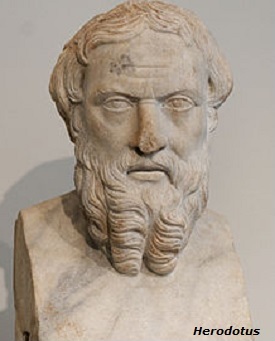
Herodotus was dependent upon the Persian sources for his information about India.
Herodotus in his book Histories (written in many volumes) describes about the Indo-Persian relations.
A detailed account of the invasion of India by Alexander was written by Arrian.
The Greek kings send their ambassadors to Pataliputra. Megasthenes, Deimachus, and Dionysius were some of them.
Megasthenes came in the court of Chandragupta Maurya. He had written about the Indian society and culture in his book called as Indica. Though the original work has been lost, but it had been frequently quoted in the works of later writers.
A book Periplus of the Erythrean Sea written by an anonymous Greek author who settled in Egypt on the basis of his personal voyage of Indian coast in about A. D. 80 gives valuable information about the Indian coasts.
In the second century A. D., Ptolemy had written a geographical treatise on India.
The Greek writing about India, however, is based on secondary sources. They were ignorant of the language and the customs of the country and hence their information is full of errors and contradictions.
-
Many Chinese travelers visited India as Buddhist pilgrims from time to time; three important pilgrims were −
Fa-Hien (Faxian) − visited India in 5th century A.D.
Hiuen-Tsang (Xuanzang) − visited India in 7th century and
I-Tsing (Yijing) − visited India in 7th century.
Hiuen-Tsang had given valuable account about Harshavardhana and some other contemporary kings of Northern India.
Fa-Hien and Hiuen-Tsang traveled many parts of the country and they have given an exaggerated account of Buddhism during the period of their visit.
Hiuen-Tsang mentioned Harsha as a follower of Buddhism while in his epigraphic records, Harsha mentions himself as a devotee of Siva. Such contradictions may be considered due to the fact of multi-religious nature of Indian rulers, which might confuse a foreigner.
AI-Biruni gave important information about India. He was Arab scholar and contemporary of Mahmud of Ghazni.
AI-Biruni studied Sanskrit and acquired knowledge of Indian society and culture through literature. Therefore, his observations are based on his knowledge about Indian society and culture, but he did not give any political information of his times.
Archaeological Sources
The archaeological sources played an important role in constructing or/and reconstructing the history of a region.
The archaeological source of Indian history is only about two centuries old.
The archaeological source enhanced our knowledge about our past and also provided important materials, which we could not have been obtained otherwise.
Up to 1920, Indian civilization was considered to have begun about 6th century B.C. However, the excavations at Mohenjodaro, Kalibangan, and Harappa prove its antiquity to be of 5,000 B.C.
Prehistoric artifacts found in the excavations have shown that human activities had started here as early as about two million years ago.
Epigraphy and Numismatics are the important branches of the study of history, which has greatly enhanced the knowledge of India's past.
Epigraphy is the study of inscriptions and Numismatic is the study of coins, medals, or paper money.

Coins are an important numismatic source that tells us about the Indo-Greek, Saka-Parthian, and Kushana Kings.
Inscriptions of Ashoka and Samudragupta provide valuable information about social and political status of the people of that period.
The study of these inscriptions reveals the world about Ashoka's views on dharma (religion) and conquests of Samudragupta.
Archaeological Monuments
The temples and sculptures display an architectural and artistic history of the Indians from the Gupta period up-to recent times.
During the Gupta period, the large caves i.e. Chaityas and Viharas were excavated in the hills of Western India.
The Kailasa Temple of Ellora and Rathas at Mahabalipuram have been carved out of rocks from outside.
The excavations of the cities of Mohenjodaro and Harappa prove the antiquity of Indian culture and civilization, which are more than two thousand years old.
The historic sites such as Kalibangan, Lothal, Dholavira, and Rakhigarhi are the contemporary of Mohenjodaro and Harappa civilizations.
The Harappan civilizations cover the area of Gujarat, Maharashtra, Haryana, Punjab, Rajasthan, and Uttar Pradesh (in India).
The Dark Age of Indian history was the period between 1500 and 600 B.C. This is known as Dark Age because not much is known about this period.
The archaeological discoveries of Black-and-Red Ware, Painted Grey Ware, Malwa, and Jorwe cultures have filled the chronological gaps as well as covered the geographical extent.
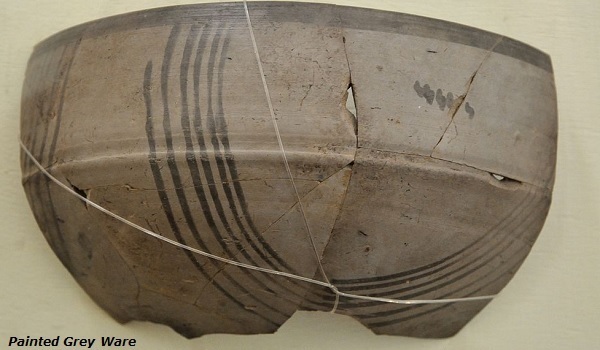
-
Some of the important points that Archaeological discoveries display are −
Indians had domesticated sheep and goat and started agriculture about 8,000 years ago and Iron metal came in regular use about 1,600 B.C.
The tradition of rock paintings in India is proved to be more than 12 thousand years old.
Tools and remains found in the Kashmir and Narmada valleys show that the human activities started in the subcontinent as early as two million years ago.
Inscriptions
The inscriptions are the most important and reliable sources of Indian history.
Inscriptions are the contemporary documents those are free from later interpolations as it is impossible to add something to it at a later period. Therefore, it comes in the original form as it was composed in and engraved.
The manuscripts were written on soft materials like birch bark, palm leaf, paper etc. They became fragile in a course of time and were frequently required to be copied and at the time of copying, some irrelevant additions were made and some errors tend to creep in. Therefore, they are not considered as a reliable source of information about history.
The script of the inscriptions also helps the historian in many ways.
The Harappan seals depict the earliest system of writings, however, they could not be decoded yet.
The Ashokan inscriptions are claimed to be the earliest one of the systems of writing. Ashokas inscriptions are found written in four scripts.
Kharoshthi script was used in Pakistan region, which is written from right to left and is evolved on the Varnamala (alphabet) system of the Indian languages.
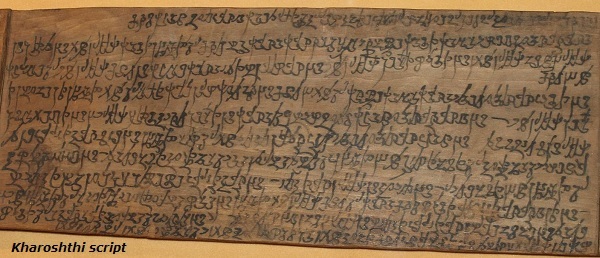
Brahmi script was used for the rest of the empire from Kalsi in the north in Uttaranchal up to Mysore in the south.
Palaeography is the study of development of the scripts.
The epigraphic studies started in the late 18th century.
Brahmi script was adopted by the rulers after Ashoka and continued for succeeding centuries.
The Brahmi script kept modifying century after century, which led to the development of most of the scripts of India, including Tamil, Telugu, Kannada, and Malayalam in the south and Nagari, Gujarati, Bangla, etc. in the north.
The modifications in the letters of the script have made it possible to ascertain the time period in which the inscription was written.
In 1837, James Prinsep completed the chart of Ashokan alphabets.
The inscriptions of Ashoka had been recorded in different years of his reign and are known as edicts because they are in the form of the king's order or desire
The edicts of Ashoka prove that he (Ashoka) was a benevolent king concerned with the welfare of not only his subjects, but also of the whole humanity.
Inscriptions of the Indo-Greeks, Saka-kshatrapas and Kushanas adopt Indian names after two or three generations. These inscriptions illustrate that they were also engaged in social and religious welfare activities like any other Indian kings.
Junagarh Rock inscription of Rudradaman was written in the mid of 2nd century A.D. It was an early example of an inscription written in Sanskrit; however, Sanskrit became prominent since the Gupta period.
Pillar inscription of Allahabad describes the achievements of Samudragupta.
The epigraphs of the Gupta period started trends of giving the genealogy of kings with the account of their conquests and achievements. This became a trend of the subsequent dynasties to give a list of their predecessors and mention mythology of their origins.
The Aihole inscription of the Chalukya king Pulkeshin-II describes a dynastic genealogy and achievements.
The Gwalior inscription of Bhoja also gives a full account of his predecessors and their achievements.
Numismatics
Numismatics is considered as the second most important source for reconstructing the history of India after inscriptions.
Coins are mostly found in the hoards while digging field or constructing a building, making a road, etc.
Coins found in systematic excavations are less in number, but are very valuable because their chronology and cultural context can be fixed precisely.
Earliest coins are known as the punch-marked coins. They are made of either silver or copper. In addition to this, some gold punch-marked coins were also found, but they are very rare and their authenticity is doubtful.
The Indo-Greek coins were also made up of silver and copper and rarely in gold.
The Kushanas issued their coins mostly in gold and copper, rarely in silver.
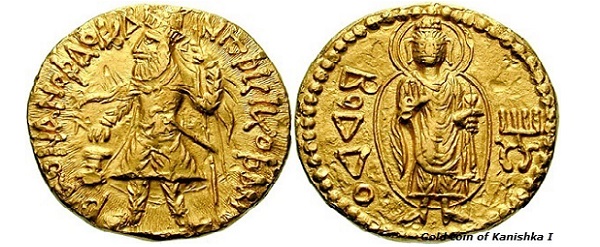
The Guptas issued their coins mostly in gold and silver but the gold coins are numerous.
The punch-marked coins that bear (only) symbols on them are the earliest coins of India. Each symbol is punched separately, which sometimes overlap the other.
Punch-marked coins have been found throughout the country, starting from Taxila to Magadha to Mysore or even further south. They do not bear any inscription or legend on them.
The Indo-Greek coins depict beautiful artistic features on them. The portrait or bust of the king on the observe side appear to be real portraits and on the reverse, some deity is depicted.
The information about Saka-Parthians kings also came through their coins.
The Kushanas issued mostly gold coins and numerous copper coins, which are found in most parts of north India up to Bihar.
The Vima Kadphises coins bear the picture of Lord Siva standing beside a bull illustrate the Indian influence from the very beginning.
The king calls himself Mahesvara i.e. devotee of Siva in the depiction on coins. Kanishka, Huvishka, and Vasudeva etc. all have this depiction on their coins.
Kushana coins depicted many Indian gods and goddesses along with many Persian and Greek deities.
The Guptas had succeeded Kushanas in the tradition of imprinting coins. They completely had been Indianized their coinage.
The kings are portrayed engaged in activities like hunting a lion or rhinoceros, holding a bow or battle-axes, playing a musical instrument, or performing Ashvamedha yajna.
Geographical Background of Indian History
-
Indian subcontinent comprises six countries (as shown in the image given below) namely −
Afghanistan,
Pakistan,
Nepal,
India,
Bhutan, and
Bangladesh.
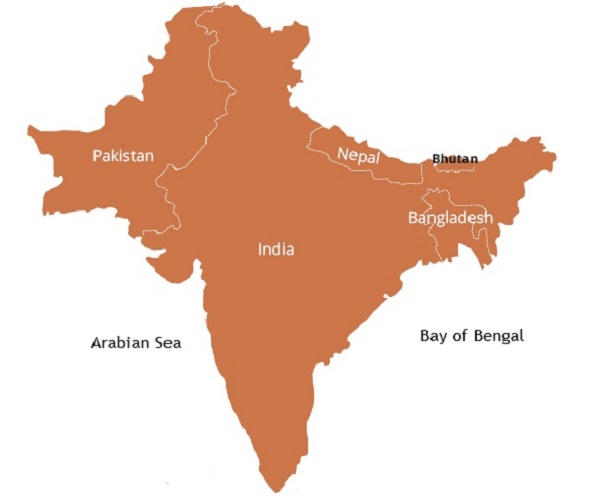
The whole subcontinent was known as Bharatavarsha or Hindustan in ancient time.
The word Hindustan is derived from the name of the river Sindhu, pronounced by the westerners as Hindu or Indu. The name India is thus derived.
The name India is called as Bharata in the Indian Constitution.
Geographical Division
-
The geographical boundaries of Bharatavarsha are demarcated by −
The Himalayas in the north;
The Pamir plateau and Sulaiman Kirthar ranges in the western and north-western side;
The Bay of Bengal in the east and Arabian Sea in the west; and
The Indian Ocean in the south.
-
The physiography of the subcontinent can be studied under the three following parts −
The Himalayas,
The Indo-Gangetic-Brahmaputra plain, and
The Deccan plateau.
The Himalayas
The Himalaya is about 2,400 Km long (from east to west) and about 250 to 320 km wide (north to south).
The Himalaya touches Afghanistan in the west to Myanmar in the east.
There are about 114 peaks (of Himalayan Mountain Range), which are more than 20,000 feet high.
-
Some of the highest peaks (of the Himalaya) are −
Gauri Shankar or Mount Everest (it is the highest mountain peak in the world),
Kanchanjanga,
Dhaulagiri,
Nanga Parvat, and
Nanda Devi.
The Himalayas form a barrier against the foreign invasions from the north.
The Khyber and Bolan passes were well known since the ancient time. Khyber Pass was popular as the gateway to India.
The Indo-Gangetic-Brahmaputra Plain
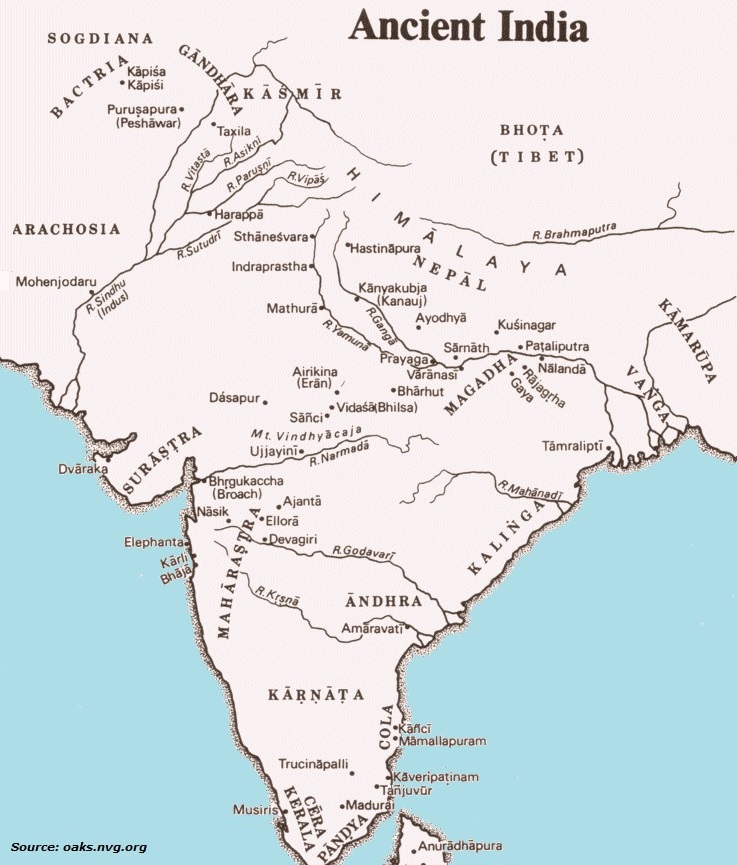
The great plain lies to the south of the Himalayas. It covers more than 255 million hectares fertile plain area.
The great plain is formed by the rivers originating from Himalaya.
The Indus, the Ganga, and the Brahmaputra are the three major river systems.
The ancient River Saraswati and its tributaries used to flow through the northern plain area. The stream of Saraswati had flown through the states of Haryana, Punjab, and Rajasthan.
-
The Indus River has five tributaries (flowing from east to west), namely −
The Sutlej (Satudri),
The Beas (Vipasa),
The Ravi (Parushni),
The Chenab (Asikni), and
The Jhelum (Vitesta).
The river Sutlej was (once) a tributary of the lost river Saraswati, but changed its course.
The Brahmaputra originating from the eastern part of the Lake Manasarovar in the Kailasa Range (of Himalaya) flows eastward through the plateau of Tibet. Before entering India, its name is Tsangpo.
The Brahmaputra enters in India and from here, it is called as the Brahmaputra. It passes through Assam and Bengal and joins the eastern most mouth of the Ganga i.e., Padma.
Originating from the Gangotri glacier, the River Ganga flows through the India and Bangladesh and finally debouches into the Bay of Bengal. It is the most sacred river of India.
The Deccan Plateau
The surface of the Deccan plateau (which is located in the southern part of the subcontinent) is tilted from west to east.
On the western side, a range of high cliffs is located (in the direction of) south to north leaving a narrow strip of plain between it and the sea. It is known as the Western Ghats.
The Eastern Ghats (which is situated along the eastern coast) is divided into groups of low hills. It has several gaps through which the peninsular rivers join the Bay of Bengal.
Central Indian Plateau
The Central Indian plateau stretches from Gujarat in the west to Chhota Nagpur in the east.
Thar, the Great Indian Desert lies to the north-west of the Aravalli range.
Central Indian plateau consists of Malwa plateau, Bundelkhand, and Baghelkhand.
The Coastal Regions
The western coastal plain stretches from the Gulf of Cambay in the north to Kerala in the south.
The northern part of the western coast is called the Konkan coast. And, the southern one is called the Malabar Coast.
Some of the ideal harbors are located in the Konkan and Malabar region.
The eastern coast has a few natural harbor. The natural harbors provide an opportunity for maritime activities during the historical period, which lead to more vigorous and fruitful contacts with the south-east Asian countries.
The southern tip of the peninsula is known as Cape Comorin.
Climate
The Indian subcontinent is located largely in the tropical zone and has a fairly warm climate throughout the year.
The Indian subcontinent has three seasons namely, winter, summer, and rainy.
March to June is the hot season. The temperature goes up to 48° C or more in some regions. It follows the rainy season from July to October.
The south-west monsoon brings rain in the country.
The regions of Haryana, Rajasthan, and some parts of Sind and Gujarat receive less rainfall, but during the ancient time, it received higher rainfall and created an ideal condition for the development of the Harappan civilization.
Geography in Ancient Literature
The ancient vast subcontinent of India was popular as Bharatavarsha (the land of Bharata), which was the part of southern Jambudvipa.
Geography of India in Indian Literature
The Geography of India that played a significant role in shaping ancient Indian history has been described much expressively in ancient Indian literature.
The term 'India' was first used by the Achaemenid Persians to the region watered by the River Sindhu.
The Sapta-Sindhu, referring to the region of the seven rivers of the Saraswati.
Zend-Avesta (which is the sacred book of Parasis), uses the term Sapta-Sindhu for India.
The Greeks uses the term Indos for the river Sindhu subsequently borrowed the term from the Persians.
Herodotus, the famous Greek historians, used the term 'Indos' to the kshatrapy of the Persian Empire. Gradually, Greek and Roman writers begin to use this term for the whole country.
Chinese used the term Tien-Chu or Chuantu for India during the first century A.D.
Hiuen-Tsang promotes the term Yin-Tu to refer India.
-
Following are the distorted forms of Sindhu −
Hindu in Persian
Indos in Greek,
Hoddu in Hebrew,
Indus in Latin, and
Tien-chu in Chinese.
I-Tsing, a Chinese scholar says − "Hindu is the name used only by the northern tribes and the people of India themselves do not know it".
I-Tsing mentioned other terms such as Arya-desa and Brahmarashtra for India.
In the sixth century B.C., for the first time, Panini mentioned the term Bharata for a region, which was only one out of 22 Janapadas (specified from Kamboja to Magadha in Northern India).
Buddhist literature speaks of seven Bharata regions (Sapta-Bharatas) corresponding to the ancient Sapta-Sindhu.
During 150 B.C. (at the time of Patanjali), a region was named as Aryavarta. It was the region in the northern part of India lying between the Himalayas and the Pariyatraka or the western part of the Vindhyas and on the west, it was bounded by the Aravalli and on the east by the Kalakavana or the Rajmahal Hills.
Influences of Geography on Indian History
The geographical features of a region influence peoples activity and his interactions with nature and other groups in different ways.
The mountains, rivers, oceans form the natural boundaries of a geographical region. A person develops his living habits and mode of thinking as per his surroundings.
The Indian subcontinent is a vast geographical region with well-defined natural barriers in the form of the Himalayas in the north and coastal boundaries on the three remaining sides.
Pilgrimage and places of worship are distributed throughout the country.
Cultural bonds gave a sense of unity and nationality to all Indians
There are several regions, which have a distinct sense of regional spirit and cultural traits.
Larger kingdoms and empires rose from these units and weakened, in due course, giving way to another unit to come up.
The Chakravarti was a concept of conquest that aspires the kings to grow their kingdom and to rule the whole country.
The early conquerors from the north-west, such as Indo-Greeks, Saka-Pallavas, Kushanas, etc., established the kingdoms and empires in the western part of India, but never shown their eagerness to adopt Indian ideas of polity and willingness to assimilate themselves in the main stream of the Indian society.
The old kingdoms of Kosala, Magadha, Gauda, Vanga, Avanti, Lat, and Saurashtra in the north, and Kalinga, Andhra, Maharashtra, Kamataka, Chera, Chola, and Pandya in the southern part had ruled for long period human history and seem to possess eternal lives.
People living along coast line were experts in maritime activities. They developed trade relations with other countries as well.
Cholas dynasty, in the south, had attempted to conquer lands beyond the sea.
Although Indians had spread in many parts of the known world, but in the South East Asia, they developed a lasting cultural influence in the countries like Vietnam, Indonesia, Cambodia, etc. It was due to individual efforts by traders and princes and not by any State.
The Indian traders not only gave their religion and philosophy to the people of other countries (mentioned in the above point), but also assimilated themselves in their religion and philosophy as well.
The geographical features of India, therefore, not only shaped its history and culture, but also the mind and thoughts of the people.
Ancient Indian History - Stone Age Cultures
On the basis of the scientific study, geologists fix age of the earth as 4,600 million years.
The fossils of the earliest humans found in Africa were about 4.2 million years old.
The earliest human beings were shorter in height and had a smaller brain.
About 42-lakhs years ago, Human being evolves and the present form reached about 50,000 years ago.
The fossils found in Africa, China, Java, Sumatra, and southern Europe portray the various stages and periods of human development.
In India, the only hominid fossil found from Hathnaura in the Narmada Valley.
Earliest Palaeolithic Tools
The stage of human development started at the time when people begin the use of tools for their aid. It was the time that laid the foundation of science and the uses of machines.
About 2.6 million years ago, human beings started the regular use of tools in east Africa.
In Indonesia, several hominid fossils have recently been dated between 1.8 and 1.6 million years.
In China, the early stone tools are associated with human fossils dated between 1.7 and 1.9 million years.
In India, no human fossils have been found associated with Stone Age tools.
The various strata of the Sivalik hills containing stone tools have been dated between 2 to 1.2 million years.
The archaeological site of Bori in Pune district of Maharashtra is about 1.38 million years old. It gives the scientific record for the early stone tools in India.
The early human settlement in India is contemporary to the Asian countries, but it is of the later period than that in the African region.
Palaeolithic Cultures
-
Based on tool technology, the Palaeolithic Age in India is divided into the following three phases −
Lower Palaeolithic Hand-axe and cleaver industries;
Middle Palaeolithic Tools made on flakes; and
Upper Palaeolithic Tools made on flakes and blades.
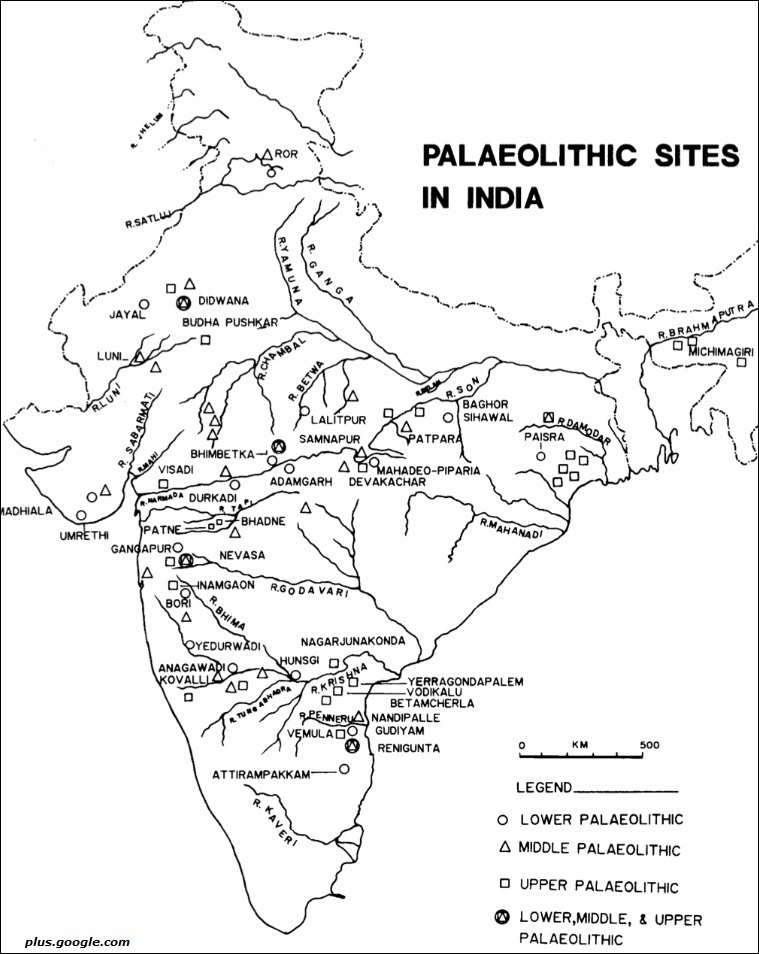
Lower Palaeolithic Culture
The time period of Lower Palaeolithic culture was marked between 600,000 and 60,000 B.C.
The main tool types of this era were hand axes and cleavers, along with chopper-chopping tools. These were made on cores as well as flakes.
The raw materials used for making the stone tools were largely of different kinds of stones, including quartzite, chert, and sometimes even quartz and basalt, etc.
-
Following are the major types of sites of the Lower Palaeolithic culture −
Habitation sites (either under rock-shelters or in the open);
Factory sites associated with sources of raw materials;
Sites that combine elements of both these functions; and
Open-air sites (any of the above categories).
The Lower Palaeolithic tools have been abundantly found throughout the Indian subcontinent, except the plains of the Indus, Saraswati, Brahmaputra, and Ganga where raw material in the form of stone is not available.
-
Following are the important sites of Lower Palaeolithic cultures −
Pahalgam in Kashmir,
Belan valley in Allahabad district (Uttar Pradesh),
Bhimbetka and Adamgarh in Hoshangabad district (Madhya Pradesh),
16 R and Singi Talav in Nagaur district (Rajasthan),
Nevasa in Ahmadnagar district (Maharashtra),
Hunsgi in Gulburga district (in Kanlataka), and
Attirampakkam (Tamil Nadu).
-
Some other sites also have been found in −
Shivalik range of Kashmir, Himachal Pradesh, and Punjab;
Belan valley in Uttar Pradesh;
Berach basin and the hilly area of Rajasthan; and
Narmada and Sone valleys in Madhya Pradesh;
Malprabha and Ghatprabha basins in Karnataka;
Chhota Nagpur plateau and several areas of Maharashtra;
Some areas near Chennai in Tamil Nadu; and
Some areas of Orissa, West Bengal, and Madhya Pradesh.
Middle Paleolithic Culture
The period between 150,000 B.C. and 40,000 B.C. is marked as the middle Palaeolithic culture.
-
The tools of middle Palaeolithic were characterized as −
The flake tools those are made on flakes obtained by striking them out from pebbles or cobbles.
These tool types include small and medium-sized hand-axes, cleavers, and various kinds of scrapers, borers, and knives.
The Middle Palaeolithic tools were found in Central India, Deccan, Rajasthan, Maharashtra, Tamil Nadu, Karnataka, and Orissa.
-
The most important sites of Middle Palaeolithic period were −
Bhimbetka
Nevasa
Pushkar
Rohiri hills of upper Sind
Samnapur on Narmada
Upper Palaeolithic Culture
The period between 9,000 and 8,000 B.C. is marked as Upper Palaeolithic culture.
The tools of Upper Palaeolithic culture were characterized by basic technological innovation in the method of producing parallel sided blades from a carefully prepared core and in the development of the composite tools.
-
The main tool types of Palaeolithic period were −
Scrapers
Points
Awls
Burins
Borers
Knives etc.
During the Upper Palaeolithic period, the concept of composite tools developed.
The most noteworthy discovery of the Upper Palaeolithic period is the rubble-made platforms and the Mother Goddess who was worshiped as female principle or Sakti in the countryside.
The rubble platform with its unique stone was made by a group of final upper Palaeolithic hunter-gatherers. A piece of natural stone in the center of the platform is found on the top of the Kaimur escarpment.
-
The upper Palaeolithic tools were found in −
Rajasthan,
Central and Western India,
Parts of the Ganga and Belan valleys,
Gujarat,
Andhra Pradesh, and
Karnataka.
The various sites in Uttar Pradesh, Rajasthan, Madhya Pradesh, Andhra Pradesh, and Maharashtra were of the upper Palaeolithic period lasted from about 45,000 to 10,000 B.C.
Ancient Indian History - Mesolithic Culture
The time period between 12,000 and 2,000 B.C. in India is marked as Late Stone Age, Mesolithic, or Microlithic period.
Tools of Mesolithic Culture
-
The tools of Mesolithic Culture were characterized by −
Parallel-sided blades taken out from prepared cores of such fine material as chert, chalcedony, crystal, jasper, carnelian, agate, etc.;
Stone size (of tools) decreased;
Tools were hafted in wood and bones;
The size and shapes of the tools used as composite tools; and
Some new tool-types namely lunates, trapezes, triangles, arrow-heads, etc. were developed.
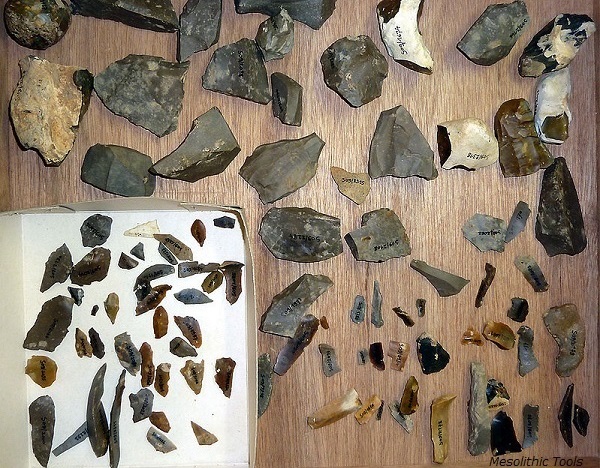
The archaeological stratigraphy reflects the continuity from the Upper Palaeolithic age to the Microlithic age and it proved that the Microlithic industry is rooted in the preceding phase of the Upper Palaeolithic industry.
The C-14 dates available for the Mesolithic culture illustrate that this industry began around 12,000 B.C. and survived up to 2,000 B.C.
Sites of Mesolithic Culture
-
The various sites of the Mesolithic period were located in −
Langhnaj in Gujarat,
Bagor in Rajasthan,
Sarai Nahar Rai, Chopani Mando, Mahdaha, and Damdama in Uttar Pradesh,
Bhimbetka and Adamgarh in Madhya Pradesh,
Orissa,
Kerala, and
Andhra Pradesh
The inhabitant community of the sites in Rajasthan, Gujarat, and Uttar Pradesh were essentially hunters, food-gatherers, and fishermen. However, some of the agricultural practice also evidenced at these sites.
The sites of Bagor in Rajasthan and Langhnaj in Gujarat elucidate that these Mesolithic communities were in touch with the people of the Harappan and other Chalcolithic cultures and traded various items with each other.
About 6,000 B.C., the Mesolithic people may have partly adopted the settled way of life and started domestication of animals including sheep and goat.
Prehistoric Rock Art
The rock-shelters in India were mainly occupied by the Upper Palaeolithic and Mesolithic people.
The rock-paintings depict a variety of subjects related to animals and the scenes including both people and animals. Besides animals and birds, fishes have also been depicted in the rock paintings.
-
Following were the important rock-painting sites −
Murhana Pahar in Uttar Pradesh
Bhimbetka, Adamgarh, Lakha Juar in Madhya Pradesh
Kupagallu in Karnataka.
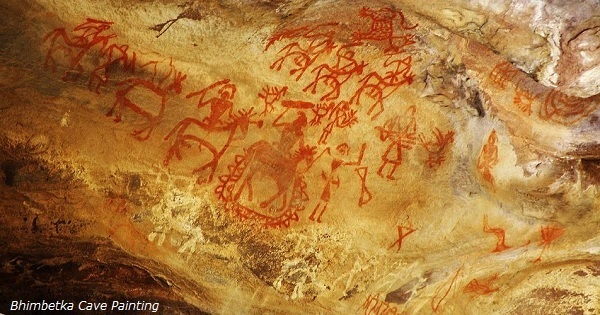
The rock paintings portrayed human-beings involved in various activities, such as dancing, running and hunting, playing games, and engaged in battle. The colors used in these rock paintings are deep red, green, white and yellow.
The rhinoceros hunting scene from the Adamgarh rock-shelters reveals that large number of people joins together for the hunt of bigger animals.
Ancient Indian History - The Neolithic Age
The Pleistocene Age came to an ended about 10,000 years ago.
By the time, the climatic conditions in western and southern Asia were settled more or less similar to that of today.
Beginning of Settled Life
About 6,000 years ago the first urban societies came into being in both the western and southern Asia regions.
The peculiar advancement in the human life was the domestication of a large number of animals and plants.
Around 7,000 B.C., humans in west Asia started domesticated crops like wheat and barley.
Rice might have been domesticated at the same time in India as it is shown by the evidence from Koldihwa in the Belan valley.
The domestication of various animals and successful exploitation of various species of wild plants ushered a shift towards permanent settlements, which gradually lead the economic and cultural developments.
Neolithic-Agriculture Regions
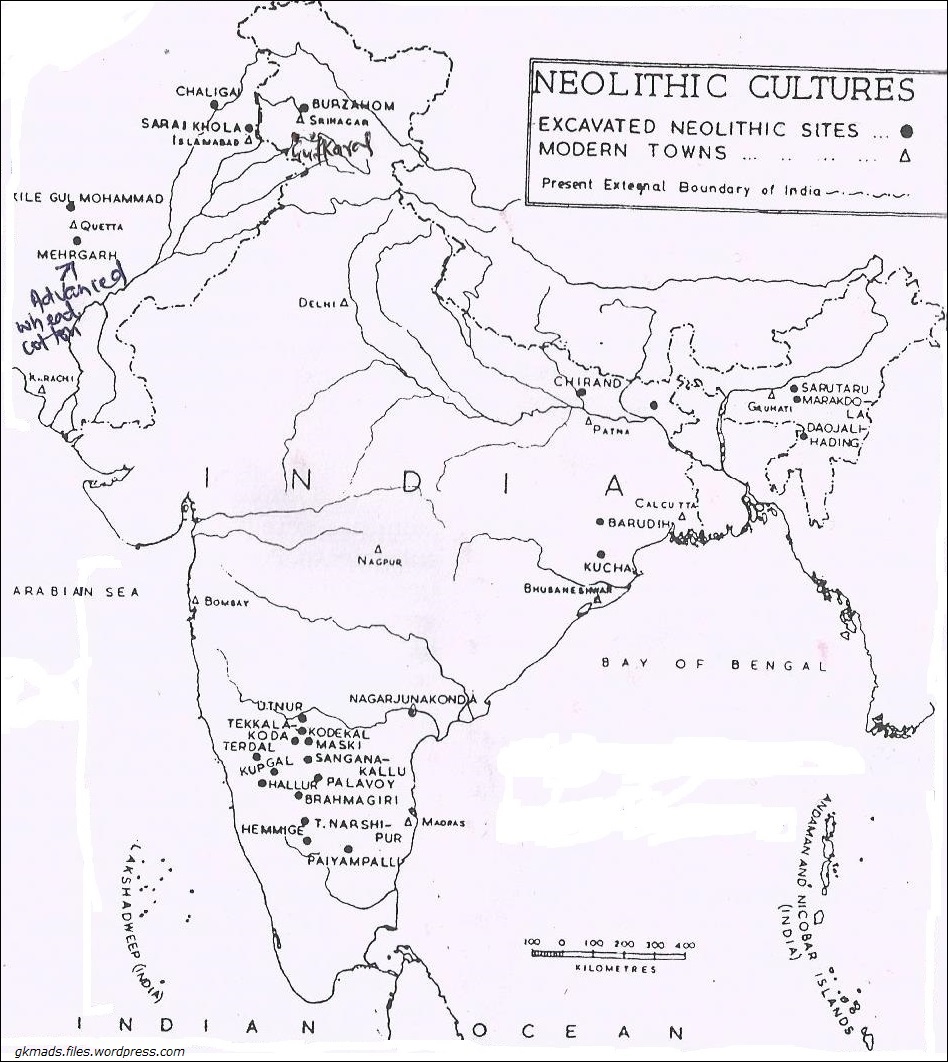
-
The Neolithic-agriculture based regions (in Indian), can be categorized into four groups −
Indus system and its western borderland;
Ganga valley;
Western India and the northern Deccan; and
Southern Deccan.
Agriculture and animal domestication were the main economic activity of early Neolithic cultures.
The evidence of the agricultural based economy of Neolithic culture comes from the Quetta valley and in the Valleys of Loralai and Zob rivers in the north-western part of the Indo-Pakistan region.
The site of Mehrgarh has been extensively examined and the result shows that the habitation here began in (around) 7,000 B.C. There is also an evidence of the use of ceramic during this period.
Around 6,000 B.C., earthen pots and pans were used; initially handmade and later wheel-made.
Initially, in the pre-ceramic period, the houses were in irregular scatter of square or rectangular shape and were made up of mud bricks.
The first village was formed by separating the house by waste dumps and passage ways between them.
The houses were generally divided into four or more internal compartments to be used some as storage.
The subsistence of early inhabitants was primarily depended on hunting and food gathering and additionally supplemented by some agriculture and animal husbandry.
The domestic cereals included wheat and barley and the domesticated animals were sheep, goat, pig, and cattle.
Beginning of the 6th millennium B.C. marked as the use of pottery by the human beings; first handmade and then wheel-made.
The people of this period, used to wear beads made up of lapis lazuli, carnelian, banded agate, and white marine shell. Beads were found with burial remains.
The people were largely engaged in long-distance trade as suggested by the occurrence of shell bangles and pendants made up of a mother of pearl.
During 7,000, the Neolithic settlement at Mehrgarh marked the early food-producing subsistence economy and beginning of trade and crafts in the Indus valley.
The communities in the Indus valley during the next 2,500 years developed new technologies to produce pottery and figurines of terracotta; elaborate ornaments of stone and metal; tools and utensils; and architectural style.
Large numbers of Neolithic sites have been found in the Ganga valley, Assam, and the north-east region.
-
Apart from the Indus valley, some important Neolithic sites are −
Gufkral and Burzahom in Kashmir,
Mahgara, Chopani Mando, and Koldihwa in Belan valley in Uttar Pradesh, and
Chirand in Bihar.
The site of Koldihwa (of 6,500 B.C.) provided the earliest evidence for the domestication of rice. It is the oldest evidence of rice cultivation in any part of the world.
The agriculture in the Belan valley began around 6,500 B.C. Besides rice, cultivation of barley was also attested at Mahgara.
The radiocarbon dates of the bone remains, (from Koldihwa and Mahgara) show that cattle, sheep, and goat were domesticated in the region.
The early Neolithic settlers in Burzahom lived in pit dwellings, rather than building houses on the ground.
The settlement at Chirand in Bihar is of the later period (relatively) to Indus valley.
Small polished Neolithic stone axes have been found from Cachar Hills, Garo Hills, and Naga Hills in north-east regions of India.
The excavations at Sarutaru near Guwahati revealed shouldered Celts and round-butted axes associated with the crude cord or the basket-marked pottery.
The new patterns of subsistence found in south India that was almost contemporary with the Harappan culture.
-
Following were the important sites in southern India −
Kodekal, Utnur, Nagatjunikonda, and Palavoy in Andhra Pradesh;
Tekkalkolta, Maski, Narsipur, Sangankallu, Hallur, and Brahmagiri in Karnataka
Paiyampalli in Tamil Nadu.
-
The Neolithic Age of southern India is dated between 2,600 and 800 B.C. It is divided into three phases as −
Phase-I − No metal tool (at all);
Phase-II − It is marked with tools of copper and bronze, but in limited quantity. People have domesticated cattle, including cow, bull, sheep, and goat and also practiced some agriculture and cultivated gram, millet, and ragi. Pottery of both handmade as well as wheel-made variety was used; and
Phase-III − It is marked with the use of iron.
-
The evidence (discussed above) leads us to draw certain broad conclusions.
The earliest Neolithic settlements, in the Indian subcontinent, was first developed in the west of the Indus River. At Mehrgarh, the Neolithic culture began about 8,000 B.C. and soon it became a widespread phenomenon.
People lived in mud houses; wheat and barley were cultivated; and sheep and goat were domesticated.
Long-distance trade for precious goods was practiced.
By 3,000 B.C., the Neolithic culture was a widespread phenomenon and covered a large part of the Indian subcontinent.
Chalcolithic Period of India
By the end of the Neolithic period, a full-fledged civilization was developed in the Indus and Saraswati valleys in the northern part of India.
A completely different kind of culture known as Chalcolithic Culture was developed in central India and Deccan region. They, however, never reached the level of urbanization in spite they were using metal. They were contemporary of the Harappan culture, but some other were of later Harappan age.
-
Important Chalcolithic cultures were −
Ahar culture c. 2,800-1,500 B.C.
Kayatha culture c. 2,450-700 B.C.
Malwa culture c. 1,900-1,400 B.C.
Savalda culture c. 2,300-2,000 B.C.
Jorwe culture c. 1,500 -900 B.C.
Prabhas culture c. 2,000-1,400 B.C.
Rangpur culture c. 1,700-1,400 B.C.
Common Features
The people of Chalcolithic culture had used unique painted earthenware usually black-on-red.
They used specialized blade and flake industry of the siliceous material like chalcedony and chert. However, the use of copper and bronze tools also evidenced on a limited scale.
The Economy was largely based on subsistence agriculture, stock-raising, hunting, and fishing.
Painted pottery is the most distinguishing feature of all Chalcolithic cultures.
The Kayatha culture is distinguished by a sturdy red-slipped ware painted with designs in chocolate color, a red painted buff ware, and a combed ware bearing incised patterns.
The Ahar people made a unique black-and-red ware decorated with the white designs.
The Prabhas and Rangpur wares both were derived from Harappan culture and are called Lustrous Red Ware because of their glossy surface.
The Malwa ware is slightly coarse in fabric, but has a thick buff surface over which designs were made either in red or black.
Jorwe ware is painted black-on-red and has a matt surface treated with a wash.
-
Well-known pottery forms used in this culture are −
Dishes-on-stand,
Spouted vases,
Stemmed cups,
Pedestalled bowls,
Big storage jars, and
Spouted basins and bowls.
The centers of Chalcolithic cultures flourished in semi-arid regions of Rajasthan, Madhya Pradesh, Gujarat, and Maharashtra.
The settlements of Kayatha culture were mostly located on the Chambal River and its tributaries. They were only a few in number and relatively small in size and the biggest may not be over two hectares.
The settlements of Ahar Culture were larger in comparison to Kayatha culture.
Excavations revealed that they used stone, mud bricks, and mud for the construction of houses and other structures. Balathal settlement was a fortified settlement.
The settlements of Malwa culture are mostly located on the Narmada and its tributaries. The three best known settlements of Malwa culture are at Navdatoli, Eran, and Nagada.
Navdatoli was one of the largest Chalcolithic settlements in the country. It was spread in almost 10 hectares. Some of these sites were fortified. Eran had a fortification wall with a moat. Nagada had a bastion of mud-bricks.
Very few not more than half dozen settlements of Prabhas culture are known.
The settlements of Rangpur culture are located mostly on Ghelo and Kalubhar rivers in Gujarat.
More than 200 settlements of Jorwe culture are known. Greater number of these settlements are found in Maharashtra.
The best known settlements of Jorwe culture are Prakash, Daimabad, and Inamgaon. Daimabad was the largest one that measured almost 20 hectares.
The houses of Chalcolithic people were rectangular and circular. They were made of mud wattle and daub. The circular houses were mostly in clusters.
The roofs of these houses were made up of straw, which were supported on bamboo and wooden rafters. Floors were made of rammed clay.
They cultivated both Kharif and Rabi crops in rotation and also raised cattle with it. They cultivated wheat and barley in Malwa region. Rice was cultivated in Inamgaon and Ahar.
They also cultivated jowar, bajra, kulth, ragi, green peas, lentil, and green and black grams.
Largely, the Chalcolithic cultures flourished in the black cotton soil zone. This reflects the ecological adaptation by the Chalcolithic people in developing a system of dry farming, dependent on moisture retentive soils based upon then available technology, knowledge, and means.
Chalcolithic: Trade and Commerce
The Chalcolithic communities traded and exchanged materials with other contemporary communities.
A large settlement serves as the major centers of trade and exchange. Some of them were Ahar, Gilund, Nagada, Navdatoli, Eran, Prabhas, Rangpur, Prakash, Daimabad, and Inamgaon.
The Ahar people settled close to the copper source and were used to supply copper tools and objects to other contemporary communities in Malwa and Gujarat.
Identical marks embedded on most of the copper axes found in Malwa, Jorwe, and Prabhas cultures that might indicate that it may be the trademarks of the smiths who made them.
It is found that Conch shell for bangles was traded from the Saurashtra coast to various other parts of the Chalcolithic regions.
Gold and ivory come to Jorwe people from Tekkalkotta in Karnataka and semiprecious stones may have been traded to various parts from Rajpipla in Gujarat.
Inamgaon pottery has been found at several sites located for away. This shows that the Jorwe people used to trade even the pottery to distant places.
Wheeled bullock carts were used for long distance trade, besides the river transport. The drawings of wheeled bullock carts have been found on pots.
Chalcolithic Culture In India
Religious Beliefs
Religion was an important aspect that interlinked all centers of Chalcolithic cultures.
The people Chalcolithic cultures worshiped the mother goddess and the bull.
In Malwa, the bull cult seems to have been predominant during the Ahar period.
A large number of both the naturalistic as well as stylized lingas have been found from most of the sites.
The realistic or naturalistic ones may have served as ritual offerings.
The Mother Goddess is depicted on a huge storage jar of Malwa culture in an applique design. She is surrounded by a woman on the right and a crocodile on the left, by the side of which is represented the shrine.
In a painted design on a pot, a deity is shown with disheveled hair, recalling the Rudra of later period.
A painting on a jar found from Daimabad portrayed a deity surrounded by animals and birds such as tigers and peacocks.
It similar with the Siva Pashupati that was found depicted on a seal from Mohanjodaro.
Two figurines belonging to late Jorwe culture found from Inamgaon have been identified as proto-Ganesh, which was worshipped for success before embarking on an undertaking.
Headless figurines were found at Inamgaon, which have been likened with the Goddess Visira of the Mahabharata.
A large number of Fire-altars have been found from the Chalcolithic sites during the course of excavations shows that Fire worship was a very widespread phenomenon among the people.
The people of Chalcolithic had a belief in life after the death, which is indicated by the existence of pots and other funerary objects found with the burials of the Malwa and Jorwe people.
The Chalcolithic cultures grown during the 3,000 to 2,000 B.C.
Excavation shows that large number of settlements like Kayatha, Prabhas, Ahar, Balathal, Prakash, and Nevasa were deserted due to decline in rainfall, which made it hard for the agricultural communities to sustain. They were reoccupied after four to six centuries.
Technology
The Chalcolithic people were farmers. They had made considerable progress in ceramic as well as metal technology. They used painted pottery, which was well made and well fired in a kiln. It was fired at a temperature between 500 and 700° C.
Metal tools were mostly made up of copper obtained from the Khetri mines of Rajasthan. Some of the commonly used tools were axes, chisels, bangles, beads, hooks, etc.
A gold ornament was found only in the Jorwe culture, which was extremely rare. An ear ornament has been found from Prabhas culture.
Crucibles and pairs of tongs of copper found at Inamgaon illustrate the working of goldsmiths. Chalcedony drills were used for perforating beads of semiprecious stones.
Lime was prepared out of Kankar that was used for painting houses and lining the storage bins and various other purposes.
Copper Hoard Culture
A copper harpoon was discovered from Bithur in Kanpur district in 1822; since then, nearly one thousand copper objects have been found from almost 90 localities in various parts of India.
Mostly the copper objects have been found in hoards (piles) therefore they are known as Copper Hoards.
The largest reserve was found from Gungeria in Madhya Pradesh. It comprises 424 pieces of copper objects and 102 thin sheets of silver. The main objects were various kinds of celts, harpoons, antennae swords, rings, and anthropomorphs.
The harpoons, antennae swords and anthropomorphs were confined to Uttar Pradesh
Whereas various kinds of celts, rings and other objects are found from diverse geographical areas of Rajasthan, Gujarat, Madhya Pradesh, Bihar, Orissa, West Bengal, and Maharashtra.
The Scientific analysis of these copper objects show that these are generally made of pure copper although very insignificant quantities of alloys have been noticed in some. And they were made in open or closed molds.
The Khetri copper mines and the hilly regions of Almora District in Uttaranchal were considered to be the source of metal for these copper hoards.
The Copper Hoards consists of weapons, tools, and the objects of worship.
The harpoons and antennae swords were used as weapons while various kinds of Celts and axes may have been used as tools. Bar Celts seem to have been used for mining ores.
The anthropomorphs were possibly the objects of worship. They were weighing quite a few kilos and measuring up to 45 cm in length and 43 cm in width.
Tiny anthropomorphs of the size of 4-10 cm were worshiped as Shani devata (the God Shani) all over northern India.
OCP Culture
A culture flourished in the upper Gangetic plains which is uniquely identified by the use of pottery with bright red slip and painted in black. This is known as Ochre-Colored Pottery Culture or simply OCP Culture.
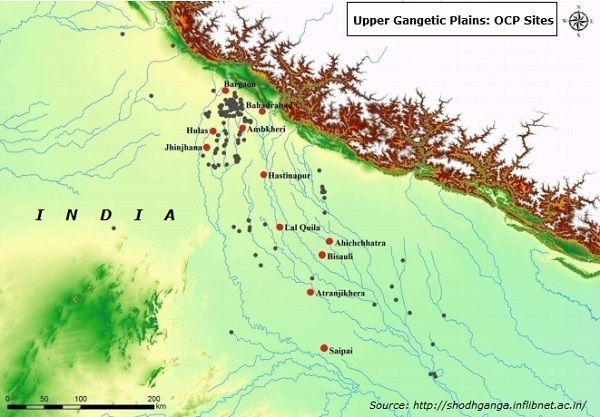
This OCP culture was almost contemporary to the latter half of the Mature Harappan civilization. The pottery of this culture has been found all over the upper Gangetic plains.
It has been found during the course of excavation in the region that the sites yielding this pottery have suffered from extensive floods. And, it is suggested by many scholars that the entire upper Gangetic plains was for some length of time submerged under water.
The people of OCP culture used copper tools and cultivated rice, barley, gram, and khaseri.
The OCP cultures have many shapes identical with the Harappan ware.
In the excavations at Saipai (in the District of Etah), Copper Hoard objects were found along with the OCP deposit.
In the region of Ganga-Yamuna doab, almost all the Copper Hoards have been found along with deposits of the OCP, which reflects that the Copper Hoards are associated with OCP people in doab. But their cultural association in Bihar, Bengal, and Orissa is not clear.
Some of the copper hoard types, mainly Celts, have been found associated with Chalcolithic people also.
Ancient Indian History - Harappan Civilization
Till 1920, the relics of the civilization were found only in the Indus valley region; therefore, it was known as the Indus civilization.
In 1920-21, the Harappan civilization was discovered in the excavations by D. R. Salini (at Harappa) and by R. D. Banerjee (at Mohenjo Daro).
The remains of the civilization were first noticed at Harappa, therefore it is also known as the Harappan civilization.
Geographical Facts
Following are the important geographical facts of distribution of Harappan civilization −
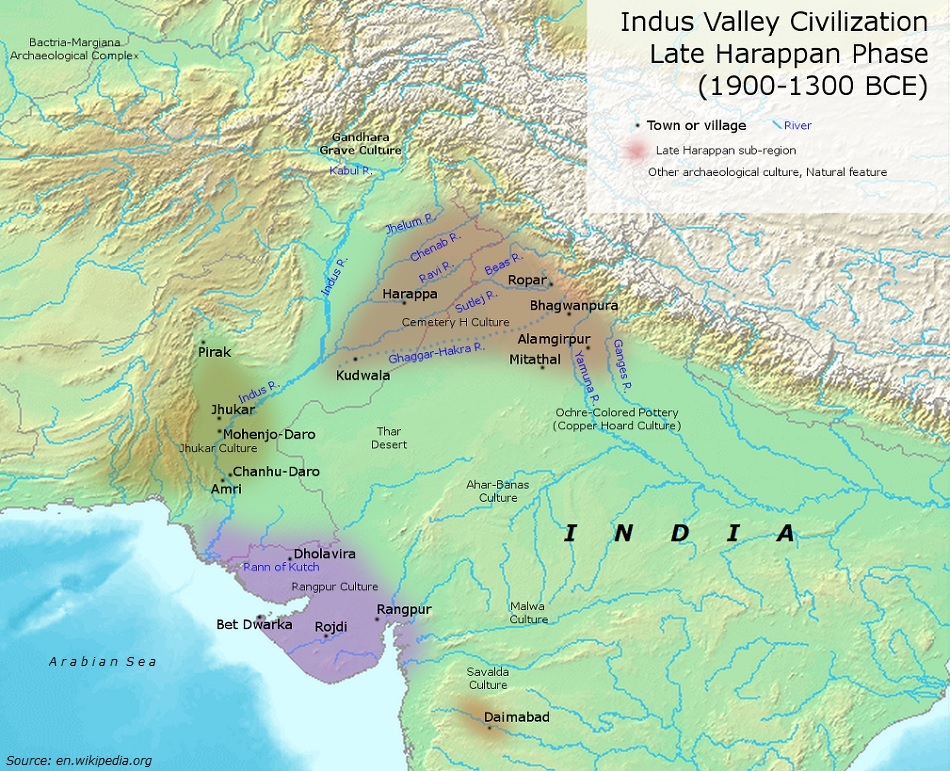
The 1,400 settlements of this civilization discovered so far are distributed over a very wide geographical area covering almost 1,600 km (east to west) and 1,400 km (north to south).
-
Harappan civilization extent starts from −
Sutkagendor (Baluchistan) in the west to Alamgirpur (Meerut, Uttar Pradesh) in the east and
Manda (Akhnoor District, Jammu and Kashmir) in the north to Daimabad (Ahmadnagar District, Maharashtra) in the south.
About 1,400 settlements of the Harappan culture are known from different parts of India. About 925 settlements sites are now in India and 475 are in Pakistan.
The total geographical stretch of Harappan civilization is about 1,250,000 sq. km which is more than 20 times of the area of Egyptian and more than 12 times of the combined area of Egyptian and Mesopotamian civilizations.
-
Mostly, the Harappan settlements were located on river banks of which −
Only 40 settlements were located on the Indus and its tributaries;
As many as 1,100 (80%) settlements were located on the vast plain between the Indus and the Ganga, comprising mainly the Saraswati river system (which no more exist);
About 250 settlements were found in India beyond the Saraswati River system; a number of them were located in Gujarat, and a few in Maharashtra.
The distribution pattern of settlements shows that the focus of Harappan civilization was not the Indus, but the Saraswati River and its tributaries, which flowed between the Indus and the Ganga. Therefore, few researchers prefer to call it as Saraswati civilization or Indus-Saraswati civilization
-
The settlements belonging to this civilization can be classified as
Small villages (which were up to 10 hectares),
Larger towns and small cities (10 to 50 hectares).
-
Large cities settlements such as −
Mohenjo Daro (+250 hectares),
Harappa (+150 hectares),
Ganawariwala (+80 hectares),
Rakhigarhi (+80 hectares),
Kalibangan (+100 hectares), and
Dholavira (+100 hectares).
Large cities were surrounded by vast agricultural lands, rivers, and forest that were inhabited by scattered farming and pastoral communities and bands of hunters and food-gatherers.
Excavations at the sites of Mohenjo Daro, Harappa, Kalibangan, Lothal, Surkotada, Dholavira, etc. have given us a fair idea about the various aspects such as town planning, economy, technology, religion, etc. of this civilization.
Harappan Town Planning
The orientation of streets and buildings, according to the cardinal directions east-west, and north-south was the distinguishing factor of the Indus-Saraswati cities.
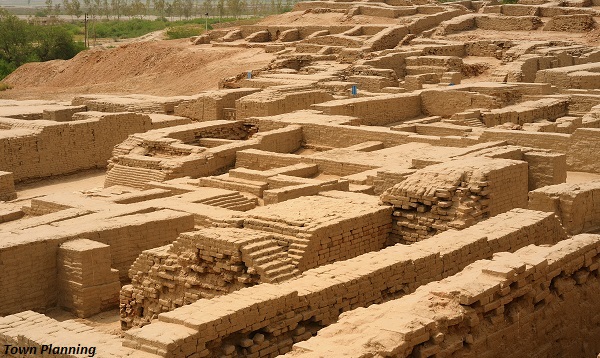
Harappan city sites, including Mohenjo Daro, Harappa, Kalibangan, and Surkotada were having large gateways at various entry points of the city. These gateways are seen even in the inner fortification areas also.
At Dholavira, a fallen signboard was found close to the main gateway. It is a large inscription having ten symbols each measuring approximately 37 cm high and 25 to 27 cm wide proclaimed some name or title.
Materials Used in Buildings
Most settlements were situated in the alluvial plains where the most common building materials were mud-bricks and kiln-fired-bricks, wood and reeds.
In the foothills and on the Islands of Kutch and in Saurashtra, dressed stone replaced bricks (due to an abundance of stone).
The sizes of bricks have been found identical proportions 1:2:4, that the width is double the thickness and the length four times, the thickness.
Doors and windows were made up of wood and mats.
Floors of houses were generally hard-packed earth that was often plastered.
Drains and bathing areas were made with baked bricks or stone.
Roofs were probably made of wooden beams covered with reeds and packed clay.
Types of Buildings
Excavations have uncovered many types of houses and public buildings at both large and small settlements.
-
The architecture may be grouped into three categories with some variations as −
Private houses,
Large houses surrounded by smaller units, and
Large public structures.
Doorways and windows rarely opened out into the main street, but faced side lanes.
The view into the house was blocked by a wall or a room around the front door. This was done to protect the activities in the central courtyard from the view of passers-by.
The doors were made with wooden frames and a brick socket set in the threshold served as door pivot.
Some of the doors seem to have been painted and possibly carved with simple ornamentation
The windows were small at first and second stories.
The adjacent houses were separated by a narrow space of "no man's land".
Public Buildings
Some large and distinct structures have been found in several cities designed especially for the public purpose.
Great Bath of Mohenjo Daro
The Great Bath of Mohenjo Daro is the most remarkable feature of any Harappan site.
The Great Bath was a brick structure, which measured 12 m by 7 m and is nearly 3 m deep from the surrounding pavement.
Water was evidently supplied by 3 large well placed in an adjacent room.
Surrounding the bath, there were porticos and sets of rooms, while a stairway led to an upper storey.
The bath was linked with some sort of ritual bathing, which was very common in Indian life right from the ancient times to till date.
Immediately to the west of the Great Bath (at Mohenjo Daro) was a group of 27 blocks of brickwork crisscrossed by narrow lanes. This structure measures 50 m. east-west and 27 m. north-south. These structures have been identified as granaries, which were used for storing grains. Similar structures have been also found at Harappa, Kalibangan, and Lothal.
The dockyard found at Lothal was another important structure. It was a large structure measuring 223 m. in length, 35 m. in width and 8 m. in depth, provided with an inlet channel (12.30 m. wide) in the eastern wall and a spillway.
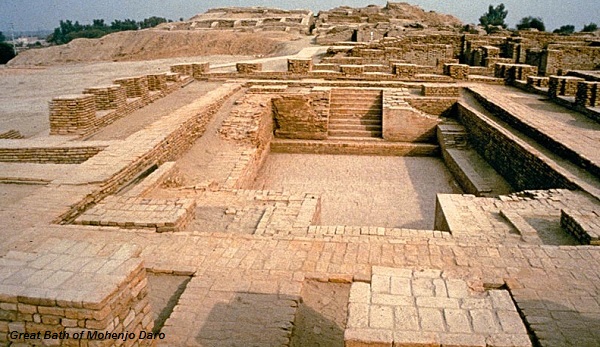
The inlet channel was connected to a river. By its side, it was 240 m. long and 21.6 m wide wharf. This was a dockyard where ships and boats used to come for loading and unloading of trading goods.
Lothal was a major trading center of the Harappan civilization.
Streets and Drains
The most outstanding features of the Harappan civilization were the streets and side lanes equipped with drains system.
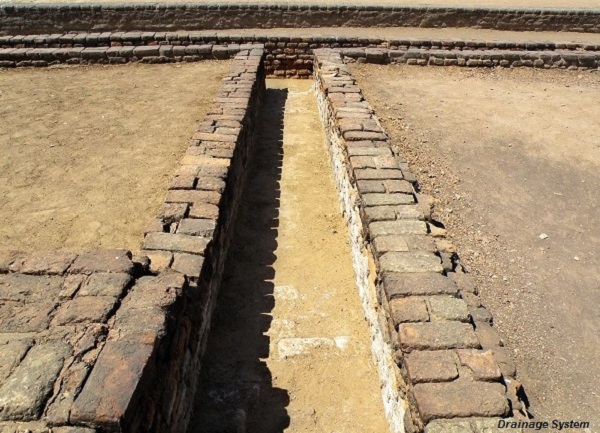
The streets cut each other on the right angles and the width of these streets was in a set ratio.
No encroachment on the streets was to be seen.
Even smaller towns and villages had impressive drainage systems. This indicates that people had a great civic sense of sanitation and care for health and hygiene.
Burnt bricks were used to make drains. Small drains connected with bathing platforms and latrines of private houses were joined with the medium sized drains in the side streets then these drains ran into larger sewers in the main streets which were covered with bricks or dressed stone blocks.
Harappan Crafts and Industries
The Harappan civilization is referred to as a Bronze Age civilization.
Customarily, unalloyed copper was used for manufacturing artifacts and rarely tin was mixed with copper to make bronze.
Harappan Tools
Tools and weapons were simple in form. They comprised of flat -axes, chisels, arrowhead, spearheads, knives, saws, razors, and fish-hooks.
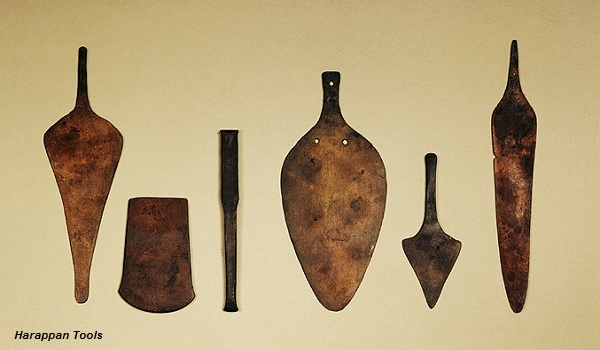
People also made copper and bronze vessels. They made small plates and weights of lead, and gold and silver jewelry of considerable sophistication.
The Harappans continued to use knives of chert blades. Further, a great skill and expertise have been seen in precious and semi-precious stone beads and weights.
Long barrel shaped cornelian beads (up to 10 cm. long) are the finest examples of craftsmanship.
Steatite was used for making a variety of objects like seals, beads, bracelets, buttons, vessels, etc. but its use in making faience (a form of glass) is particularly noteworthy.
The gold objects found in the form of beads, pendants, amulets, brooches, and other small ornaments in the Harappan civilization. The Harappan gold is of light color indicating high silver content.
Mature Harappan pottery represents a blend of the ceramic tradition of the pre-Harappan culture of both west of the Indus region as well as of the Saraswati area.
The pottery technology was quite advanced. Most of the pots were wheel-made.
Big storage jars were also produced. Pots were beautifully painted in black on the bright red surface with geometric designs, plants, animals, and a few paintings seem to depict scenes from stories.
More than 2,500 seals have been found. These are made of steatite. They mostly depict a single animal-unicorn bull, elephant, rhinoceros etc. but some also depict trees, semi-human, and human figurines; in some cases, participating in a ceremony.
Shell working was another flourishing industry. Artisans, settlements close to the sea manufactured shell ornaments like pendants, rings, bracelets, inlays, beads etc., besides objects as bowls, ladles, and gamesmen.
Trade and Commerce
Intensive agricultural production and large-scale trade played significant roles in flourishing of the Harappan civilization.
The elegant social structure and the standard of living must have been achieved by a highly developed system of communication and a strong economy.
The trade must have been internal in the beginning i.e. between one zone and another.
Agricultural produce, industrial raw materials (including copper ores, stone, semi-precious shells, etc.) were traded on a large scale.
-
Besides the raw material, they used to trade −
Finished products of metals (pots and pans, weapon, etc.);
Precious and semi-precious stones (beads, pendants, amulets, etc.); and
Ornaments of gold and silver were also traded to various areas.
-
They procured −
Copper from Khetri mines of Rajasthan;
Chert blades from Rohri hills of Sindh;
Carnelian beads from Gujarat and Sindh;
Lead from south India;
Lapis-lazuli from Kashmir and Afghanistan;
Turquoise and jade from central Asia or Iran;
Amethyst from Maharashtra; and
Agate, chalcedony, and carnelian from Saurashtra.
The occurrence of mature Harappan seals and other artefacts in contemporary Mesopotamian civilization, and some of the Mesopotamian and Egyptian objects in Harappan civilization, and the evidence of Mesopotamian documents established that the Harappans had the trading relationship with each other.
Weights and Measures
The trade requires a regulation of exchange and of weights and measures.
Harappan weights and measures were cubical and spherical in shape and were made up of chert, jasper, and agate.
-
The system of weights proceeded in a series i.e.
first doubling, from 1, 2, 4, 8, to 64, then going to 160; then
Decimal multiples of sixteen, 320, 640, 1600, 6400 (1600 × 4), 8000 (1600 × 5) and 128,000 (i.e. 16000 × 8).
The tradition of 16 or its multiples continued in India till 1950s.
Sixteen chhatank made a ser (equivalent to one kilo) and 16 annas made one rupee.
The measure of length was based upon a foot of 37.6 cm. and a cubit of 51.8 to 53.6 cm.
Transport and Travel
Pictures of ships and boats are found on some seals and drawings on pottery from Harappa and Mohenjo Daro.
Ship or a boat, with a stick-impressed socket for the mast, has been found from Lothal.
The boats depicted on seals and pottery resembles with the boats used in Sindh and Punjab areas (even today).
For land transport, bullock-carts and pack animals like bull, camel, ass etc. were used.
The terracotta models of bullock-cart found on roads from various sites indicate that carts used in those days were of the same size and shape used in the present day.
Ancient Indian History - Harappan Culture
Arts
A large variety of objects such as seals, stone statues, terracotta, etc. is superb examples of the art activities.
A Yogi from Mohenjo Daro and two small figurines from Harappa are the most outstanding pieces of art.
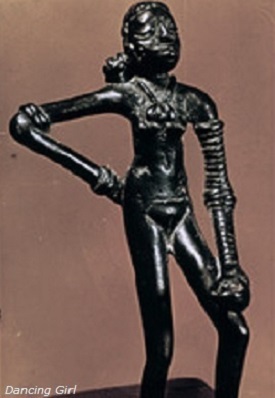
A dancing girl statue of about 11.5 cm. in height made up of bronzes was found from Mohenjo Daro.
Daimabad bronze animals workmanship, most likely belong to Harappan period.
The red sandstone torso found at Harappa is made up of detachable limbs and head.
The grey stone torso perhaps illustrates a dancing figure. Both these are so realistic that none would believe that they belong to the Harappan period.
Harappan people produced a large number of terracotta figurines, which were handmade. The figurines include humans, animals, birds, and monkey.
-
Following are the Specimen of Arts from the Harappan Civilization −
Bronze statue (Dancing Girl);
Terracotta Bulls;
Terracotta Female Figurine;
Head of a Yogi; and
Painted Jar dogs, sheep, and cattle.
The most artistic depictions are the figures of humped bull. Figurines of both humped and humpless bulls are found in excavations
A painting was found only on pottery. Unfortunately, no wall paintings, even if there were any, have survived.
Script
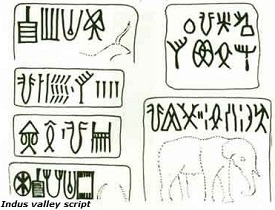
The language of Harappan is still unknown. But some scholars connect it to the Dravidian languages and others to Indo-Aryan and Sanskrit.
There are nearly 400 specimens of Harappan signs on seals and other materials such as copper tablets, axes, and pottery. Most of the inscriptions on seals are small, a group of few letters.
The Harappa script has 400 to 500 signs and it is generally agreed that it is not an alphabetic form of writing.
Agriculture
Agriculture was generally practiced along the river banks most of which were flooded during the summer and monsoons. The flood deposited every year fresh alluvial silt, which is highly productive and for which no major furrowing and certainly no manures and irrigation were required.
The cultivated field excavated at Kalibangan shows crisscross furrow marks indicating that two crops were grown simultaneously. This method is followed even today in the Rajasthan, Haryana, and western Uttar Pradesh.
The granaries found at Harappan cities suggest that cereals were produced in such a large quantities. They also kept enough reserve to face any future emergency.
The principal cereals were wheat and barley. Rice was also known and was a favored grain. Remains of rice have been found from Gujarat and Haryana areas.
Six varieties of millets including ragi, kodon, sanwa, and jowar were cultivated, along with peas and beans.
Fragments of cotton cloth found at Mohenjo Daro and other sites show that cotton was also grown.
Cotton has been found at Mehrgarh at least 2,000 years before the mature phase of the Civilization. This is the oldest evidence of cotton in the world.
Other major crops include dates, varieties of legumes, sesame, and mustard.
Wooden plough with a copper or wooden ploughshare was used for tilling fields.
Terracotta models of the plough have been found at Mohenjo Daro and Banawali.
Harvesting of crops would have been done with copper sickles as well as stone blades hafted in wood.
Animals like sheep, goat, humped bull, buffalo, elephant, etc. have been depicted on the seals. This shows that the range of animals domesticated by the Harappan people was quite large.
Skeletal remains of several animals like sheep, goat, bull, buffalo, elephant, camel, pig, dog, and cat etc. have been found in excavations.
Wild animals were hunted for the food. Bones of animals like spotted deer, sambhar deer, hog deer, wild pig, etc. found in the excavation prove it. Besides, several types of birds as well as fishes, were also hunted for food.
Bones of horses have been reported from Lothal, Surkotada, Kalibangan, and several other sites.
Terracotta figurines of the horse have been found at Nausharo and Lothal. But this animal is not depicted on seals.
Ancient Indian History - Harappan Religion
- There are generally two aspects of Harappan religion −
- Conceptual or philosophical and
- Practical or ritualistic.
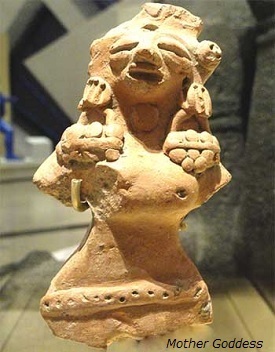
- The available evidence indicates that the religion of the Indus people comprised of −
- Worship of the Mother Goddess;
- Worship of a male deity, probably of Lord Siva;
- Worship of animals, nature, semi human, or fabulous;
- Worship of trees in their natural state or of their indwelling spirits;
- Worship of inanimate stones or other objects, of linga and yoni symbol;
- Chrematheism as illustrated in the worship of the sacred "incense-burners";
- Faith in amulets and charms indicative of demonophobia; and
- Practice of yoga.
These characteristics suggest that the religion was mainly of an indigenous growth and "the lineal progenitor of Hinduism, which is characterized by most of the features.
A large number of female figurines of terracotta have been found, which are the representations of the Great Mother Goddess.
A striking rectangle sealing found at Harappa represents the Earth or Mother Goddess with a plant growing from her womb.
A male deity, which depiction Siva as Pasupati (i.e. the prototype of the historic Siva), is portrayed on a seal with three faces, seated on a low throne in the typical posture of a Yogi, with two animals on each side - elephant and tiger on right and rhinoceros and buffalo on left, and two deer standing under the throne.
A terracotta piece having linga and yoni in one piece found from Kalibangan. People of Kalibangan region were worshiped the symbolic representation of Siva and Sakti respectively.
A remarkable seal, found at Mohenjo Daro, standing between two branches of a pipal tree, represents the deity.
A large number of 'fire-altars' have been found from the sites located in Gujarat, Rajasthan, and Haryana. From Kalibangan, Lothal, and Banawali a number of 'fire-altars' have been found.
Swastika, a sacred symbol with Hindus, Buddhists, and Jaina has been depicted on seals, painting, and graffiti.
A large number of terracotta figurines depict the individuals in various yogic postures (asanas) indicating thereby that the Harappans practiced yoga.
Social Stratification
-
The Harappan society appears to have been divided into three sections, viz.
An elite class associated with the Citadel;
A well-to-do middle class; and
A relatively weaker section, occupying the lower town, which was generally fortified.
The Craftsmen and laborers normally were resided outside the fortified area.
It is, however, difficult to say whether these divisions were based purely on the economic factors or had a socio-religious basis.
At Kalibangan, it appears that the priests resided in the upper part of the citadel and performed rituals on fire altars in the lower part of it.
Political Setup
It is also difficult to ascertain that what kind of political setup was prevailed at the time of the Harappan civilization.
The entire area of Indus Empire was administered from one capital, with a few regional administrative centers or provincial capitals.
There were several independent states or kingdoms, each with cities like Mohenjo Daro in Sindh, Harappa in Punjab, Kalibangan in Rajasthan, and Lothal in Gujarat as their capitals.
During 1,000 B.C., the area was divided into sixteen Mahajanapadas each independent with its own capital.
Disposal of the Dead
Scattered burials, as well as discreet cemeteries, have been found at many major sites.
The skeletal remains are few in comparison to the size of settlements and the population that may have lived on them.
The general practice was that skeletons were placed in an extended position with the head towards the north. Earthen pots containing food grains, etc. were placed in the grave and, in some cases, the body was buried with ornaments.
Cremation was also practiced, which has been proved by many cinerary urns or other receptacles containing calcined human bones and ashes together with vessel offerings for the use of a dead person in the next life.
Harappan Chronology
Marshall suggested that Harappan civilization flourished between 3,250 and 2,750 B.C.
Wheeler dated it to 2,500-1,500 B.C.
-
On the basis of radiocarbon dating method following chronology of the civilization emerges as −
Early Harappan Phase: c. 3,500 2,600 B.C.
Mature Harappan Phase: c. 2,600 - 1,900 B.C.
Late Harappan Phase: c. 1,900 1,300 B.C.
Decline
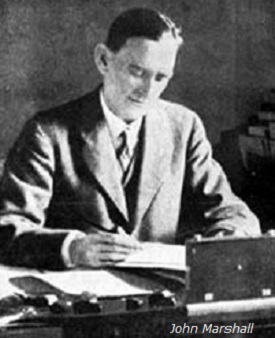
John Marshall (Director-General of the Archaeological Survey of India from 1902 to 1928) declares that Harappan civilization declined due to environmental degradation. The cutting of forests for agricultural land and timber for fuel and over-exploitation of resources, etc. resulted in the land to become barren and in the silting of rivers.
The environmental degradation, flood, drought, and famine must have become a recurring feature, which finally led to its decline.
Wheeler opined that it was destroyed by the Barabarian Aryans who came to India in about 1,500 B.C.
The archaeological or biological evidence proved that Wheeler's thesis of Aryan was the destroyer of the Harappan civilization was a myth.
-
The Harappan civilization was spread over a large area. There may be many causes of its decline as −
In the River Saraswati region, most likely, it declined mainly due to shifting of river channels.
Along the River Indus, most likely, it declined largely due to recurring floods.
Rainfall declined in general, which affected the agriculture, the main economic resource.
With the decline in economic conditions all other institutions like trade and commerce, administrative and political structures, Civic amenities, etc. also declined over a period of time.
Archaeological evidence shows that Harappan civilization did not disappear suddenly.
The decline was gradual and slow, which is witnessed over a period of almost 600 years from c. 1,900-1,300 B.C.
Features such as town-planning, grid patterns, drainage system, standard weights, and measures etc. slowly disappeared and a kind of realization takes place with distinctive regional variations.
Ancient Indian History - Vedic Civilization
- Vedic literature is the most significant source of information about the Vedic civilization.
- The Vedic literature consists of three successive classes of literary creations, namely −
- Vedas
- Brahmanas
- Aranyakas and Upanishads
Vedas
Veda means "knowledge". The Vedas formed the earliest segment of Vedic literature.
The Vedic literature had been evolved in the course of many centuries and was handed down from generation to generation by the word of mouth.
The Vedas are the collection of hymns, prayers, charms, litanies, and sacrificial formulae.
-
Vedas are four in number, namely −
Rig Veda − It is the oldest Veda. It is a collection of hymns.
Samveda − it is a collection of songs, which are mostly taken from Rig Veda.
Yajurveda − It is a collection of sacrificial formulae.
Atharvanaveda − it is a collection of spells and charms.
Brahmanas
The Brahmanas are prose texts. It describes about the meaning of Vedic hymns, their applications, and stories of their origins in details. Besides, it also explains the details about rituals and philosophies.
Aranyakas and Upanishads
Aranyakas and Upanishads exemplify philosophical meditations of the hermits and ascetics on soul, god, world, etc. These are partly included in the Brahmanas or attached, and partly exist as separate works.
They, the Brahmanas, the Aranyakas, and the Upanishads are attached to one or the other of the four Vedas.
Compositions of the hymns are credited to Hindu Rishis (monks) of divine origin.
The Vedas are called apaurusheya (not created by man) and nitya (existing in all eternity) while the Rishis are known as inspired seers who received the mantras from the Supreme deity.
Age of RigVeda
The origin of the earth goes back to about 4,600 million years and the origin of humans themselves goes back to about 4.2 million years (ago).
Max Muller gives arbitrarily the date of composition of Rig Veda to be around 1,200 to 1,000 B.C.
W. D. Whitney negated and criticized Muller for using totally arbitrary, unscientific, and un-academic method in assigning the dates.
On the analogy of the language of Avesta, some scholars opined that the date of Rig Veda may be 1,000 B.C.
Some of the Vedic gods namely Indra, Varuna, Mitra, and the two Nasatyas were mentioned in Boghaz-Koi (Asia Minor) inscription of 1,400 B.C., which proves that Rig Veda must have come into existence much before the date described by some of the foreigner scholars.
The Boghaz-Koi inscription records a treaty between the Hittite and the Mitanni Kings and the gods (mentioned in the above point) were cited as witnesses to this treaty. Even today, exactly in the same way, the oath is taken in the courts and on an assumption of a public office (in the name of god).
Bal Gangadhar Tilak, on astronomical grounds, dated Rig Veda to 6,000 B.C.
Harmon Jacobi held that Vedic civilization flourished between 4,500 B.C. and 2,500 B.C. and the Samhitas were composed in the latter half of the period.
Famous Sanskritist, Winternitz felt that the Rig Veda was probably composed in the third millennium B.C.
R. K. Mukerjee suggested that "on a modest computation, we should come to 2,500 B.C. as the time of Rig Veda".
G. C. Pande also favors a date of 3,000 B.C. or even earlier.
Rig Vedic Geography
Rig Vedic people called themselves Aryans. They had detailed knowledge of the geographical area in which they lived. Name and location and pattern of geographical features such as rivers and mountains mentioned in Rig-Veda suggest location of the regions of the geographical area of their habitat.
The Nadi-sukta hymn of the Rig Veda mentions 21 rivers, which include the Ganga in the east and the Kubha (Kabul) in the west.
The pattern of rivers is given in a definite order from the east to west i.e. from the Ganga in the east to the Kubul in the west. The rivers like Yamuna, Saraswati, Sutlej, Ravi, Jhelum, and Indus are situated between Ganga and Kabul.
The mountain namely the Himalayas and the Mujavant (as mentioned in the Veda) are located in the north.
The Ocean i.e. Samudra is mentioned in connection with rivers Sindhu and the river Saraswati had been falling into the ocean. Ocean has been also mentioned in the context of foreign trade.
The geography of Rig Vedic period covers present-day western Uttar Pradesh, Haryana, Punjab, Rajasthan, Gujarat, the whole of Pakistan, and the south of Afghanistan.
The battle of ten kings, mentioned in the Rig Veda, gives names of ten kings who participated in a war against Sudas who was Bharata king of Tritsus family. It illustrates that the territory known to Vedic people was divided into a number of states-republics and monarchical (kingdoms).
The battle was fought on the bank of Parushani (Ravi) river and Sudas emerged as victorious.
Bharatvarsha was the name used for the whole country. It was given by the most important people of the Rig Veda. They were Bharatas who were settled in the region between the rivers Saraswati and Yamuna.
The Rig Veda also gives the location of other people, such as Purus in the region of Kurukshetra; the Tritsus east of Ravi; the Alinas, the Pakhtas, the Bhalanas and the Sibis west of Indus (up to Kabul river) and so on.
Ancient Indian History - Vedic Society
Society
Occupation of individuals was the basis of classification of a society in the Rig Vedic period.
-
It was divided into four varnas, namely
Brahmanas (teacher and priests);
Kshatriya (rulers and administrators);
Vaisya (farmers, merchants, and bankers); and
Sudra (artisan and laborers).
There was complete freedom and mobility for the adoption of a profession.
Trades and occupations did not assume a hereditary character in the society (till now).
Salient Features of Vedic Society
The family was the smallest unit of a society. It was primarily monogamous and Patriarchal.
Child marriage was not in fashion.
There was freedom of choice in marriage.
A widow could marry the younger brother of her deceased husband.
The wife was a partner of the husband in all religious and social ceremonies.
The father's property was inherited by son.
The daughter could inherit it only if she was the only child of her parents.
Right to property was known in moveable things like cattle, horse, gold, and ornament and so also in immoveable property like land and house.
Education
The teacher was given great respect.
The school was in the home of the teacher where he taught the particular sacred texts.
The texts were in the first instance learnt by pupils repeating the words taught by their teacher.
A great importance was attached to enunciation and pronunciation.
Oral learning was the method of training.
Students were given intense training and learning to memorize and preserve the huge mass of Vedic literature.
Food and Drinks
The important part of the diet was milk and its products like curd, butter, and ghee. Grains were cooked with milk (kshira-pakamodanam).
Chappati (bread) of wheat and barley was eaten mixed with ghee.
People used to eat the meat of birds, wild animals (like boar, antelopes, and buffalo), and fish.
The meat of animals such as sheep, goat, and buffalo etc., which were sacrificed on ceremonial occasions, was also eaten.
The cow was mentioned as aghnya i.e. not to be killed. The Vedas prescribe a penalty of death or expulsion from the kingdom to those who kill or injure cows.
Sura and Soma i.e. alcoholic drinks were also consumed, though their consumption had been condemned.
Economic Life
Agriculture, cattle rearing, and trade and commerce were the main economic activity of the Rig Vedic people.
People had domestic animals like cows, sheep, goats, asses, dogs, buffalos etc.
Oxen were used for ploughing and drawing carts and horses for drawing the chariots.
The plough was drawn by the oxen at times in a team of six, eight, or even twelve.
The grains were harvested with sickles.
Manure was used for high yield; irrigation was also practiced.
Excess of rains and drought is mentioned as damaging the crops.
The grains are collectively called Yava and Dhanya.
Some other occupations were pottery-making, weaving, carpentry, metal working, leather-working, etc.
Initially, copper was the only metal that was used and the general term 'ayas' had been used for this. In a later period, terms like lohit ayas and syam ayas were used for copper and iron respectively.
The trade and traders (vanik) were also known in the Rig Vedic era.
The practices of exchange of goods (Barter Economy) were in trend. It has been found that ten cows were quoted as the price for an image of Indra.
The use of money can be traced in the mention of a gift of 100 nishkas.
Money-lending was also popular. It is mentioned that an eighth or a sixteenth part of one being paid either as an interest or part of the principle.
The sea is mentioned in the context of trade and ocean wealth, like pearls, and shells.
Ancient Indian History - Vedic Politics
- Politics of Vedic India was well structured and organized.
Political Structure
-
The political structure of Rig Vedic India can be studied in the following ascending order −
The Family (Kula), the smallest unit.
The Village (Grama)
The Clan (Vis)
The People (Jana)
The Country (Rashtra)
Kula (family) included all the people living under the same roof (griha).
A collection of several families constitutes the grama (village) and its headman was called gramini.
The collection of several grama (village) was called as the Vis and its head was called Vispati.
Several Vis constituted a Jana as it is mentioned as Panchajanah, Yadva-janaha, and Bharata-janaha.
The aggregation of all Jana constitutes Rashtra (country).
Administration
The hereditary kings were the popular form of Government.
The provision of a democratically elected king by the assembly of people Jana was also known.
The Rashtra was small states ruled by a raja (king).
The bigger kingdoms were ruled by samrat that reflects that they enjoyed a position of greater authority and dignity.
The Raja administered justice with the assistance of Purohita and other officials.
The Raja was offered bali, which was voluntary gift or tribute for his services. The bali was offered by his own people and also from defeated people.
The crimes were strongly dealt with by the administration. Major crimes were theft, burglary, robbery, and cattle lifting.
-
The important royal officials were −
Purohita (chief priest and minister)
Senani (army chief)
Gramini (head of a village)
Dutas (envoys)
Spies (spy)
Sabha and Samiti were two important assemblies mentioned in the Rig Veda. These assemblies were forms the essential feature of the government.
The Samiti was mainly dealt with the policy decisions and political business, included common people.
The Sabha was a selected body of the Elders or Nobles and less political in character.
Vedic Religion and Philosophy
Some gods had also been worshipped during the Rig Vedic period, which were the personified powers of nature.
Categories of Gods
-
The Vedic Gods were classified into three categories as −
Terrestrial (Prithivisthana) e.g. Prithivi, Agni, Soma, Brihaspati, and Rivers.
Aerial or intermediate (Antarikshasthana), Indra, Apam-napat, Rudra, Vayu-Vata, Prujanya, and Apah (water).
Celestial (Dyusthana) e.g. Dyaus, Varuna, Mitra, Surya, Savitri, Pushan, Vishnu, the Adityas, Ushas, and the Asvins.
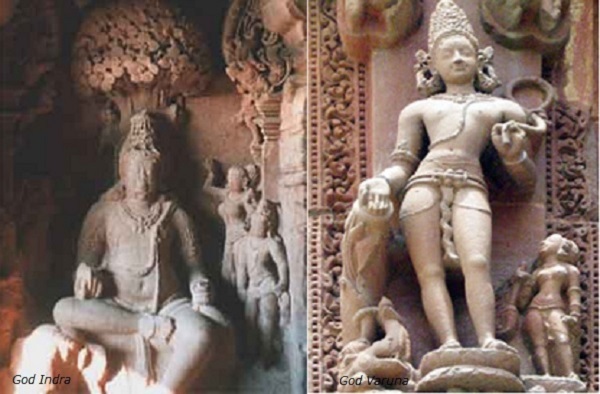
Indra and Varuna (the supreme cosmic and moral ruler) stand out in that order, pre-eminent above the rest.
Agni and Soma were also popular deities. Agni was valued as the messenger between the earth and the heaven. Agni is the only God who is regarded as present among all the categories of Gods.
Gods are described as born yet they are immortal. In appearance, they are humans, though sometimes they are conceived as animals, e.g. Dyaus as a bull and Sun as a swift horse.
In the sacrifice to the God, ordinary food of men such as milk, grain, flesh, etc. were offered and it becomes the food of Gods.
The gods normally used to be kind; but some of them also had unkind traits, like Rudra and Maruta.
Splendor, strength, knowledge, possession, and truth are common attributes of all the deities.
Gayatri Mantra is recited daily by the pious Hindus even today.
The multiplicity of gods is due to the different designations that have been given to God.
The ultimate unity of the universe is asserted as the creation of one God to whom different designations applied.
The creation is deemed as the outcome of the sacrifice made by the Viratpurusha or of evolution from nonbeing manifested in the form of water.
It is mentioned that Hiranyagarbha arose from the great waters, pervading the universe, and thus created the waves out of eternally pre-existing matter.
The hymn devoted to Visvakarman tells us that the waters contained the floating world egg from which Visvakarman arises; the first born in the universe, the creator, and maker of the world. It is now confirmed by science that life first developed in water.
Ancient Indian History - The Aryan Invasion
Similarities between Sanskrit and European languages (especially with Latin and Greek) was first noticed by a merchant Filippo Sassetti, who lived in Goa between 1583 and 1588 A.D.
Sir William Jones and many other scholars who were in the service of East India Company elaborated the language similarities (between European and Indian languages).
On the basis of the similarities, some scholars postulated that the ancestors of Indians and Europeans, must at one time, had lived in the same region and spoken the same language.
The scholars called this Indo-European language and their common homeland as the Indo-European homeland. This created a great divergence of opinion about the problem of identifying the original homeland of the Aryans, which was still a matter of debate.
A number of homelands (of Aryans) have been propounded, such as Steppe of central Asia, southern Russia, southern Europe, Germany, Chinese Turkistan, or even Mediterranean area like Palestine and Israel. Almost everywhere, the Vedic language and its literature were found (except India).
The Rig Veda is the oldest surviving records of the Aryans. It does not give any evidence (even a suspicion) of any migration of Aryans from any other area.
Max Muller assigned period between 1,200 or 1,000 B.C. for this event. Max Muller as a true Christian believed in Bible and according to Bible, the world was created on 23rd October 4,004 B.C. and thus Max Muller had the challenge to accommodate the entire human history within the 6,000 years.
The Aryans were originally inhabitants of India and did not come from outside as there is no archaeological or biological evidence, which could establish the arrival of any new people from outside between 5,000 B.C. and 800 B.C.
The skeletal remains found from various Harappan sites resemble the skeletons of the modern population of the same geographical area.
Harappan Civilization and Rigveda
A careful consideration of the evidence of the Rig Veda will lead to the conclusion that references it contains about people and their civilization may be taken to refer to the Harappan civilization.
The Discovery of Boghaz-Koi inscription (of 14th century B.C.) mentioned Rig Vedic deities that the Rig Veda existed earlier and the culture migrated from India to Asia Minor in that early age.
The time period of the Rig Veda in its final form should be placed not later than about 3,000 B.C.
Similarities between Rig Vedic and Harappan Civilizations
The geographical distribution of the Harappan sites can be seen in the light of Rig Vedic geography as well.
The geographical features, mentioned in the Rig Veda, confirms the extension of Vedic Civilization from Afghanistan in the north to Gujarat in the south, Ganga in the east to Kubha (Kabul) in the west.
The Rig Vedic culture was flourished in the area around the Saraswati river and its tributaries; more than 80% of the Harappan settlements are found around the Saraswati valley thus it was the main area of Harappan civilization.
The animals known to the Indus people are also known to the Rig Veda, including sheep, dog, buffalo, bull, etc.
The animals hunted by the Rig Vedic people were antelopes, boars, buffalos (gaur), lions, and elephants most of them were also familiar to the Indus people.
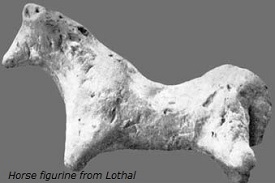
A Terracotta Figurine of Horse found from Lothal. The horse was an important animal in the Vedic period. Horse bones and terracotta figurines have been found at some Harappan sites as well.
Some of the religious practices of the Harappan people like worship of Pipal trees, bull, Siva-lingas are still followed by the modern Hindus.
Some terracotta figurines of women found at Nausharo still have vermillion in their hair-parting. Vermillion in the Hair Parting is the most precious and sacred symbol of married Hindu women even today.
A terracotta tablet from Harappa depicts the scene of Mahisa sacrifice, reminding us of Mahisasuramardini.
The Harappan people were aware of using ornaments like earrings, necklaces, bracelets, anklets, garlands, and jewels.
Rig Veda mentions the use of gold and ayas (copper). Ayas was used in making of vessels.
The above-discussed similarities found between the Rig Vedic and Harappan civilization have led to the conclusion that the Harappan civilization is the same as the Vedic civilization and the Aryans did not come to India from outside.
Ancient Indian History - Later Vedic Age
The different branches of Vedic literature had grown out of one another.
The four Vedas were followed by the Brahmanas, the Aranyakas, and the Upanishads.
The Brahmanas explain in detail various Vedic sacrificial ceremonies and their origins. It is the earliest of the Aryan's prose literature.
The Aranyakas contains the philosophical and mystical content. They are called so because their contents required that they should be studied in the isolation of the forest (aranya). They are the closing portions of the Brahmanas.
In the last phase of the Vedic literature, Upanishads were deduced form the tradition of the Aranyakas.
The Rig Veda deals with Karmakanda (ritualistic) and philosophical aspects.
The Brahmanas contains the ritualistic aspect.
The Upanishads contains the philosophic aspect.
Chhandogya and Brihadaranyaka are the two oldest and most important of forms of the Upanishads.
Other important Upanishads include Kathak, Isa, Mundaka, Prasna, etc.
Geography and New Political States
The main settlement of the Rig Vedic people was the region of Indus and Saraswati Valleys. However, during the later Vedic period, Samhitas and Brahmanas mentions that the settlements covered virtually the whole of northern India.
The Ganga river, by the time, occupied the proud place of the most revered and sacred river of India. Therefore, the center of civilization now shifted from Saraswati to Ganga.
There was remarkable development in gradual expansion and consolidation of Vis.
Jana known in Rig Vedic period like Bharatas, Purus, Tritsus, and Turvasas were slowly merging with other Janas and disappeared from the scene. People of Anus, Druhyus, Turvasas, the Krivis, were also vanished.
The states, namely Kasi, Kosala, Videha, Magadha, and Anga developed in the eastern Uttar Pradesh and Bihar. However, the areas of south India are not clearly mentioned.
The struggle for supremacy among different states was of frequent occurrence. The ideal of universal empire appeared.
Satapatha Brahmana mentioned the expansion of people towards the east. It mentioned Videgh Madhav migrated from the land of Vedic Culture (Saraswati Valley) and crossed Sadanira (modern Gandak River) and the eastern boundary of Kosala and came to the land of Videha (modern Tirhut).
The growth of three kingdoms, namely Kosala, Kasi, and Videha took place. Thereafter, the excavations at Hastinapur, Atranjikhera, and many other sites have revealed cultures ranging from 2,000 B.C. onwards.
Some characteristic of the pottery of post Harappan period were noticed as Ochre Colored Pottery (O.C.P.) (c. 2,000-1,500) and during c. 1,200-600 B.C., Black and Red ware, Painted Grey Ware etc. were noticed.
Northern Black Polished (N.B.P.) ware came to be manufactured about 7th century B.C.
The Kuru-Panchala region is mentioned in the Upanishads as the seat of culture and prosperity. It was the region of present western and central Uttar Pradesh.
Three kingdoms of Kosala, Kasi, and Videha mentioned as the seats of Vedic culture.
Magadha and Anga were also mentioned as distant lands in the Atharvanaveda.
In the south, Vidarbha (in Maharashtra) was mentioned.
The states of Bahlikas, Kesins, Kekayas, and Kamboja were situated in the further west to Punjab.
Polity and Administration
With the growing concept of states, kingship became the normal form of government. The kingship was being given the status of divine origin.
Terms like adhiraj, rajadhiraja, samrat, and ekrat were used in most of the text refers to the concept of a king of kings.
The term ekrat defined in Atharvanaveda, refers the paramount sovereign.
Special ceremonies were organized for the appointment of kings, such as the Vajpeya, Rajsuya, and Ashvamedha.
The monarchy was established on the firm foundations. It was not absolute, but limited in several ways.
-
Certain democratic elements were operating within the framework of kingship. These were −
The people's right in choosing their king;
The conditions imposed on king's rights and duties;
The kings dependence on the council of his ministers; and
The assemblies of people, sabha, and samiti, as check upon king's absolutism.
The king, under no circumstances, be considered as the sole owner of the kingdom with absolute power over the objects and subjects.
The king was holding the kingdom as a trust. He was supposed to be only a trustee and hold it on the condition that he would promote the people's well-beings and progress.
Sabha
Sabha and Samiti played important role in the administration along with the ministers and officials,
The sabha functioned as a parliament for disposal of public business by debate and discussion.
The Chief of the sabha was called as the sabhapati, the keepers as sabhapala and the members as sabheya, sabhasad, or sabhasina
Rules were framed to govern the debate in sabha.
Sabha also acted as a court of justice as it is said that "one who attends the Sabha sits as a law court to dispense dharma Justice".
Samiti
Samiti was the larger General Assembly of the people and it was different than Sabha in terms of function and composition. The Sabha was a smaller selected body, which functioned as the lower court.
Due to increase in complexity of the society and political structure, some new officials were appointed by the state namely −
Suta (charioteer),
Sangrahitri (treasurer),
Bhagadugha (collector of taxes),
Gramini (head of a village),
Sthapati (chief judge),
Takshan (carpenter),
Kshatri (chamberlain), etc.
The administrative machinery was highly organized and became an efficient instrument for ruling over a large kingdom.
Legal institutions became more focused. The king administered justice and wielded the rod of punishment.
Petty offences were left to "village judges.
The punishments for the crime were rather severe.
For evidence, the eye-witness was more important than informer.
The law was also very clear on the question of inheritance of property, ownership of land, etc.
The father's property was inherited by sons alone.
The daughters could inherit it only if she was the only child or there were no male issues.
Social System after Vedic Age
During the latter Vedic period, Varnas came to be birth-based rather than profession-based (as were in Rig Vedic period).
Development of new professions gave rise to jatis. But the jati system was not yet as rigid as it became during the period of the sutras.
The Rig Veda describes Vishvamitra as a rishi, but Aitareya Brahmana mentions him as Kshatriya.
The fourth Varna, i.e. Sudra were deprived of the rights of performing sacrifices, learning the sacred texts and of even holding landed property.
The concept of untouchability had not acquired its ugly form.
The individuals such as Kavasha, Vatsa, and Satyakama Jabala were born in non-Brahman jatis, but came to be known as the great Brahmans.
Education
This was period of the development of a vast and varied Vedic literature.
The Upanishads were evolved as the highest level of intellectual attainments.
Education began with the Upanayana ceremony.
The aim of learning was to get success in both worldly as well as spiritual life. Therefore It was necessary to learn faith, retention of knowledge acquired, posterity, wealth, longevity, and immortality.
The duties of pupils were well defined and there were stages of studies.
The pupils were taught at the homes of their teachers where they lived as family members and participated in the household works also.
For an advanced study, there were academies and circles of philosophical discussions.
Educated house holder may carry on their quest of knowledge by mutual discussions and regularly visiting the distinguished sages and learned scholars at different centers.
A great motivation of learning came from the assemblies of learned men; normally, organized and invited by the kings.
Parishads were established in different Janapadas with kings support.
Brihadaranyaka Upanishad described that king Janak of Videha organized a conference of the learned people. The major participants in this conference were Yajnavaikya, Uddalaka Aruni, Sakalya, Gargi, etc.
Yajnavalkya defeated all the participants in discussions and was declared as the most learned and wise.
Gargi and Maitreyi were the learned women. Their status shows that women were allowed to take an active part in the intellectual quest.
During this period, Kshatriyas begins to participate in the intellectual pursuit.
-
Some well-known Kshatriyas scholars were −
Janaka − the king of Videha,
Pravahana Jaivali − the king of Panchala, and
Asvapati Kaikeya − the king of Kasi.
These scholars (mentioned above) had acquired such distinction that even the learned Brahmans came to them for further instructions.
It is mentioned that Yajnavalkya, after completing his education with Uddalaka Aruni, went to Janaka (a king and Kshatriya) to study philosophy and other subjects.
The Chhandogya Upanishad described some subjects as the study of Vedas, namely Mathematics, Mineralogy, Logic, Ethics, Military Science, Astronomy, Science dealing with poisons, Fine Arts and Crafts, Music, and Medical Sciences.
The Mundaka Upanishad classifies all the subjects of study under Apara vidya.
In Mundaka Upanishad, the term Para vidya was used for the highest knowledge i.e. the knowledge of atman that involves knowledge of life, death, God, etc.
Economic life
Atharvanaveda dealt with economic aspect. It described many prayers to bring economic prosperity for the success of farmers, shepherds, merchants, and so on.
Atharvanaveda explained prayers for ploughing, sowing, rains, and an increase in cattle, wealth, and exorcism against beasts, wild animals, and robbers.
The plough was known as Sira and the furrow Sita.
Cow dung was used as manure.
It is mentioned that six, eight, and sometimes even twenty-four oxen were used to pull a plough.
Many types of grains were grown, such as rice, barley, beans, and sesame. Their seasons are also mentioned as barley sown in winter, ripened in summer; rice sown in the rains, reaped in autumn and son on.
The Satapatha Brahmana mentions various operations of agriculture such as ploughing, sowing, reaping, and threshing
The Atharvanaveda discussed that drought and excess rains threatened agriculture.
The Atharvanaveda mentioned that hymens to worship the cow and the death penalty were prescribed for cow killing.
Moneylending was also in trend; normally, practiced by Rich merchants.
Specific weight and measuring units were also known.
Niska and Satamana were the units of currency.
Bargaining in the market was known from the Rig Vedic times itself.
Aitareya Brahmana speaks of the "inexhaustible sea" and "the sea as encircling the earth". It shows that sea-borne trade was well known.
The term Bali was used for a voluntary gift to chief (initially), but later on, it become a regular tax. It was collected to maintain the political and administrative structure.
During this period, a noticeable development in industry and occupations was seen.
Various occupations were mentioned such as: fishermen, fire and rangers, washer men, barbers, butchers, elephant-keepers, footmen, messengers, makers of jewels, baskets, ropes, dyes, chariots, bows, smelters, smiths, potters, etc. Besides, merchants, long distance caravans, and sea trade were also mentioned.
The Rig Veda describes only one metal as ayas, which has been identified as copper. But during this period, a new metal i.e. iron, came into existence. Therefore, we get the term syam ayas (iron) and lohit ayas (copper). Apart from this gold, lead and tin are also mentioned.
Iron was used for making weapons and other objects like nail-parers, hammers, clamps, ploughshares etc. and Copper was used for making vessels.
Silver (rajat) and Gold were used for making ornaments, dishes, etc.
Religion and Philosophy
The Brahmanas recorded the growth of ritualism and ceremonial religion and the consequent growth of priesthood.
During the Rig Vedic period, large-scale ceremonies required maximum seven priests and two chief priests, but in the later Vedic period, the large-scale ceremonies required seventeen priests.
Several rites and ceremonies were come into practice as a means of attaining success in life in this world or the bliss in heaven.
The idea of penance and meditation took the precedence. Men took to ascetic practices under the belief that they would not only gain heaven, but also develop "mystic, extraordinary, and superhuman faculties".
During the later Vedic period, simple religious worship of the Rig Vedic period was replaced by elaborated rites and ceremonies and ascetic practices on one hand.
Whereas on the other, the intellectual pursuit of the people continued with the conviction that salvation was attainable only through the true knowledge.
The Upanishad contains philosophical treatises and there are about 200 Upanishads.
The Brihadaranyaka and Chhandogya were the oldest Upanishad. They contain bold speculations about the eternal problems of human thought concerning God, man, and the universe etc.
The Upanishads are considered as an important contribution of India towards the world's stock of spiritual thought.
Science and Technology
Vedas, Brahmanas, and Upanishads give enough ideas about the sciences of this period.
The term Ganita, was used for the Mathematics, which includes Arithmetic (Anka Ganita), Geometry (Rekha Ganita), Algebra (Bija Ganita), Astronomy and Astrology (Jyotisa).
The Vedic people knew the methods of making squares equal in area to triangles, circles, and calculate the sums and differences of the squares. Besides, Cubes, cube roots, square roots, and under roots were also known and used.
The Zero was known in Rig Vedic times and was frequently used in calculations and to record large numbers.
Astronomy was well developed. They were aware of the movement of heavenly bodies and able to calculate about their positions at different times. They had prepared accurate calendars and predicting the time of solar and lunar eclipses.
The Vedic people knew that the earth moves on its own axis and around the Sun. Further, moon moves around the earth. They also tried to calculate the time period taken for revolution and distances among heavenly bodies from the Sun. The results of these calculations are almost the same as the ones done by modern methods.
Achievements of Indian Philosophy
The Indian philosophy originated in the speculations of Vedic sages and reached its fruition in the Advaita Vedanta of Sankara.
The forces of Nature were personified as gods in the Vedic period and the Gods were considered as living on the earth, in the sky and in the heaven.
Men offered sacrifices to the deities and pray for cattle, crops, wealth, prosperity, health, longevity, progeny, victory, peace, and happiness here, and heaven after death.
It was also believed that there was an Ultimate Being, which manifested itself as the various gods.
The Nasadiya hymn of Rig Veda speculates: "He from whom this creation arose, whether He made it or did not make it, the highest seer in the highest heaven, he forsooth knows, or does even he not know?"
Upanishads
The Upanishads are the Vedic literature comprises the philosophy of Vedic sages about the nature of the Ultimate Reality, the process of Creation, the nature of the Self and its relation with the Ultimate Reality, the highest Value of life, and the Right Way of living.
-
All these were collected in a large number of books called Upanishads. There are the large numbers of Upanishads, but only 11 are considered as of the great importance, namely −
Isa,
Kathak,
Keno,
Prasna,
Mundaka,
Mandukya,
Taittiriya,
Aitareya,
Chandogya,
Brhadaranyaka, and
Svetasvatara.
-
It appears to be a general agreement among all these 11 Upanishads on the following point −
Atman i.e. (self) is the Ultimate, Enduring, and Unitary Reality in the individual.
Brahma is the Ultimate Reality in and beyond the objective world. Brahma has created the entire world: it originates from Brahma, it exists in Brahma; and it merges into Brahma. The Brahma is real, infinite, and blissful Consciousness.
The pure Atman and Brahma are one. An individual would be right in saying "I am Brahma."
The one Brahma appears as many because of Maya, the wonderful power of Brahma.
The union of Atman with Brahma is called Moksha. It is a state that liberates one from the chain of birth and death and is the highest goal of human life.
All unhappiness and sufferings of man are due to ignorance of the fact that man is the Atman, which is the same as the Brahma.
To realize the Atman, one has to give up all desires for worldly and finite objects, purify one's intellect, and live a righteous life.
The doctrines (discussed above) have been reminded again and again throughout Indian history.
The great thinkers of modern period have discussed the Upanishadic philosophy. Some of them are Ramakrishna Paramahamsa, Swami Vivekananda, Swami Ramatirtha, Aurobindo, and many more.
The Ramayana and the Mahabharata depict ethical and philosophical teachings.
The Ramayana presents Rama as a man of the highest ethical ideals.
Bhagavad-Gita
The Bhagavad-Gita represents the teachings of Lord Krishna. It is highly valued all over the world, and has been translated into a number of languages.
-
The principal teachings of Bhagavad-Gita are −
One should remain balanced both in happiness and sorrow; in profit and loss; and in victory and defeat.
Atman is indestructible, neither weapons can pierce it nor can fire burn it.
Death is always that of a body and not of Atman, which takes another body as its abode.
The god incarnates himself with a view to punish the wicked and protect the good people.
-
One can attain moksha in three ways −
By acquiring Gyan (the highest knowledge);
By devotion to God (bhakti); and
By action, i.e. selfless performance of one's duties (karma) without caring for reward.
The doctrine of karma tells that the present condition of a man is determined by the karma of his previous birth.
The philosophy of karma does not necessarily mean the people are powerless against the fate, which is pre-decided.
Most of the thinkers have explained that though our present condition is due to karma in previous birth. But we can change these conditions by our foresightedness and righteous deeds in the present life.
Important philosophical systems are Charvaka, Jaina, Buddha, Vaisesika, Nyaya, Samkhya, Yoga, Mimamsa, and Vedanta.
The Charvaka, Jaina, Buddha systems are classified as Nastika, as they do not believe in the authority of the Vedas and the God. And, rest others are Astika, i.e. they believe in the Vedas and the God.
-
The Charvaka system is also called Lokayata. It believes only in materialism. It expounds that
The physical body composed of material elements is the only essence of man;
Death only is the end of man;
Enjoyments of pleasures are the only objects in life; and
There is no life beyond death, no heaven or hell, no Law of karma, and no rebirth.
The Charvaka system does not believe in soul, god, or any other life beyond the present one.
There are some similarities and affinity among the other six systems of philosophy i.e. between Nyaya and Vaisesika, Samkhya, Yoga, Mimamsa, and Vedanta.
Ancient Indian History - Evolution of Jainism
By this time, the old ritualistic Vedic tradition had gradually ceased to be a strong force.
The freedom of thought allows fermentation of the new ideas and philosophic principles, leading to the establishment of numerous religious sects, which had never happened in India before.
The important landmark in the history of Indian culture was the evolution of Jainism and Buddhism during the 600 B.C.
Jainism and Buddhism have greatly influenced the society and culture of India. They stand against certain aspects of the pre-existing system of old ritualistic Vedic tradition.
Ascetic orders and brotherhoods were the basis of both Jainism and Buddhism explained in their own way.
The asceticism has its origin in the Vedic thought and Upanishads has been directly encouraging this by the recommending retirement to forests as essential to those who seek the highest knowledge.
The Aranyakas are the products of hermitages of the forests.
Jainism
Rishabhanath and Aristhanemia are the two Tirthankaras of Jainism mentioned in Rig Veda that proves the antiquity of Jainism.
Rishabhanath had been mentioned an incarnation of Narayana in Vayu Purana and Bhagwat Purana.
The nude sculpture of some Tirthanakara was also found at Harappa.
The antiquity of Jainism is represented by a succession of twenty-four Tirthankaras.
Rishabhnath was the first Tirthankara of Jainism. The traditions of Jainism say that he was a king and renounced the kingdom in favor of his son, Bharata, and became an ascetic.
The name Bharatavarsha is after Bharata, the son of Rishabhanath as per the Puranic traditions.
Parsvanath was the twenty-third Tirthankara, he renounced the world at the age of thirty and attained the enlightenment (perfect knowledge) after nearly three months of intense meditation and spent the remaining life as a religious teacher. He had lived 250 years before Mahavira.
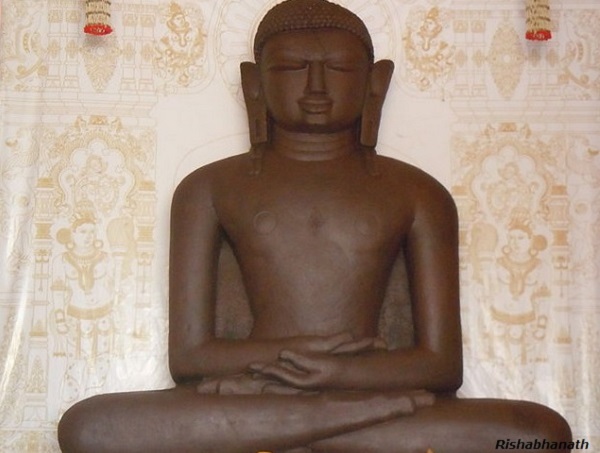
Mahavira
Vardhamana Mahavira was the twenty-fourth and the last Tirthankara of Jainism.
Mahavira was born about 540 B.C. in the village Kunda-grama near Vaisali. He was the only son of Siddhartha and Trisala. Siddhartha was the head of famous kshatriya Jnatrika clan and Trisala was the sister of Chetaka, an eminent Lichchhavi noble of Vaisali. Chetaka's daughter was married to the king of Magadha, Bimbisara.
Mahavira was married to Yasoda and lived a life of a householder. After the death of his parents, Mahavira left his home at the age of thirty, and became an ascetic.
Mahavira had practiced most rigorous asceticism for the next twelve years and attained kaivalya at the age of 42 years.
As per the Jainism, Kaivalya is the supreme knowledge and final liberation from the bonds of pleasure and pain.
After attaining Kaivalya, Mahavira came to be known as Mahavira and Jina or the conqueror and spent his remaining life in preaching. His followers came to be known as Jainas. Initially, they were designated as Nirgranthas, which means free from fetters.
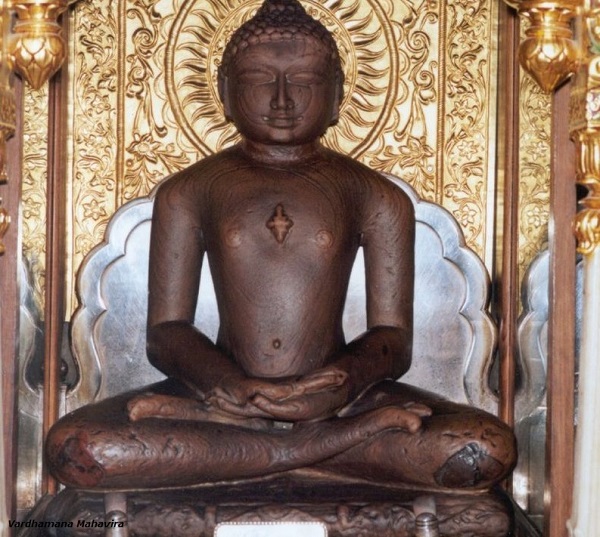
In 468 B.C., Mahavira passed away at Pawapuri at the age of 72 years. He spent 30 years of his life in preaching his teachings.
-
Four doctrines of Parsvanath are −
Non-injury to living beings,
Speaking the truth,
Non-possession of property, and
Not stealing.
Vardhaman Mahavira accepted four doctrines of Parsvanath and added Celibacy as a fifth one to them.
Celibacy is the complete renunciation and free from any possessions. Mahavira asked his followers to discard even their clothes.
Jains Mythology
The universe is eternal.
The world is not created, maintained, or destroyed by a God, but it functions through a universal or eternal law.
Jains did not deny the existence of God, but they simply ignored.
The existence of the universe is divided into cycles of progress (Utsarpini) and declines (Avasarpim). It functions through the interaction of living souls (Jiva) and everything in the universe has a soul.
The souls are found not only in the living beings like animals and plants, but also in stones, rocks, water, etc.
The purification of the soul is the purpose of living.
Only the pure soul after being released from the body resides in heaven.
The soul, which has finally set itself free, rises at once to the top of the universe, above the highest heaven where it remains in an inactive omniscient bliss through eternity. It is known as Nirvana in the Jainism.
-
According to Jainism, salvation is possible only by −
Deserting all belongings,
A long course of fasting,
Self-mortification,
Study, and
Meditation.
Jainism, therefore, says that the monastic life is essential for salvation.
According to the Jaina tradition, the king Chandragupta Maurya has supported Jainism. He had accepted Jaina religion and abdicated the throne and died as a Jaina Bhikshu in the southern part of India.
Two hundred years after the death of Mahavira (during the reign of Chandragupta Maurya), a terrible famine broke out in Magadha. Bhadrabahu was the chief of the Jaina community at that time.
Bhadrabahu went to Karnataka with his followers and Sthulabhadra remained in Magadha as the in-charge of Jainism.
Bhadrabahu convoked a council at Patliputra, in which the Jaina canon was arranged.
Later in the 5th century A.D., the Jaina canon was further rearranged when the Jainas returned from south India. From where Jainism divided into two sects.
Those who returned from southern India held that complete nudity is an essential part of the teachings of Mahavira while the monks in Magadha began to put on white clothes.
Those who put on white robes known as Svetambaras and those who were stark naked were called as Digambaras.
Evolution of Buddhism
Buddhism was founded by Gautama in 566 B.C. He was the son of Suddhodhan and Mayadevi. His father Suddhodhan was the eminent king of Sakya republic.
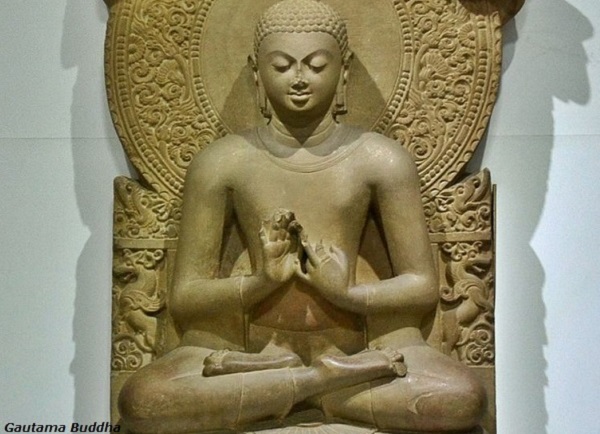
An astrologer predicted about Gautama that he would either be chakravartin-samrat (a great king) or a great sanyasin (a great monk).
Gautama was married to Yasodhara at an early age. Gautama was shocked at the sight of an old man, a diseased person, a dead body. Thereafter, he was attracted by the saintly appearance of an ascetic. One night he renounced the worldly life and left his home, wife, and son.
After leaving home, Gautama studied for some time in the philosophical schools of two renowned teachers. Thereafter, six years of profound meditation led to the discovery of truths. Gautama became the Buddha i.e. the enlightened one.
-
The main principle of Buddha's teachings is represented by the Four Noble Truths (Arya-Satyas) as −
Dukkha (the world is full of sorrow)
Dukkha Samuddaya (that causes the sorrow)
Dukkha Nirodha (sorrow can be stopped)
Dukkha Nirodhagamini-pratipada (path leading to cessation of sorrow)
Teachings of Buddha
Desire is the root of all human sadness and the assured way of ending unhappiness was the elimination of desire.
Death is certain and there is no escape from it which lead to rebirth and caused further suffering. One could get out of this chain of suffering by attaining Nirvana (salvation).
-
To achieve the final salvation (Nirvana) Buddha suggest Ashtangika marga (the eight-fold path). These eight fold paths are −
Right speech,
Right action,
Right means of livelihood,
Right exertion,
Right mindfulness,
Right meditation,
Right resolution, and
Right view.
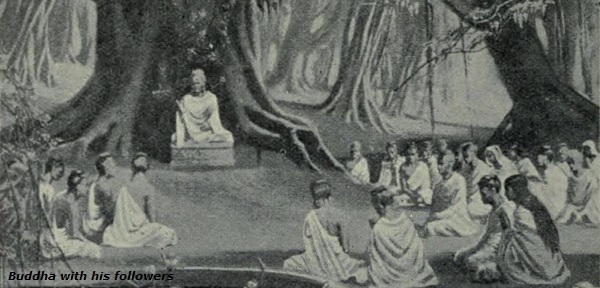
The ultimate aim of life is to attain Nirvana, which means freedom, from further birth and death.
Nirvana is the eternal state of peace and bliss or liberation from the cycle of birth and death
-
Buddha had summarized the whole process in three words viz.
Seela (Right conduct),
Samadhi (Right concentration), and
Prajna (Right knowledge).
According to Buddha, Seela and Samadhi lead to Prajna, which is the direct cause of nirvana.
Buddha advocated "The Middle Path" in which extremes are avoided.
Buddha visited to the Deer Park (modern Sarnath), Kasi after his enlightenment and gave his first Sermon (lecture).
His first sermon was known as "Set in Motion, the Wheel of Law".
-
According to Buddha s moral doctrine −
Man is an arbiter of his own destiny and not any God or Gods.
If a man does good deeds in his life, he will be reborn in a higher life and so on till he attains the Nirvana and finally gets freedom from the evils of birth.
If a man does evil deeds, he will surely to be punished and the man will be reborn into lower and lower life, each life taking him further away from the Nirvana.
The middle path was the best and man should avoid both extremes, viz. a life of comforts and luxury, and a life of severe asceticism.
Buddhism laid great stress on love, compassion, equanimity, and non-injury to the living creatures in thought, word, and deed.
Buddhism rejected the necessity of Vedic rituals and practices for the purpose of salvation, and the superiority assumed by the Brahmans.
-
The followers of the Buddha fell into two categories −
Upasakas i.e. the lay followers who lived with family; and
Bhikshus i.e. monks who renounced the world and led the life of an ascetic.
Bhikshus lived as a commune called Sangha founded by Buddha himself. In Buddhism, all the followers enjoyed equal rights irrespective of their Varna and Jati.
Women were also allowed to join the Sangha and were known as Bhikshunis.
Buddha debated in the language of the common people.
Buddha and his followers used to travel from place to place, and preach for eight months in a year; and, four months, during the rainy season, they stayed at one place.
Buddha died in the year 486 B.C. at Kushinagar at the age of 80.
The ashes of Buddha after cremation were distributed among his followers.
The followers kept these ashes in caskets and built Stupas over them. One example of such Stupa is Sanchi Stupa.
Jainism vs. Buddhism
-
Following are the key similarities in the philosophies of Jainism and Buddhism −
Both the philosophies recognize the fact that the world is full of sorrows and the salvation of a man means his deliverance from the eternal chain of birth and death.
Both the philosophies derived their basic principles from the Upanishads.
Both the philosophies did not accept the idea of God.
Both the philosophies laid great stress upon a pure and moral life, especially non-injury to living beings.
Both the philosophies emphasized the effects of good and bad deeds upon a man's future births and ultimate salvation.
Both the philosophies criticized caste.
Both the philosophies preached their religions in the common language of the people.
Both the philosophies encouraged the idea of giving up the world, and organized a church of monks and nuns.
-
Following are the key differences between Jainism and Buddhism −
Both the philosophies have distinct historic origins.
Both the philosophies differ in fundamental conceptions about salvation.
Jainism laid great stress upon asceticism and practiced it in a very rigorous manner, but Buddha criticized it and suggested his disciples to follow the middle path between a life of ease and luxury on one hand, and rigorous asceticism on the other.
Buddha condemned the practice of going out naked.
Jainisms view of non-injury even to animals was carried to far greater excesses.
Buddhism spread far and wide in different parts of the world within five hundred years whereas Jainism never spread beyond the boundaries of India.
Buddhism declined considerably in the land of its birth while Jainism is still a living force in India, and has got a stronghold upon a large and influential section of the people.
Alexanders Campaign in India
During the Alexanders period, the western borderland of India was occupied by two Maha-Janpadas, namely Kamboja and Gandhara, which included the region of modern Punjab, Sindh, and Afghanistan.
In 522-486 B.C. (during the reign of Darius), Achaemenians extended their empire to the northwestern part of India and they had subjugated a number of principalities living to the south of the Hindukush Mountains.
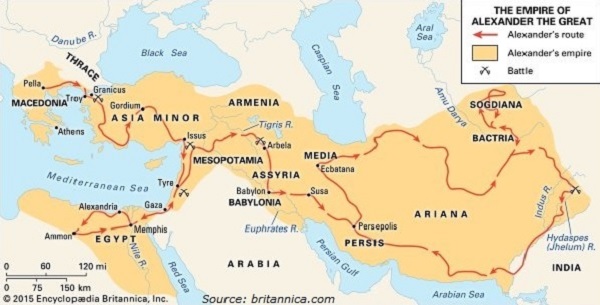
Herodotus, the famous Greek historian, mentions that Darius sent a naval expedition in 517 B.C. to explore the valley of the Sindhu River.
The evidences prove that the Indian soldiers were the part of the Achaemenian army that conquered Greece in the time of Xerxes (486-465 B.C.) and also fought against Alexander at Gaugamela in 330 B.C.
The defeat of Darius III (the Achaemenian king) by Alexander became a turning point. Alexander dismantled the Persian Empire and captured most of the western Asia including Iraq and Iran.

In 326 B.C., after the conquest of the Persian Empire, Alexander marched to India through the Khyber Pass.
It is surprising that no Indian source mentions anything about Alexander or his campaign. The history of Alexander's campaign in India has been reconstructed on the basis of accounts available in Greek and Roman sources. It is also surprising to note that Greek sources are completely silent about Kautilya.
The Greek sources, however, mention about Sandrocottas or Androcottas who has been identified as Chandragupta Maurya and fixing 326 B.C. as the date of Chandragupta's accession to the throne.
Alexander Expeditions in India
In 326 B.C. when Alexander reached on the Indian soil, the king of Takshasila near Rawalpindi in Punjab offered help to him. But many of the Republican Chiefs and kings in Afghanistan, Punjab, and Sindh had poised a brave resistance and refused to submit to the Alexander without a fight.
Alexander divided his army into two parts after crossing Hindukush and Alexander himself, conquers the north-western part of India.
The Greeks had faced a strong resistance from tribal Hasti chief having capital Pushkalavati.
The army of Assakenoi king was led by the queen, which was the example of an enthusiasm for the defense of the country by the people of these regions that even women and the mercenaries took part in fighting and preferred a glorious death.
In spite of a hard resistance for many days (by the Assakenoi soldiers), Alexander captured the city Massaga (the capital of Assakenoi).
After the victory of Assakenoi, Alexander had himself resolved a special agreement by which he granted the lives of the army of 7,000 mercenaries. But deceitfully, they had been slaughtered mercilessly in the night by Alexander and his soldiers. This massacre of Assakenoi has been condemned even by the Greek writers.
Alexander, after defeating Assakenoi, joined his other division of army and constructed a bridge on the Indus River nearby Attock.
After crossing the Indus, Alexander proceeded towards Taxila, but the king Ambhi admited the sovereignty of the Alexander.
Paurava (Greeks call Porus), the ruler of a kingdom between the Jhelum and the Chenab was the most powerful among the north-western Indian provinces. Alexander made intense preparations to defeat him.
Porus fought bravely and with nine wounds on his body, was led a captive before Alexander.
When Porus was brought as captive before Alexander, he (Alexander) asked him how he would like to be treated. Porus replied proudly, "Like a King".
Alexander made a coalition with the brave king Porus by restoring his kingdom and adding to it the territories of 15 republican states along with 5,000 cities and villages.
Alexander had to fight hard with the Kathaioi (Kathas) on the bank of river Beas. The casualties tolled up to 17,000 killed and 70,000 captured.
Alexander's Retreat
In July 326 B.C., on the bank of the Beas, the Alexanders campaign was clogged due to soldiers mutiny and they refused to proceed further.
The Greek writers recorded the reason of the disobedience of the soldiers was merely the war weariness or partly to the fear inspired by the mighty empire of the Nandas.
The troops were worried, if Alexander met with an accident in course of the campaign what would be the fate of the whole army. They were also afraid of the other unpredictable calamity. Hence, due to refusal of the army, Alexander decided to return.
Alexander had to fight with a confederacy of republican states led by the Malloi (Malavas) and the Oxydrakai (Kshudrakas) near the confluence of the Jhelum and the Chenab Rivers.
About 5,000 Brahmans gave up their pen for the sword to save their mother land. All the towns of the Malavas became citadels of resistance.
Alexander was severely wounded while capturing the town and on this, his soldiers became infuriated and started killing everybody they found, irrespective of age and sex.
A tribal group, Agalassoi (Arjunayanas), also fought with great courage and showed great bravery, patriotism, and sacrifice when one of their towns was captured by Alexander. All the citizens 20,000 in number threw themselves into the fire with their wives and children.
Alexander reached Patala and began his homeward journey in September 325 B. C. He proceeded with his army by land, but sent the ships under Nearchus (one of the officers).
In 324 B.C., Alexander reached Susa in Persia where he died in the next year i.e. 323 BC.
After Alexanders death, the Greek edifice collapsed within a short period of time.
The Greek historians had been thrilled by such victorious campaign and recorded in minute details of the impact of Alexander's Campaign.
Whereas the Indian sources have remained silent over such a triumphant Campaign because this Campaign touched only the western border of the then India and returned without leaving any lasting impact on Indian people.
In an Indian context, Alexander's campaign can hardly be called a great military success, as they showed barbarism in the conquest of petty (small) states.
The conquered region (of Alexander) declared their independence within three months of Alexander's departure from India.
Ancient Indian History - Maurya Dynasty
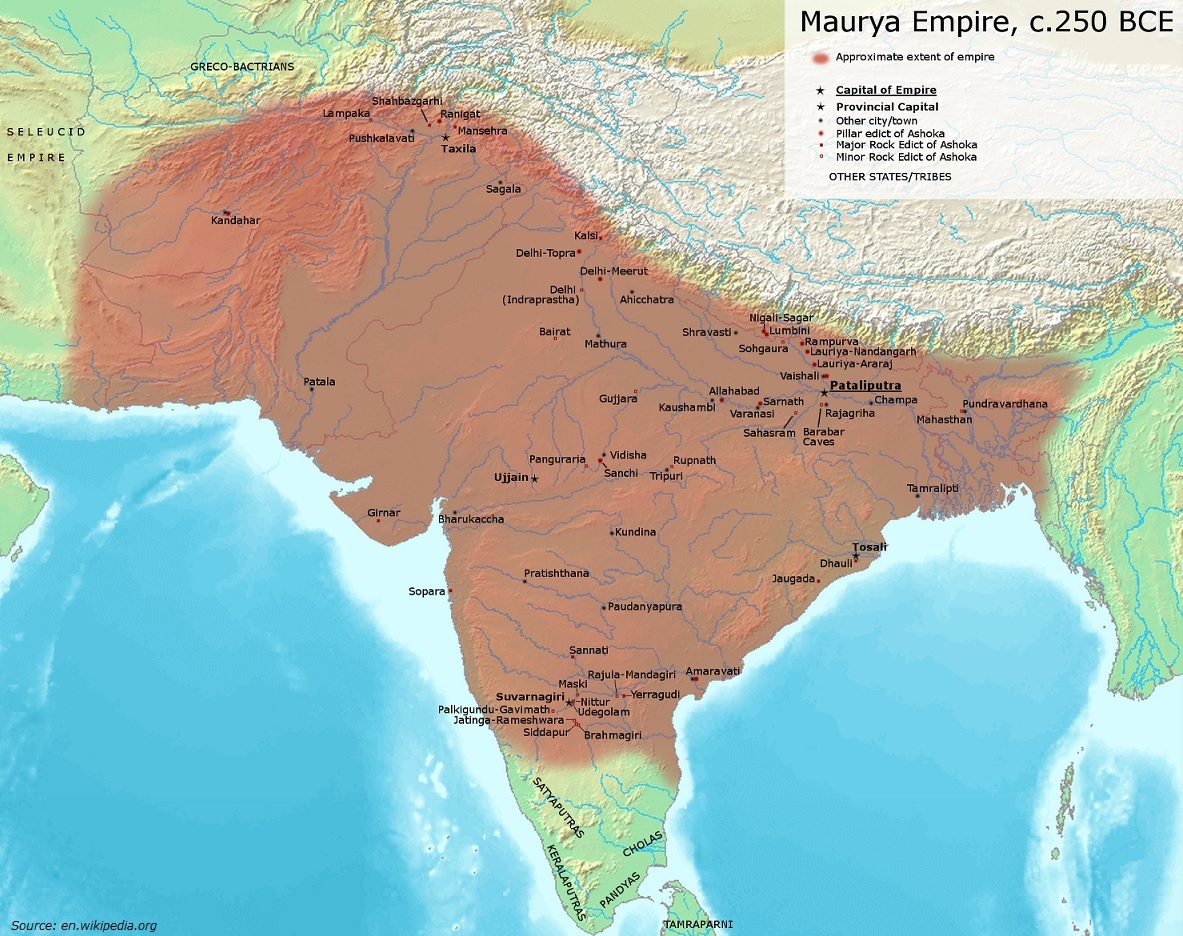
The Mauryan Empire was the first largest empires that ever established on Indian soil till 324 B.C.
The epigraphical sources, literary sources, foreign accounts, and other materials obtained from the archaeological excavations describe the greatness of the Mauryan rulers and vast extensions of their empire.
The Mauryan Empire was spread from the valley of the Oxus (present Amu River) to the delta of Kaveri.
Chandragupta Maurya was the first ruler who unified entire India under one political unit.
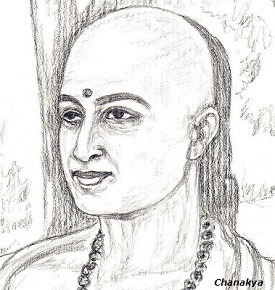
The detailed information about the administrative system of the Mauryan Empire is mentioned in Arthashastra. It is a book written by Kautilya. He was also known as Chanakya.
Kautilya was the Prime Minister of Chandragupta Maurya. He was considered as the real architect of the Mauryan Empire.
Megasthenese came in the court of Chandragupta Maurya as an ambassador of the Seleucus (the king of Greek).
Megasthenese has given detailed accounts of India and Indian people in his book Indica. Though the original book is lost; however, historians extracted Megastheneses description through the quotations in the works of the later Greek writers.
The inscriptions of the great Ashoka are the most important and authentic source for the history of Mauryan period.
Chandragupta Maurya
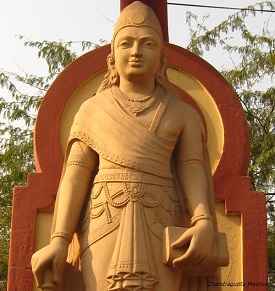
Chandragupta Maurya had ruled during the period of 324-300 B.C.
The Buddhist literature, the Mahavamsa and Dipavamsa give a detail account of Chandragupta Maurya.
Chandragupta Maurya has been described as a descendant of the Kshatriya clan of the Moriyas branch of Sakyas. They lived in Pipphalivana, in eastern Uttar Pradesh.
The Mudrarakshasa is a play written by Vishakhadatta, referred Chandragupta as Vrishala and Kulahina, which means a person of humble origin.
According to Buddhist Traditions
Chandragupta's father was killed in a battle and he was brought up by his maternal uncle.
Chanakya observed the signs of royalty in the child Chandragupta and took him as his pupil. He took him at Taxila for his education and training. Taxila, at that time, was a great center of learning.
The Greek sources described that while he was in Taxila, Chandragupta had seen Alexander in a course of the Punjab campaign. However, the reliable details of Chandragupta's conquests and empire building process are not available.
According to Greek and Jain Sources
Chandragupta took advantage of the disturbances caused by the invasion of Alexander and his sudden death in 323 B.C. in Babylon.
With the help of Kautilya, Chandragupta raised a large army and launched campaigns. He first overthrew the Greek kshatrapas ruling in the region of north-western India.
Greek writer Justin, writes, "India after the death of Alexander, had shaken, as it were, the yoke of servitude from its neck and put his Governors to death, and the architect of this liberation was Sandrocottas.
The Sandrocottas mentioned in the Greek literature has been identified with Chandragupta Maurya.
After liberating north-western India from the Greek rule, Chandragupta turned his attention towards the conquest of Magadha (where Nanda was the Emperor). However, the details of this conquest are not known.
According to Parisistha-parvam (the Jain text), Chandragupta with the help of Chanakya, defeated the Nanda king and captured his empire and became the great ruler of Magadha empire.
Ashoka and his father Bindusara (son of Chandraguptha Maurya) did not make any conquest in south India. Therefore, it was Chandragupta Maurya who made it.
The Junagarh rock inscription describes that a dam for irrigation was constructed on the Sudarshana Lake by Pushyagupta, a provincial governor of Chandragupta Maurya.
Inscriptions of Ashoka found at Girnar hills in Junagarh district in Gujarat and at Sopara, in Thane district in Maharashtra reflect that these areas were under the rule of Mauryan Empire.
In south India, Ashoka's inscriptions have been found at Maski, Yerragudi, and Chitaldurga in Karnataka.
Rock Edict II and XIII of Ashoka explain that Chandraguptas immediate neighboring states (in the south) were Cholas, Pandyas, Satyaputras, and Keralaputras.
The Jain tradition confirms that in his old age, Chandragupta abdicated the throne and retired to Shravanabelagola in Karnataka with his teacher Bhadrabahu (a Jain ascetic).
Local inscriptions of the later period mentioned that Chandragupta gave up his life as a Jaina devotee by fast unto death at a hill, which later on called as Chandragiri, seems to be named after him.
In about 305 B.C. Chandragupta defeated the army of the Greek Kshatrapa Seleucus who had succeeded Alexander in the eastern part of his empire.
The Greek writers stated that a treaty was concluded between Seleucus and Chandragupta in which Seleucus accepted the territories of Kandahar, Kabul, Herat, and Baluchistan and Chandragupta presented him 500 elephants.
The treaty was followed by a matrimonial alliance between the two in which Seleucus married his daughter to Chandragupta Maurya or to his son Bindusara.
Seleucus sent Megasthenese as his ambassador to the court of Chandragupta.
Plutarch writes, "Sandrocottas who had by that time mounted the throne overran and subdued the whole of India with an army of 600,000".
It is clear that Chandragupta had established a vast empire extended from Afghanistan in the west to Assam in the east and from Kashmir in the north to Karnataka in the south. The entire country except Kalinga was under his rule.
Bindusara (son of Chandragupta), did not make any conquests. Thereafter, Ashoka (son of Bindusara) is said to have added only Kalinga to the Mauryan-empire.
Chandragupta Maurya had ruled for 24 years i.e. from 324 B.C. to 300 B.C.
Bindusara (300-273 B.C.)
Bindusara, the son of Chandragupta Maurya, ascend to throne after his father.
According to the Tibetan historian, Taranath, Chanakya continued as a minister of Bindusara after Chandragupta Maurya. Hemachandra, Jain scholar, also confirms this fact.
Divyavadana mentions that Bindusara appointed his eldest son Sumana (or Susima) as his viceroy at Taxila and Ashoka at Ujjain. It also mentions that when a revolt broke out at Taxila, Ashoka was sent to restore peace as Susima fails to suppress it.
Bindusara continued his policy of friendly relations with Hellenic world.
Dionysius was the Egypt ambassador came to the court of Bindusara.
Pliny mentions that Ptolemy Philadelphus, king of Egypt sent him as an ambassador.
Bindusara had been given the credit of south Indian conquest, but most of the scholars believe that this was done by his father Chandragupta Maurya.
Ashoka (273-232 B.C.)
Ashoka succeeded to the throne after the death of his father Bindusara in 273 B.C.
-
According to the Buddhist tradition,
Janapada Kalyani or Subhadrangi was his mother.
He was appointed as a viceroy of Ujjain and Taxila while he was a prince.
Ashoka was very cruel in his early life and captured the throne after killing his 99 brothers. But it appears an exaggerated figure.
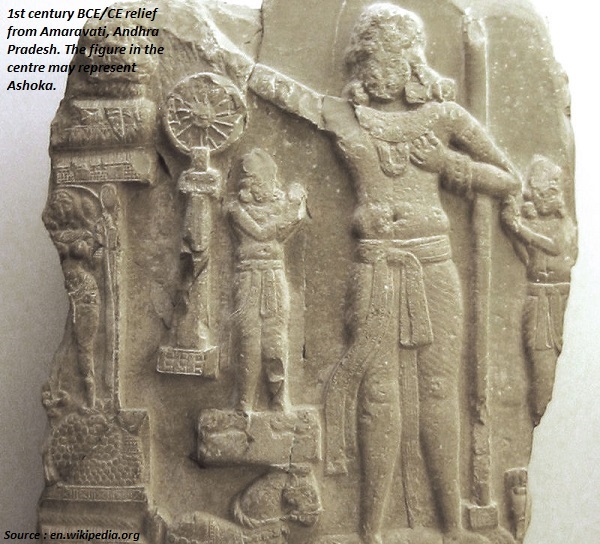
Ashoka himself speaks affectionately about his brothers, sisters, and relatives in his edicts.
Ashoka was the first king in the Indian history who has left his records engraved on stones.
The history of Ashokas reign can be reconstructed with the help of his inscriptions and some other literary sources.
The Ashokan inscriptions are found at 47 places in different regions of India, Nepal, Pakistan, and Afghanistan.
The inscriptions on rocks are called as the Rock Edicts, and those on Pillars, Pillar Edicts.
Ashokas name occurs only in copies of Minor Rock Edict-I found at three places in Karnataka and one in Madhya Pradesh. Whereas in all other inscriptions, he mentioned himself as Devanampiya and Piyadasi meaning beloved of the gods.
-
Ashoka s inscriptions were written in four different scripts, namely −
Greek languages and scripts used in Afghanistan area;
Aramaic languages and scripts used in west Asia;
Prakrit language and Kharosthi script used in Pakistan area; and
Prakrit language and Brahmi script used in rest of the inscriptions.
Kalinga War and its Impact
The Rock Edict XIII describes brightly the horrors and miseries of Kalinga war and its impact on Ashokas life.
The Rock Edict XIII describes that one lakh people were killed in this war, several lakhs perished and a lakh and a half were taken prisoners.
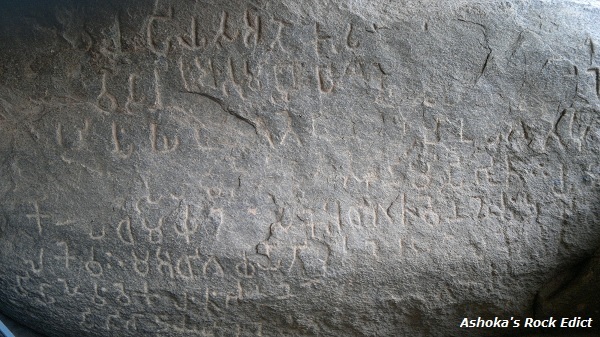
These figures might be exaggerated, but it is clearly mentioned that this war had a devastating effect on the people of Kalinga. Likewise, this became the last battle fought by Ashoka.
The panic of war completely changed the personality of Ashoka. He felt great regret for the killings of the war. He left the policy of aggression and adopted the policy for the welfare of people and animals.
Ashoka sent ambassadors of peace to the Greek kingdoms in west Asia and several other countries.
Ashoka did not pursue the policy of peace for the sake of peace and under all conditions.
Rajjukas was a class of officers appointed within the empire not only for rewarding people, but also punishing them if required.
Ashoka's Dhamma
Ashoka's personal religion was Buddhism.
In Bhabru rock edict, he says that he had full faith in Buddha, Dhamma, and Sangha.
Ashoka accepted Buddhism as his main faith, but he never forced Buddhist ideals on his subjects.
Ashoka believed in unity among ethical and moral values of all sects. He showed great respect to all sects and faiths.
In Rock Edict XII Ashoka says, "I honor all sects and both ascetics and laymen, with gifts and various forms of recognition". He pronounced his policy of equal respect to all religious sects very clearly.
After the Kalinga War, the propagation of Dhamma became the utmost objective for Ashoka.
Ashoka's edicts explained Dhamma as a 'Moral Law', a 'Common Code of Conduct, or an 'Ethical Order'. Further, he says that it is not a religion or a religious system.
In Pillar Edict II, Ashoka puts a question to himself: "What is Dhamma?" Then he mentioned the two basic constituents of Dhamma as less evil and many good deeds.
Ashoka explains evils as rage, cruelty, anger, pride, and envy that are to be avoided.
Ashoka explains many good deeds as kindness, liberality, truthfulness, gentleness, self-control, purity of heart, attachment to morality, inner and outer purity. These good qualities are to be pursued ardently.
-
Ashoka, in his Rock Edict XII, prescribes the following codes to be followed −
Obedience to mother and father, elders, teachers and other respectable persons.
Respect towards teachers.
Proper treatment towards ascetics, relations, slaves, servants and dependents, the poor and miserable, friends, acquaintances, and companions.
Liberality towards ascetics, friends, comrades, relatives, and the aged.
Abstention from killing of living beings.
Non-injury to all living creatures.
Spending little and accumulating little wealth.
Mildness in a case of all living creatures.
Truthfulness.
Attachment to morality.
Purity of the heart.
Dhamma is a code for moral and virtuous life. He never discussed god or soul or religion.
Ashoka implanted a moral law i.e. Dhamma as the governing principle in every sphere of life.
-
Ashoka practiced all these principles of Dhamma and asked his countrymen to −
have control over their passion;
cultivate purity of life and character in innermost thoughts;
learn other religions;
abstain from killing or injuring animals; and
have regard for them;
be charitable to all;
be respectful to parents, teachers, relatives, friends, and ascetics;
treat slaves and servant kindly; and
tell the truth.
Ashoka not only preached, but had actually practiced these principles. He gave up hunting and killing of animals.
Ashoka made liberal donations to the Brahmans and ascetics of different religious sects.
Ashoka established hospitals for humans and animals and constructed rest-houses. He also ordered wells to be dug and trees to be planted along the roads for welfare of the people.
Ashoka adopted Buddhism after observing the brutality of the Kalinga war.
Non-violence and non-injury to living beings is the cardinal doctrines of Buddhism.
Ashoka appointed a special class of officials called Dharmamahamatras whose sole responsibility was to propagate Dhamma among the people.
Ashoka conducted Dharmayatras (religious journey) and instructed his officials to do the same.
To propagate Dhamma, he sends his missionaries to western Asia, Egypt, and Eastern Europe.
-
Some of the foreign kings from whom Ashoka received the message of Buddhism were −
Antiochus Theos of Syria
Ptolemy Philadelphus of Egypt
Antigonus Gonatas of Macedonia
Megas of Cyrene
Alexander of Epirus
Ashoka sent his son Mahendra and daughter Sanghamitra to propagate Buddhism in Sri Lanka.
Decline of Mauryan Empire
Ashoka ruled for almost 40 years and died in 232 B.C.
Soon after Ashokas death, the empire broke up and the decline of the Mauryan Empire set in.
In a period of about 50 years after Ashokas death, seven kings followed him in succession
The empire was divided into an eastern and western part. The western part was governed by Kunala, Samprati and others.
The eastern part with southern India was governed by six successors of Mauryan kings from Dasarath to Brihadratha. They were having their capital at Pataliputra.
The power and prestige of the Mauryan Empire were challenged by Andhras (in the south India) and continuous attacks of Greek king in the west.
The king Brihadratha was killed by Pushyamitra who was the commander-in-chief of the army.
The incident of the killing of the king in full view of the public, and in the presence of his army clearly reflects that the king neither enjoyed the loyalty of his own army nor the sympathy of the people.
This is the only recorded incident in the history of India till the 12th century A.D., wherein the king was murdered and replaced.
Pushyamitra ascended the throne, but he never declaring himself as the king rather retained the title of the Senapati.
In a very dramatic way, the Mauryan Empire declined and disappeared just in 50 years after the death of Ashoka.
Society and Economy during Mauryas
Society and Culture during the Mauryas were well classified and organized; work of every class was decided accordingly.
Classes of Society
-
Megasthenese mentioned that during this period, the society was comprising seven castes, namely −
Philosophers,
Farmers,
Soldiers,
Herdsmen,
Artisans,
Magistrates, and
Councilors
Megasthenese, however, failed to comprehend the Indian society properly and confused among the terms jati, Varna, and the occupation.
Chaturvarna system continued to govern the society.
The urban way of life developed and the craftsmen enjoyed a high place in the society.
Teaching continued to be the main job of the Brahmans.
Buddhist monasteries were developed as important educational institutions. Taxila, Ujjayini, and Varanasi were famous educational centers.
Technical education was generally provided through guilds, where pupils learnt the crafts from the early age.
The joint family system was the norm in the domestic life.
A married woman had her own property in the form of bride-gift (stree-dhana).
The widows had given respect in the society. All stree-dhana (bride-gift and jewelry) belongs to her. Offences against women were severely dealt with.
Kautilya also laid down penalties against officials, in charge of workshops and prisons who misbehaved with women.
Megasthenese mentioned that slavery did not exist in India.
Economy
Largely, the population was agriculturists and lived in villages. The state helped people to bring new areas under cultivation by cleaning the forest. But certain types of forests were protected by law.
A number of crops like rice, coarse grains (kodrava), sesame, pepper, and saffron, pulses, wheat, linseed, mustard, vegetable and fruits of various kinds and sugarcane were grown.
The state also owned agricultural farms, cattle farms, dairy farms, etc.
Water reservoirs and dams were built by the state for irrigation. Steps were taken to distribute and measure this water for irrigation.
The Mauryan enforced the rules and regulations in respect of agriculture, industry, commerce, animal husbandry, etc.
Special measures were deduced for the promotion of the economy gave great impetus to economic development during this period.
Megasthenese mentioned about the extraordinary skill of craftsmen.
Junagarh inscription of Rudradaman mentions that Pushyagupta (Chandragupta's governors) was responsible for building a dam on Sudarshana Lake near Girnar in Kathiawad.
Skandaguptas inscription of the later period mentioned that the dam (on Sudarshana Lake) was repaired during his reign, almost 800 years after its construction.
They had foreign trade with the western countries. The main items of trade were indigo, various medicinal substances, cotton, and silk. The foreign trade was carried on by the land as well as by the sea.
Special arrangements were made for facilitation of the trade like security of trade-routes, provisions of warehouses, go-downs, and other means of transport.
The trade was regulated by the state and the trader had to get a license to trade.
The state also had the machinery to control and regulate the weights and measures.
The land tax was one-fourth to one-sixth of the produce. The tax was also levied on all the manufactured goods.
The toll tax was levied on all items, which were brought for sale in the market.
Strabo mentions that craftsmen, herdsmen, traders, and farmers, all paid taxes. Those who could not pay the tax in cash or kind were to contribute their dues in the form of labor.
Revenue was that main subject of Arthashashtra. It describes revenue at great length.
Sources of revenue were increased from the income of mines, forests, pasture lands, trade, forts, etc.
The income from the king's own land or estate was known as sita.
Brahmans, children, and handicapped people were exempted from paying the taxes.
Tax evasion was considered a very serious crime and offenders were severely punished.
The artisans and craftsmen were given special protection by the state and offences against them were severely punished.
The main industries during this period were textile, mining and metallurgy, ship-building, jewelry making, metal working, pot making, etc.
The industries were organized in various guilds. Jesthaka was the chief of a guild.
The guilds were powerful institutions. It gave craftsmen great support and protection.
The guilds settled the disputes of their members. A few guilds issued their own coins.
The Sanchi Stupa inscription mentions that one of the carved gateways was donated by the guilds of ivory workers.
Similarly, the Nasik cave inscription mentions that two weaver's guilds gave permanent endowments for the maintenance of a temple.
The guilds also made donations to educational institutions and learned Brahmans.
Art and Architecture
Art and architecture had developed substantially during the Mauryan period.
-
The main examples of the Mauryan art and architecture are −
Remains of the royal palace and the city of Pataliputra;
Ashokan pillars and capitals;
Rock cut Chaitya caves in the Barabar and Nagarjuni hills;
Individual Mauryan sculptures and terracotta figurines; etc.
Megasthenese had described in detail about the famous city of Pataliputra (modern Patna). He describes it as it was stretched along the river Ganga in the form of a parallelogram. It was enclosed by a wooden wall and had 64 gates.
Excavations have brought to light remains of palaces and the wooden palisade.
The Mauryan wooden palace survived for about 700 years.
Fa-Hien also saw it at the end of the 4th century A.D.
The palace and also the wooden palisade had been destroyed by the fire. The burnt wooden structure and ashes have been found from Kumrahar.
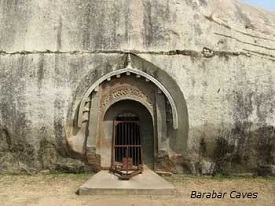
Seven rock-cut caves in the Barabar and Nagarjuni hills were built during this period.
The inscription says that after having received his training in writing, mathematics, law, and finance, Kharavela ascended the throne of Kalinga in his 24th year.
Kharavela spent the first year in rebuilding the capital of Kalinga.
Kharavela invaded the kingdom of Magadha in the 8th and 12th years of his reign.
The inscription mentions the achievements of Kharavela only up to the 13th year of his reign.
Mauryan Governance
Mauryan Empire was the largest empire in the whole of the ancient world. It was governed by a centralized form of government.
Kautalyas Arthashastra, Ashokas inscriptions, and Megasthenese's accounts collectively are the important sources of the information on various aspects of administration, economy, society, and religion of the people.
Polity and Administration
The king was the head of the state. The king used to issue ordinances known as Sasana. He possessed the judicial, the legislative, and the executive powers.
Sasanas are available in the form of Edicts of Ashoka.
The Mauryas king had to follow the law of the country given by law givers and had to govern according to the customs of the land. He could not do whatever he liked.
The king was assisted in administration by Mantriparishad, which was a Council of Ministers.
Adhyakshas (superintendent) were officers who performed a special task.
Kautilya mentioned a large number of Adhyakshas, such as Adhyakshas of gold, store houses, commerce, agriculture, ships, cows, horses, elephants, chariots, infantry, passports etc.
Yukta was the officer in-charge of the revenues of the king.
Rajjukas were the officers for land measurement and fixing their boundaries. They were also given power to punish the guilty and set free the innocents.
The Mauryan Empire was divided into provinces. Pradeshikas was another officer of the Mauryan administration. He was the provincial governor.
Bindusara appointed his son Ashoka as Governor of the Avanti region and posted him at Ujjain.
Asokas elder brother Susima was posted at Taxila as the Governor of the northwestern provinces.
The important provinces were directly under Kumaras (princes); however, the total number of provinces is not known.
Junagarh rock inscription of Rudradaman mentions that Saurashtra (Kathiawar) was governed by Vaisya Pushyagupta at the time of Chandragupta Maurya and by Yavana-raia Tushaspa at the time of Ashoka, both were the provincial governors.
The Mauryan kingdom was divided into different provinces, which were subdivided into the districts and each district was further divided into groups of five to ten villages.
The village was the smallest unit of an administration.
The pradeshika was the head of district administration. He used to tour the entire district every five years to inspect the administration of areas under his control. A group of officials worked in each district under him.
Gramika was the head of the village. He was assisted in village administration by the "village elders".
The villages, during this time, enjoyed substantial autonomy. Most of the disputes of the village were settled by Gramika with the help of village assembly.
The Arthashastra mentions the highest salary being 48,000 Panas and the lowest 60 Panas. There was a wide range of scales in salary.
City Administration
The Arthashashtra has a full chapter on the administration of cities.
The Edicts of Ashoka also describe name of the cities such as Pataliputra, Taxila, Ujjain, Tosali, Suvarnagiri, Samapa, Isila, and Kausambi.
Megasthenese had described the administration of Pataliputra in detail.
Megasthenese described that Pataliputra city was administered by a city council comprising 30 members. These 30 members were divided into a board of 5 members each.
-
Each of the 5 member boards had specific responsibilities towards the administration of the city. For example −
One such board was concerned with the industrial and artistic produce. Its duties included fixing of wages, check the adulteration etc.
The second board dealt with the affairs of the visitors, especially foreigners who came to Pataliputra.
The third board was concerned with the registration of birth and death.
The fourth board regulated trade and commerce, kept a vigil on the manufactured goods and sales of commodities.
The fifth board was responsible for the supervision of manufacturing of goods.
The sixth board collected taxes as per the value of sold goods.
The tax was normally one-tenth of the sold goods.
Officers were appointed by the City council and accountable for the public welfare such as maintenance and repairs of roads, markets, hospitals, temples, educational institutions, sanitation, water supplies, harbors, etc.
Nagaraka was the officer in-charge of the city.
There were numerous departments that regulated and controlled the activities of the state.
Kautilya mentions several important departments such as accounts, revenue, mines and minerals, chariots, customs, and taxation.
Early History of South India
During the 1,000 B.C., the present states of Tamil Nadu and Kerala (in southern India) were inhabited by megalithic people.
The important phase of the ancient history of south India is from the Megalithic period to about A.D. 300.
Megalithic Phase
The literary meaning of the term megaliths is big stones i.e. mega means big and lit means stones. But the big stones are not associated with the megalith culture.
The megalithic culture is known for its burials.
The abundance of iron tools and a Black-and-Red pottery with the burials is the main identifying features of the megalithic culture.
The megalithic culture suggests that there was an abrupt change from the Neolithic stage into the Iron Age. And, they did not experience the intermediate Chalcolithic or Bronze Age.
Types of Megalithic Burial
The following are the major types of Megalithic burial −
Pit Circle Graves − In this type of burial, the body was first excoriated and then buried. Pots and iron artifacts were placed in a grave. A stone circle is erected around the pit.
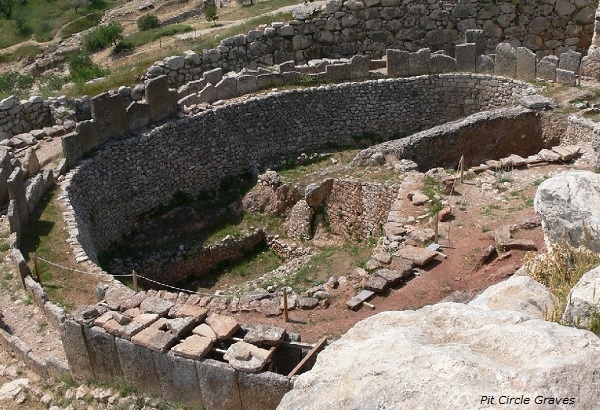
Cists − These graves have a variety of forms. Cists which is stone coffin were made out of granite slabs with one or more capstones, with or without portholes. Cists are fully buried, half buried, or even on the bare rocks. They may contain single or multiple burials. A single or multiple stone circles erected around the cists.
Laterite chambers − In Malabar region, the grave-chambers excavated into laterite instead of granite slabs.
Alignments − It is a different kind of burial in which a large number of standing stones called Menhirs were arranged in squares or diagonals shape. They have been found in Gulbarga district and south of Hyderabad. However, in Kashmir, Menhirs have been found arranged in a semi-circle.
Sacrophagi − These legged urns of terracotta sometimes have animal heads and are not very common.
Urns − The practice of burying excoriated bones in urns seems to be taken from the Neolithic past. They are marked by capstones or stone circles, found mainly on the eastern coast.
Megalithic Tools
Undoubtedly, there was a wide range of variety in Megalithic construction, but the typical identity was a Black-and-Red ware and distinctive iron tools. They have uniformity all over the peninsula.
The pottery shapes include conical or looped lids, carinated vases, pedestalled bowls, spouted dishes, etc.
The iron tool includes axes with crossed straps, sickles, tripods, tridents, spearheads, swords, lamp hangers, arrowheads, and lamps.
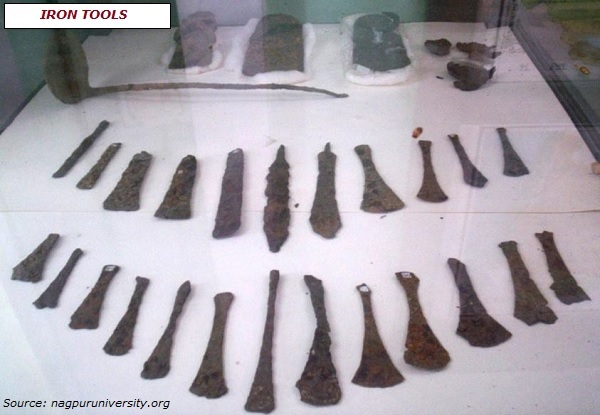
Horse-harness bits and bells are also common finds.
Iron Age, in the history of India, is a period when the use of iron for tools and weapons became common, but during this time, the dated literature also began to be written. Therefore, the period of Megalithics marked a point in time where prehistory ends and history begins.
The builders of these Megalithics remain unknown to northern people because no reference to these monuments has been traced in Sanskrit or Prakrit literature though the early Tamil literature does contain descriptions of these burial practices.
Sources of Megalithic Period
-
The earliest account about the people and kingdoms of the area are preserved in three forms
Ashokan inscriptions;
Sangam literature; and
Megasthenese's accounts.
The Rock Edict II and XIII of Ashoka described the southern kingdoms of Chola, Pandya, Satyaputra, Keralaputra, and Tambapanni.
Ashoka's kindness to these neighboring states has been very much proved by the fact that he made provisions for medicines and food items etc. for animals and humans of these kingdoms.
In the Hathigumpha inscription of Kharvela, it has been found that Ashoka was credited for defeating a confederacy of Tamil states.
A detailed description of south Indian states is found in Sangam literature belonging to the first four centuries of the Christian era.
The Tamil language is the oldest among the spoken and literary languages of south India. Sangam literature was written in this language.
The Pandyan kings assembled literary assemblies called as Sangam.
Sangam literature consisted the collection of verses, lyrics, and idylls, which were composed by poets and scholars.
Sangam literature preserves folk memory about the society and life (in south India) between the 3rd Century B.C. and 3rd century A.D.
Age of Smaller Dynasties
Apart from some important dynasties ruling in the post-Mauryan period in north India, there were a number of republics ruling smaller states. The information about these small dynasties is extracted from their coins on which their names were written.
-
Following are some of the important small dynasties −
Arjunayanas,
Malavas,
Audumbaras,
Kunindas,
Yaudheyas, etc.
Most of these dynasties (enumerated above), later on, became tributaries of the Gupta Dynasty and vanished altogether after the fourth century A.D.
Satavahanas of Deccan
Before the emergence of the Satavahanas in Maharashtra and Cholas, Cheras and Pandyas dynasties were ruled southern India the region was settled by megalithic people.
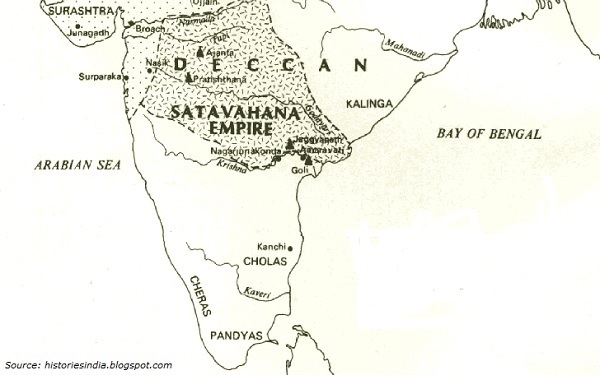
The Satavahanas, also known as Andhras (in Deccan region) covering the parts of Andhra Pradesh and Maharashtra was a powerful dynasty.
The Andhras were ancient people and were mentioned in the Aitareya Brahmana also.
The Greek writer Pliny mentions that the Andhras were powerful people who possessed a large number of villages and thirty towns, an army of one lakh infantry, two thousand cavalries and one thousand elephants.
During the Mauryan age, they were part of the Mauryan Empire, but it appears that immediately after the fall of the dynasty, the Andhras declared themselves free.
Simuka dynasty ruled from 235 B.C. to 213 B.C. and established Simuka dynasty.
Simuka was succeeded by his brother Krishna.
Satakarni-I was the third king. He made extensive conquests and performed two Ashvamedhayajna. The Nanaghat inscription described his achievements in details. He conquered western Malwa, Vidarbha, and Anupa (Narmada Valley). He is also referred to as the lord of Dakshinapatha.
Satakarni-Is name also occurs on one of the gateways of Sanchi stupa because substantial donations were made by the Satavahanas for the renovation and decoration of Sanchi stupas and monasteries.
Satakarni-II ruled for about 56 years.
Gautamiputra Satakarni gained Malwa from the Sungas.
Nahapana had conquered the part of Satavahana territory after Satakarni-II. A large number of coins of Nahapana has been found in Nasik area.
The Satavahanas became powerful again during the reign of Gautamiputra Satakarni. His achievements are recorded in glowing terms in the Nasik inscription of Queen-mother, Gautami Balasri. This inscription was engraved after his death and in the nineteenth year of the reign of his son and successor Pulmavi II.
In Nasik inscription, Gautamiputra Satakarni has been described as one who destroyed the Sakas, Yavanas, and Pahlavas. He overthrew Nahapana and restricted a large number of his silver coins. He also recovered northern Maharashtra, Konkan, Vidarbha, Saurashtra, and Malwa from the Sakas.
Satakarni dedicated a cave in Nasik in the eighteenth year of his reign and granted some land to ascetics in the twenty-fourth year.
Gautamiputra Satakarni is the first king bearing matronymic and this practice was followed by nearly all his successors.
Gautamiputra was succeeded by his son Vasisthiputra Sri Pulmavi in about A.D. 130 and ruled for about twenty-four years.
The coins and inscription of Pulmavi have been found in Andhra Pradesh. This shows that Andhra was the part of Satavahana Empire in the second century A.D. Perhaps, in order to save the Satavahana Empire from the onslaught of the Sakas, Pulmavi married the daughter of Saka ruler Rudradaman. But this Saka king defeated the next Satavahana ruler twice.
Sri Yajna Satakarni (A.D. 165-195) was perhaps the last of the great Satavahana rulers. His inscriptions have been found in Andhra Pradesh, Maharashtra, and Madhya Pradesh.
From the distribution of his coins, it appears that he ruled over a large kingdom extending from the Bay of Bengal in the east to the Arabian Sea in the west. Thus he regained the land that the Sakas had conquered from his predecessors.
Maritime trade and activities during his reign had been proved by the depiction of ship with a fish on his coins.
The successors of Yajna were weak and unworthy to govern such a large empire. Hence, the Satavahana Empire collapsed especially when Abhiras seized Maharashtra and Ikshvakus and Pallavas appropriated the eastern provinces.
Literature of Satavahana Period
There was political instability between the era of 500 years after the fall of the Mauryan Empire and before the rise of the Gupta Empire. This period is marked as the development of Dravidian languages and literature in the South India.
The Sanskrit language and various forms of Prakrit language developed and some distinctive literature was written in these languages.
The two great Epics, the Ramayana and the Mahabharata, were compiled. Besides, some of the Dharmasastra were also composed in this period.
Smritis
The Smritis have continued to play a very important role in Hindu life as it were playing since the last two thousand years.
The Smritis explained the religious duties, usage, laws, and social customs.
The Smritis are the expanded version of the Dharmasutras, which covered the period from (about) sixth century to third century B.C.
The Smritis compiled almost in the period of eight hundred years or even more.
-
Manusmriti is the oldest among all. It was composed in about the 1st century B.C. Other important Smritis are −
Naradasmriti,
Vishnusmriti,
Yajnavalkyasmriti,
Brihaspatismriti, and
Katyayanasmriti.
These Smritis (discussed above) are very important sources of law and social customs of the contemporary society and hence, declared to be of divine origin.
Mahabhasya written by Patanjali was the most outstanding work in the field of grammar during the period of 2nd century B.C.
The center of Sanskrit grammar learning shifted to the Deccan after Patanjali.
In Deccan, the Katantra School developed in the first century A.D. Sarvavarman composed the grammar of Katantra. He was a great scholar in the court of Hala (Satavahana King)
Katantras grammar was short and handy to help the learning of Sanskrit in about six months.
Hala, the King of Satavahana wrote a great poetical work, namely Gathasaptasati in Prakrit language.
-
Asvaghosha was an important literary figure of this period. He was a great Buddhist philosopher. He had written many poetry, plays, etc. Important of them are −
Saundarananda,
Buddhacharita,
Vajrasuchi, etc.
Buddhacharita was written in the form of Mahakavya. It is a complete life of Buddha. It has been translated into many languages of the world.
Remains of Asvaghosha's plays have been recovered from Turfan (in central Asia).
Svapnavasavadatta was written by Bhasa. It is famous Sanskrit play of the period.
The art of dance and drama had already been codified by Panini's time and mentioned by Kautilya and Patanjali.
Natyashastra was written by Bharata in the same period.
Milindapanho was written in Pali language. It explains the Buddhist doctrines in the form of a dialogue between Milinda and his teacher (the great Buddhist philosopher Nagasena). Milinda is generally identified with the Indo-Greek king Menander.
Sangam Literature
Tamil language is the oldest one among the south Indian languages. The earliest phase of Tamil literature is associated with the three Sangams.
Sangams were the societies of learned men established by the Pandya kingdom. Each Sangam comprises of a number of distinguished poets and learned scholars.
All literary works were submitted to these Sangams where learned scholars selected the best ones from different works and set their seal of approval.
The Sangam literature was compiled between A.D. 300 and 600.
Ettuttogai collection (the eight anthologies) is considered to be the earliest one belonging to 3rd century B.C. to 3rd century A.D.
Tirukkural written by Thiruvalluvar is the best of the minor didactic poems. Its teachings are considered as an everlasting inspiration and guide to the Tamilians.
Silappadikaram and Manimekhalali are the two Tamil epics. These are important sources for the construction of the early history of south India.
Society of Satavahana Period
Major system of society of Satavahana and other contemporary dynasties is largely followed from its predecessors.
Social Classes
Varna and Ashrama systems continued to govern the society.
-
The society consisted of four Varnas, namely −
Brahman,
Kshatriya,
Vaishya, and
Sudra.
Dharmasastras described the duties, status, and occupations of all the four Varnas.
Over a period of time, there was great increase in the number of mixed Jatis (castes).
Manusmriti defines the origin of the numerous mixed (sankara) Varnas.
Anuloma was the marriage between the male of higher Varna and the female of lower Varna.
Pratiloma was the marriage between the male of lower Varna and the female of higher Varna.
The social status of a person born of Anuloma was higher than Partiloma and they followed their father's occupation.
According to the Buddhist texts, mixed castes resulted from organizations like guilds of people following different arts and crafts.
The Buddhist texts described that a Kshatriya working successively as a potter, basket-maker, reed-worker, garland-maker, and cook. Setthi (Vaisya) working as a tailor and a potter without loss of prestige in both cases.
Kshatriyas of the Sakya and Koliya clans cultivated their fields.
The Vasettha Sutta refers to Brahmans working as cultivators, craftsmen, messengers, and landlords.
The Jatakas mentioned that Brahman pursuing tillage, tending cattle, trade, hunting, carpentry, weaving, policing of caravans, archery, driving of carriages, and even snake charming.
Jatakas story tells that a Brahman peasant as a supremely pious man and even a Bodhisattva.
The gradual absorption of foreigners like Indo-Greek, Sakas, Yavanas, Kushanas, and Parthians into the Indian society was the most important development of this period.
The life of an individual man was divided into four stages. The stages are called as Ashramas.
Stages of Life
-
The four stages of an individual life as mentioned in Dharmasutras are −
Brahmacharya − In this ashrama, a person lives a celibate life as a student at the home of his teacher.
Grihastha − After learning the Vedas, a student returns back to his home, gets married, and becomes a Grihastha (householder). Grihastha has manifold duties broadly marked out as (i) yajna (ii) adhyayana (iii) dana
Vanaprastha − In the middle age, after seeing his grandchildren; he leaves home for the forest to become a hermit.
Sanyas − Sanyas ashrama is the time meditation and penance; one frees his soul from material things. He leaves hermitage and becomes a homeless wanderer and thus, earthly ties have been broken.
Family Life
The joint family system was the main characteristics of the society.
The family was considered as the unit of the social system and not the individual.
Obedience to parents and elders was held as the highest duty for the children.
Marriage between the same Jatis was also preferred though intermarriage between different Jatis was prevalent.
The marriage in the same gotra and pravara is restricted.
-
Dharmasastras explained eight forms of marriage, namely −
Brahma Vivah,
Daiva Vivah,
Arsha Vivah,
Prajapatya Vivah,
Asura Vivah,
Gandharva Vivah,
Rakshasa Vivah, and
Paisacha Vivah.
Among all these eight (as discussed above), Paisacha Vivah is condemned by all the Dharmasatras.
Ideal marriage is one in which the father and guardian of the girls selected the bridegroom on an account of his qualifications.
The women hold an honorable position in the society and household.
-
Two classes of women students are mentioned as −
Brahmavadin or lifelong students of sacred texts and
Sadyodvaha who pursued their studies till their marriage.
Women not only attained good education, but also received training in fine arts like music, dancing, and painting.
Dharmasastras described that in the family property, all the sons had equal share, but a large number of Dharmasastras rejected the right of women to inherit.
Yajnavalkya lays down a list of priority in inheritance, which places the sequences as son, wife, and daughter.
The right of a wife to inherit if no sons were living, has been accepted by most of the ancient Indian authorities.
Women were allowed to have some personal property known as Stree-dhana in the form of jewelry, clothing, etc.
The Arthashastra mentioned that a woman can own money up to 2,000 silver panas and amount above this could be held by her husband in trust on her behalf.
Economy of Satavahana Period
Major economic system of Satavahana and other contemporary dynasties was well organized and systematic.
There was all round development in the field of agriculture, industry, and trade during this period.
Agriculture was the main occupation of a large section of the people.
The land was held by the individuals as well as by the state.
The gramakshetra was protected area by fences and field-watchmen against pests like birds and beasts.
Usually, the land holdings were small enough that could be cultivated by the individual family. But sometimes, the land holdings were big enough consisting of up to 1,000 acres.
The land outside the village is called arable land.
Beyond the arable land of the village lay its pastures, which were common for the grazing of cattle. The arid land also belonged to the state.
The forest was located on the boundary of the village.
Kautilya gives a complete scheme of village plan.
Land Classification
-
According to Kautilya, the land of the village was divided into −
Cultivated land,
Uncultivated land,
Grove,
Forest,
Pastures, etc.
The main crops were rice of different varieties, coarse grains, sesame, saffron, pulses, wheat, linseed, sugarcane, and mustard. Besides, a large number of vegetables and fruits were also grown.
Every village had artisans like carpenter, potter, blacksmith, barber, rope maker, washer man, etc.
Major Guilds
Eighteen types of guilds were mentioned in the literature.
Guilds became an important institution in the economy.
The guilds implemented and defined rules of work and controlled the quality of the finished product and its prices to safeguard both the artisans and the customers.
The disputes of the guild members were resolved through a guild court.
Guilds also acted as a banker, financier, and a trustee. Such functions were carried out by a different category of merchants known as Sresthies in north India and Chettis in south India.
Loans were given on security of gold and other things.
Money was lent for interest on promising rates to be renewed every year.
Nasik cave inscription mentioned that the interest rates on money deposited to guilds. The common rate of interest was between 12% and 15% per annum
Both internal and external trade was practiced in most of the parts of India since Mauryan period.
All the internal cities and ports were interconnected with a well-knit road system.
A large number of modern national highways were developed during this period including Grand Trunk road. The same road was further maintained and developed by Sher Shah Suri.
The discovery of monsoon winds in the first century facilitated foreign trade with Egypt as it reduced the distance between the western ports of India to the ports of Alexanderia in Egypt. Now the whole distance could be covered in forty days.
India's trade with Rome also increased enormously by sea as well as by land route, which is generally known as the silk route.
The account of the author of Periplus of Erythean Sea and Roman historians like Pliny and Ptolemy mentioned about the trading commodities.
Indian literature, both in Tamil and Sanskrit mentioned common items of trade were Indian spices, sandalwood, and other variety of woods, pearls, textiles of various types, sea products, metals, semi-precious stones, and animals.
Arikamedu was an important Roman settlement and trading station. It was located close to a port, which was excavated in 1945.
Romans paid for the goods mainly in gold currency.
A number of hordes of Roman coins found in the Deccan and south India indicates the volume of this trade (which was in favor of India).
Pliny, Roman historian mentioned that Indian trade was a serious drain on the wealth of Rome.
Technology of Satavahana Period
The technological advancement (in terms of art & architecture as well as science & technology) of Satavahana period was pretty advanced.
Art and Architecture
Taxila, Sakala, Bhita, Kausambi, Ahichchhatra, Patliputra, Nagrujunkonda, Amaravati, Kaveripattanam were well planned and developed cities, protected by fortification walls and moats.
Buddhism stupas at Sanchi, Amaravati, Bharhut, and Sarnath are the best examples of art and architecture that flourished during this period.
Stupa is a hemispherical dome or mound built over sacred relics either of the Buddha himself or of a sanctified monk or a sacred text. Buddha relics were kept in a casket in a smaller chamber in the center of the base of the stupa.
The stupa has a fenced path around called Pradakshinapatha.
The four gateways of Sanchi stupa built in the first century B.C. are extremely artistic and are one of the finest examples of art and architecture of India.
One of these gateways was donated by the Guild of ivory workers of Vidisa.
-
Rock-cut caves are another form of marvel architecture of this period. These rock-cut caves are of two types, namely −
A stupa and worshipping hall called as Chaitya and
Monastery called as Vihara.
Sculpture
Bharhut, Sanchi, Bodh Gaya, Mathura, Amaravati, Gandhara were the important centers of art activities during post Mauryan period.
The Mathura and Gandhara schools flourished during the Kushana period.
The Mathura school produced many fine specimens of sculptures that included the images of Brahmanical, Jain and Buddhist deities and the life size sculptures of Yakshas, Yakshini, and portraits of the kings. This form of art is popularly known as Gandhara School of Art, which portrays the Buddhist themes.
Stucco was a popular medium in Gandhara art. Furthermore, the monasteries of Afghanistan were decorated with an abundance of stucco images.
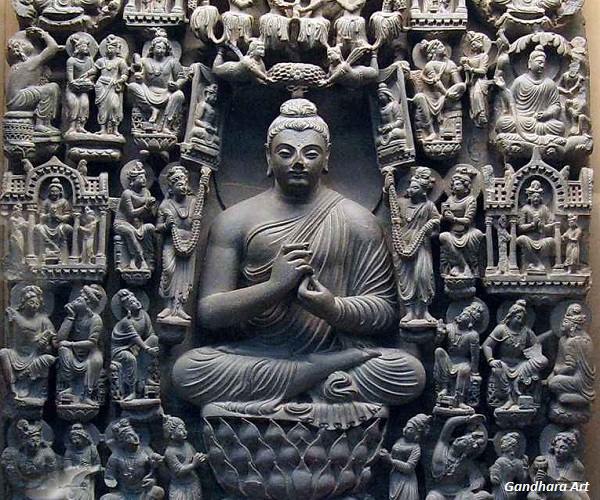
Gandhara artists created the images of Buddha in different postures and sizes. The large statues of Bamiyan Buddha were one of the finest examples of the Gandhara art of having produced the first image of Terracotta.
The most productive centers of art production were Ahichchhatra, Mathura, Kausambi, Bhita, Rajghat, Pataliputra, Tamralipti, Mahasthan, etc.
Science and Technology
Engineering skills were evident in this period as proved by the remains of famous dam built for the irrigation works during Chandragupta Maurya's period and repaired by Saka king Rudradaman.
Another remarkable structure is a complex of four water tanks at Shringaverapura, which reflects a very advanced level of hydraulic engineering.
In Shringaverapura structures, tanks were built of millions of bricks and water was brought from the river Ganga through a canal measuring about 250 mts in length and 38 mts in width. It had the capacity of about eighty lakh litres of water.
Indian astronomers had developed an elaborated astronomical system after modifying and adopting more accurate values by counting the periods of revolution of the sun, the moon, the five planets, and the two nodes, namely Rahu and Ketu.
Eclipses were also predicted with an accuracy.
Pancha Siddhantika written by Varahamihira, gives the summary of five schools of astronomy present in his time.
Medicinal System
The Indian medicinal system was based on the theory of three humors - air, bile, and phlegm the correct balance of these maintains a healthy body.
The medicinal system made remarkable progress during this period.
The surgical equipment commonly consisted of twenty-five types of knives and needles, thirty probes, twenty-six articles of dressing, etc.
Athaavnaaveda is the source of Ayurveda branch of medicine.
Medicine became a regular subject of study at higher centers of learning like Taxila and Varanasi.
Varanasi was specialized in surgery.
Sushruta Samhita is an encyclopedia of surgery. It was compiled by the great surgeon Sushruta at Varanasi.
Charaka Samhita was compiled by Charaka at Taxila; it contains mainly the teachings of Atreya, which were collected by his pupils.
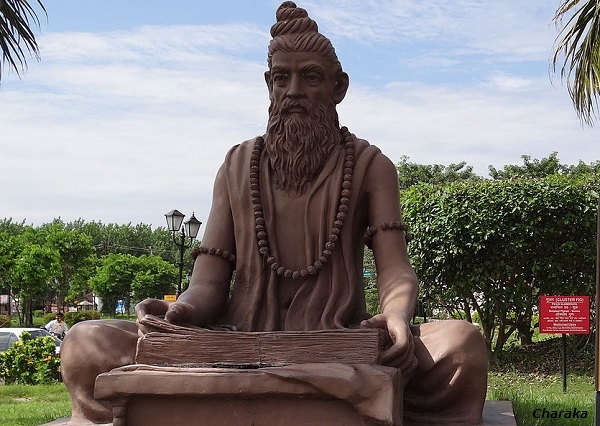
Charaka and Sushruta were the contemporaries of Kushana king Kanishka. The great works of Charaka and Sushruta reached as far as Manchuria, China, and Central Asia through translations in various languages.
Theophrastus gives details of the medicinal use of various plants and herbs from India in his book History of Plants.
This shows that the knowledge of Indian herbs and medicinal plants had reached the western world through Greeks and Romans.
Arabic translation of Charaka and Sushruta Samhitas in the 8th century A.D. influenced the Europeans and west Asian medicinal system during the middle age.
The large number of gold and silver coins-shows the purity of metal and craftsmanship of the period.
Ancient Indian History - Chola Dynasty
Three states, namely, Cholas, Cheras, and Pandya emerged in south India.
Sangam literature believes that the dynasties of Chola, Chera, and Pandya belong to immemorial antiquity.
Cholas
The Cholas have occupied the region of Kaveri delta and the adjoining area. The region of Kanchi was also part of the Cholas kingdom.
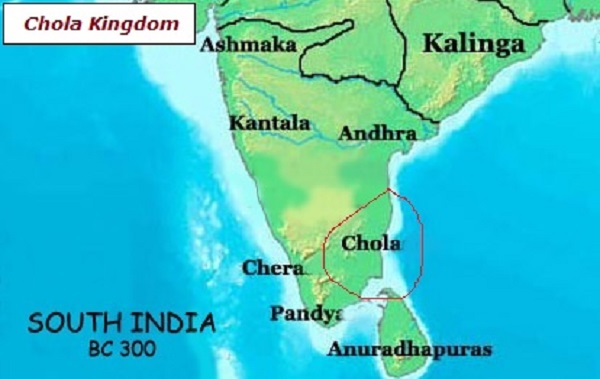
The Kingdom was situated towards the north-east of Pandya kingdom and it was also called as Cholamandalam in early medieval times.
In the beginning, its capital was Uraiyur in Tiruchirapalli, but subsequently shifted to Kaveripattanam. It was called as Puhar at that time.
A Chola king, known as Elara, conquered Sri Lanka and ruled over it for about 50 years during the middle of the 2nd century B.C.
-
Karikala was a famous Chola king of the early time. He was credited because of his two achievements −
He had defeated the joint forces of Chera and Pandya kings and
He successful invaded Sri Lanka and ruled there.
Karikala was defeated in a great battle at Venni near Tanjore by a confederacy of (about) a dozen rulers headed by Chera and Pandya kings.
Karikala maintained a powerful navy and conquered Sri Lanka.
Karikala built big irrigation channels and embankment about a 160 km along the river Kaveri.
Karikala fortified the town and the famous sea part of Puhar at the mouth of the Kaveri.
Karikala was a great patron of literature and education.
He was a follower of Vedic religion and performed many Vedic sacrifices.
The successors of Karikala were quite weak and family members squabbled for power and position therefore the Chola kingdom faced confusion and chaos after Karikala.
Illanjetcenni was the only king after Karikala who is known. He had captured two fortresses from the Cheras. However, after Karikala, the Chola empire declined and the Cheras and Pandyas extended their territories.
The Cholas were reduced to a small ruling family from about the 4th to the 9th century A.D.
Ancient Indian History - Pandya Dynasty
The Pandya kingdom was the second important kingdom in south India during this period. It occupied the region of modern districts of Tirunelveli, Ramnad, and Madurai in Tamil Nadu.
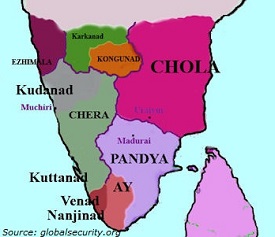
The capital of Pandya kingdom was Madurai. The Pandyan kingdom was very wealthy and prosperous.
The Sangam literature gives information and names of a few kings.
Nedunjeliyan was a great Pandya king. He defeated the combined forces of Chera, Chola, and five other minor states in a war against him at Madurai.
The Pandyan kings assembled literary assemblies called as Sangam.
Nedunjeliyan had performed several Vedic sacrifices. He may be taken to have ruled around A. D. 210.
The capital Madurai and the port city Korkai were the great centres of trade and commerce during the Pandyas reign.
The traders profited from trade with the Roman Empire.
Pandya kings even sent embassies to the Roman emperor Augustus and Trojan.
Ancient Indian History - Chera Dynasty
The Cheras were also known as Keralaputras in the history. The Chera kingdom occupied the region of a narrow strip between the sea and the mountains of Konkan range.
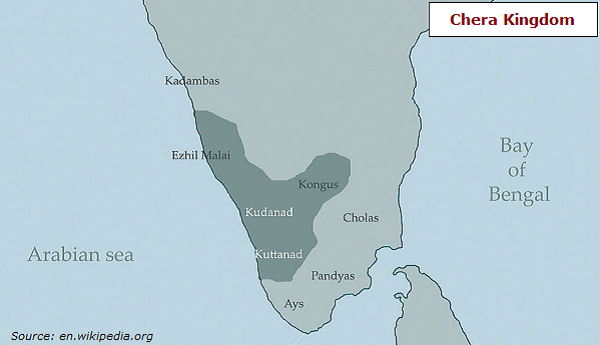
The Chera rulers also occupied high position in the history of south India. Nedunjeral Adan was a famous Chera king. He conquered Kadambas with his capital at Vanavasi (near Goa). He also defeated the Yavanas.
Nedunjeral Adan had a good relation with the Greeks and Romans who came in large numbers as traders and set up large colonies in south India.
Nedunjeral Adan fought a battle with the father of the Chola king Karikala. In this battle, both the kings were killed.
Nedunjeral Adan was called as Imayavaramban. The literary meaning of the term Imayavaramban is one who had the Himalaya Mountains as the boundary of his kingdom." However, it seems to be mere exaggeration.
Sengutturan was the greatest king of the Chera dynasty as mentioned in the Chera tradition. He had defeated the Chola and the Pandya kings.
The Chera power declined at the end of the 3rd century A.D. They again acquired power in the 8th century A.D.
-
The important facts about the three early kingdoms of south India are −
They constantly fought with each other;
They made new alliances against the ones who became powerful; and
They also fought regularly with Sri Lanka and ruled there at some point of time.
Period of Foreign Invaders
The invasion of Yavanas from the west was the important event in the history of ancient Indis. It started during the reign of Pushyamitra Sunga.
Kalidasa also mentions about Vasumitra's conflict with Yavanas in his book Malavikagnimitram.
Patanjali had also mentioned this invasion.
Originally, the word Yavana used for Ionian Greeks, but later it came to denote, all people of Greek nationality.
The Yavanas were the first ones to establish foreign supremacy on Indian soil.
The Yavanas came after several central Asian tribes who invaded India and established their political authority.
Indo-Greeks
The arrival of the Yavanas in India marked by their invasion on the western border of India.
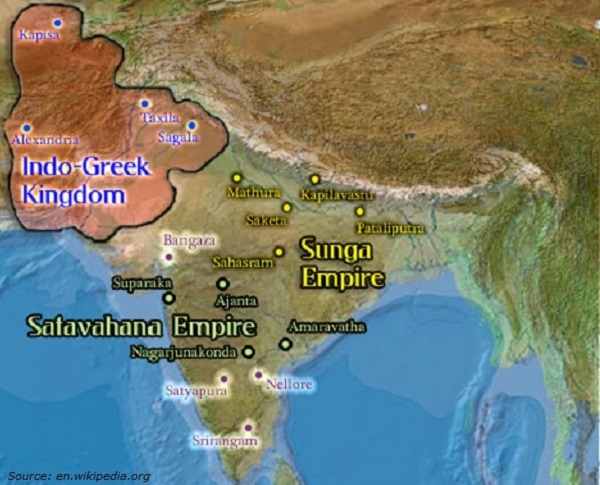
After Alexanders death, a large part of his empire came under the rule of his Generals.
Bactria and Parthia, the adjoining areas of Iran were two main areas under the rule of Alexanders Generals.
Diodotus, the governor of Bactria, revolted in about 250 B.C. against the Greeks and proclaimed his independence.
Euthydemus, Demetrius, Eucratides, and Menander were some important Indo-Greek kings.
Menander, during the 165-145 B.C., was most illustrious among all the Indo-Greek rulers. His capital was Sakala (modern Sialkot) in Pakistan and he ruled for almost twenty years.
Greek writers mentioned that Menander was a great ruler and his territory extended from Afghanistan to Uttar Pradesh in east and Gujarat in the west.
Menander was converted to Buddhism by Buddhist monk Nagasena.
Menander asked many questions related to philosophy and Buddhism to Nagasena. They were recorded together with Nagasena's answers in Milindapanho or the Questions of Milinda.
The Indo-Greek rulers were the first one in the history of India, whose coins carried the portraits of kings and their names.
Before the Indo-Greek rulers, the coins in India did not carry names or portraits of the kings and also Indo Greeks were the first rulers who issued gold coins.
Their coins are known for the depiction of realistic and artistic portraits.
Parthians
The Parthians were also known as Pahlavas. They were Iranian people. Few facts may be gathered from the coins and inscriptions. However, their history is not clear.
Vonones was the earliest king of the Parthian dynasty. He captured power in Arachosia and Seistan and adopted the title of "great king of kings".
Vonones was succeeded by Spalirises.
Gondophernes was the greatest of the Parthian rulers. He ruled from A.D. 19 to AD 45.
Gondophernes became master of the Saka-Pahalva area both in eastern Iran and north-western India for a short period.
After Gondophernes, the Pahlava rule in India ended. They were replaced by the Kushanas.
This fact is established by the excavations at Begram in Afghanistan where a large number of coins of Gondophernes was found.
Sakas
The Indo-Greek rule in north-western India was destroyed by the Sakas.
The Sakas are also known as the Scythians.
Sakas or Scythians were nomadic tribes originally from central Asia.
In about 165 B.C., Sakas were turned out of their original home by the Yueh-chi.
Yueh-chi later came to be known as Kushanas.
Sakas were also pushed out of their land and came to India.
The departure made by the central Asian tribes was the result of the prevailing situations in central Asia and adjoining northwestern China.
The construction of the Great Wall of China in the 3rd century B.C. left these tribes like Hiung-nu, Wu -sun and Yuehchi, no option but to move towards south and west.
The first migrants were Yueh-chi, they displaced Sakas.
The Sakas invaded Bactria and Parthia and thereafter entered India through the Bolan Pass.
-
The Sakas were divided into five branches and established themselves in various parts of north-western and northern India.
The first branch settled in Afghanistan.
The second branch settled in Punjab with Taxila as its capital.
The third branch settled in Mathura.
The fourth in Maharashtra and Saurashtra.
The fifth in central India with Ujjain as its capital.
The Sakas ruled in different areas from the 1st century B.C. to about 4th century A.D.
Therefore, Sakas ruled in different parts of the country. However, the branch of Sakas who ruled in central and western India rose to prominence.
Nahapana was the most prominent ruler of western India. His reference had been found in various inscriptions in Maharashtra and in the records of the Satavahanas.
Rudradaman the most illustrious ruler of the central Indian branch. He ruled from (about) A.D. 130 to 150.
Junagarh rock inscription was erected by Rudradaman.
Junagarh inscription mentioned that his rule extended over a vast territory including the areas of Gujarat, Sindh, Saurashtra, north Konkan, Malwa, and some parts of Rajasthan.
Rudradaman undertook the repairs of the Sudarsan lake dam. However, Sudarsan lake dam had been built by the provincial governer of Chandragupta Maurya in Kathiawad when it was damaged by heavy rains.
Ujjayini was the capital of Rudradaman. It became a centre of culture and education.
The Sakas dynasty came to an end with the defeat of the last king in the hands of Chandragupta II of the Gupta dynasty, in about A.D. 390.
Kushanas
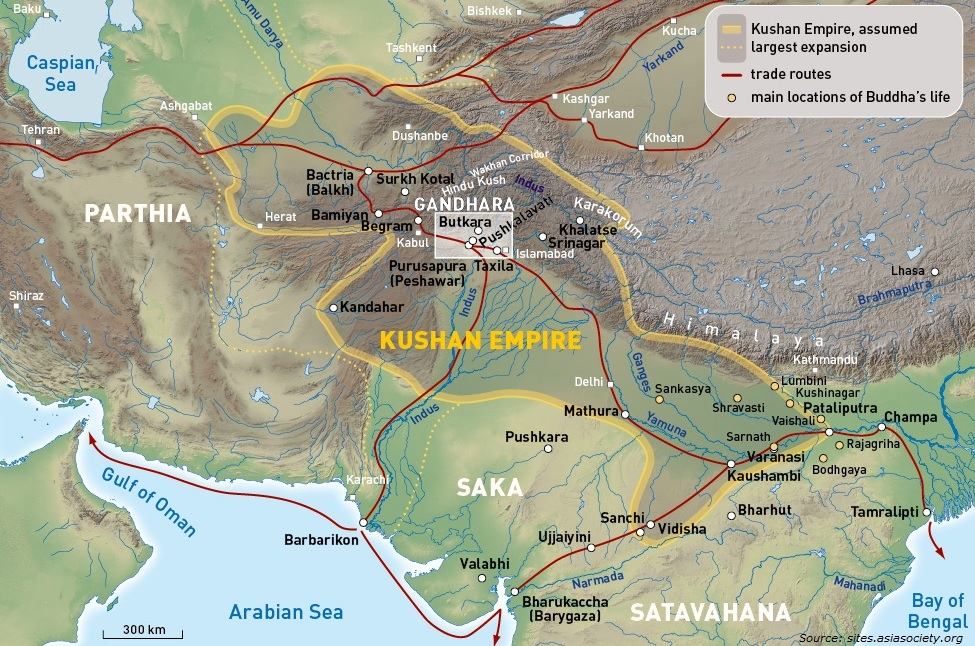
Yueh-chi were a nomadic tribe settled on the north-western border of China as per accounts of the Chinese historians.
Yueh-chi came in conflict with a neighbouring tribe known as Hiung-nu in the year 165 B.C. In this conflict, Yueh-chi were defeated and forced to move out of their land.
They could not move towards china in the east because of the China Wall; therefore, they moved toward the west and south.
-
In westwards movement, Yueh-chi came in conflict with another tribe called Wu-sun whom Yueh-chi defeated easily. Thereafter, Yueh-chi were divided into two groups as −
Little Yueh-chi migrated to Tibet.
Great Yueh-chi came to India.
Yueh-chi met with the Sakas who occupied the territory of Bactria after defeating Wusun.
The Saka's were defeated and forced to leave their land.
Saka's came to India and the Yueh-chi settled down in the land of the Sakas.
Yueh-chi people, lastly, gave up their nomadic life and adopted an agricultural and a settled way of life.
The great Yueh-chi branch was divided into five branches.
Chinese sources explained that the first great Yueh-chi king was Kujula Kadphises. He was also known as Kadphises I. He united all the five groups and established his authority over Afghanistan. He called himself 'great king'.
Kujula Kadphises was also known as Dharmathida and Sachadharmathida (meaning one who believs in true faith). It is suggested that he was a Buddhist.
Kadphises I was succeeded by his son Kadphises II. He extended Kushanas territory upto Punjab, or perhaps even up to the Ganga Yamuna doab.
Kadphises II issued gold and copper coins. He is referred as the great king and a devotee of Siva.
On some of Kadphises IIs coins, Siva holding a trident and bull are shown.
Kanishk
Kadphises II was succeeded by Kanishka. He was most known and greatest of all the Kushana kings.
Kanishka ascended to throne in A.D. 78 and he founded the Saka era.
Kaniskha ruled from A.D. 78-101.
Kanishka's empire extended from Khotan in the northwest to Benaras in the east and Kashmir in the north to Saurashtra and Malwa in the south.
Purushapur i.e. modern Peshawar was the capital of the vast empire of Kanishka.
The Coins of Kanishka had been found from almost all over the above mentioned area.
Kanishka was a follower of Buddhism. The 4th Buddhist council was held during Kanishka's reign.
Kanishka's court was adorned by the presence of scholars such as Parsva, Vasumitra, Ashvaghosha, Charaka, and Nagarjuna.
Taxila and Mathura emerged as the great centres of art and culture during the reign of Kanishka.
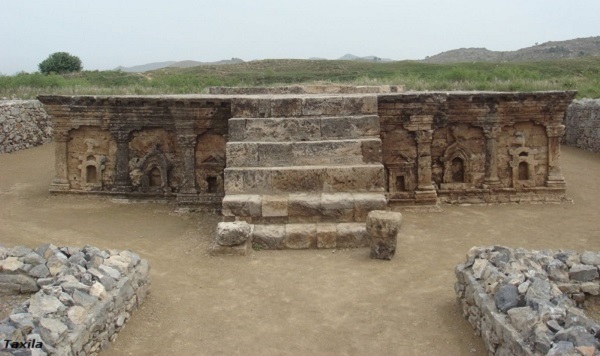
His successors were Vasishka, Huvishka, Vasudeva, and some others.
Vasudeva is a purely Indian name and it suggests the complete Indianisation of Kushana. Vasudeva was a Saiva, though his name is after the Vaishnava deity.
The decline of Kushana power begins after Vasishka. However, Kushanas continued to rule up to the 4th century A.D. over small kingdom, independently under some sovereign rulers.
Ancient Indian History - Gupta Period
North India came under the rule of several foreign people, such as the Yavanas, Kushans, Sakas, Parthians, etc. They began to settle in north-west India from the first century B.C. onwards.
Foreign rulers came to India due to the turbulent condition in central Asia.They adjusted themselves with Indian culture, and introduced some new elements in India.
-
Three big political powers emerged in India between the 1st century B.C. and 3rd century A.D., which played an important stabilising factor over large regions. They were −
Satavahanas in the Deccan,
Kushanas in the north, and
Sakas in the west.
In the mid of 3rd century A.D., the empires of the Satavahanas and Kushanas came to an end.
Gupta Dynasty
A new dynasty, known as Gupta, emerged in north India. They made a permanent impact on Indian history by building up a large empire. They have firmly established several trends of Indian culture like the Mauryas a few centuries earlier.
Apart from political might and strength, the Gupta kings were also known for their great achievements in the field of science, art, culture, and literature.
The Allahabad pillar inscription of Samudragupta mentions maharaja Srigupta and maharaja Ghatotkacha as his ancestors. But we do not know much about the early Guptas.
I-tsing, a Chineses traveler, came to India between A.D. 671 and 695. He mentioned Srigupta as the builder of a temple at Gaya for the Chinese pilgrims about 500 years before his time.
The king, Srigupta, has been identified as the first Gupta king mentioned in the Allahabad pillar inscription.
Puranas also mentioned that the early Guptas controlled the area along the Ganga (the middle Gangetic basin), Prayag (Allahabad and surrounding region), Saketa (Ayodhya region), and Magadha.
Ghatottotkacha succeeded his father Srigupta. He was also referred as the Maharaja in Gupta records.
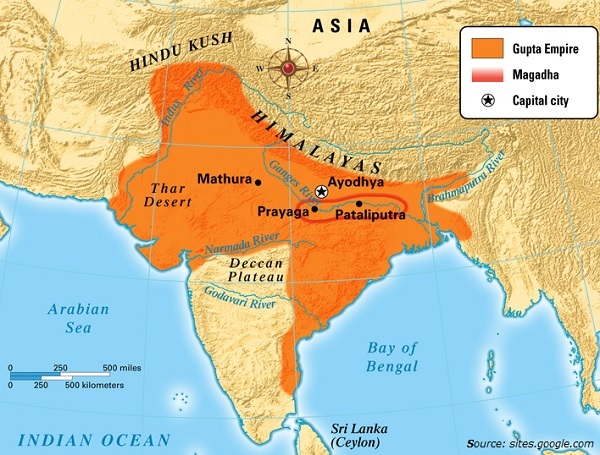
Chandragupta-I
Chandragupta-I succeeded his father Ghatottotkacha in A.D. 320.
Chandragupta-I was considered to have laid the foundation of the great Gupta Empire. He was married to a Lichchhavi princess Kumaradevi. The Lichchhavis were related to Gautama Buddh.
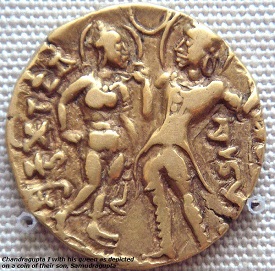
The Lichchhavis were an old and established Ganarajya and quite powerful and still being respected in north India.
The marriage alliance of Chandragupta-I was important for his political career as is proved by the coins Chandragupta I. These coins portray the figures of Chandragupta and Kumaradevi with the name of the Lichchhavis.
In the Allahabad inscription, Samudragupta son of Chandragupta-I and Kumaradevi, proudly called himself Lichchhavis Dauhitra i.e. son of the daughter of Lichchhavis.
The Gupta era was started with a coronation of Chandragupta-I in A.D. 320. He was the first Gupta king to adopt the title Maharajadhiraja and issued gold coins. Chandragupta-I introduced a new era called Gupta era.
Samudragupta
Samudragupta succeeded his father Chandragupta-I about A.D. 340. He earned a reputation as one of the greatest kings and conquerors. He was chosen by his father as his successor because of his qualities that would make him into a good king.
The Allahabad pillar inscription gives a detailed account of the career and personality of Samudragupta.
Harishena one of the officials composed the inscription and engraved on the Ashoka's pillar at Allahabad.
Samudragupta was a great military general. He had a long list of the kings and rulers whom he defeated and subdued as a part of his military achievements. He uprooted nine kings and princes from the Aryavarta and annexed their kingdom.
Campaign of southern India was the most important campaign of Samudragupta
Altogether twelve kings and princes of the south (dakshinapatha) are listed in the inscription.
During the campaign of southern India, he adopted the policy of first capturing the kings, then releasing them from captivity, and then reinstalling them as kings in their territory. By showing royal mercy, he won their allegiance.
Samudragupta proceeded for his south Indian campaign, through the eastern and southern parts of Madhyadesha to Orissa and then advanced along the eastern coast and reached Kanchi and beyond and returned to his capital by way of Maharashtra and Khandesh.
Samudragupta performed Ashvamedhayajna after his several conquests and issued gold coins depicting the sacrificial horse and bearing the legend, which conveying that he performed the Ashvamedha sacrifice.
The Allahabad pillar inscription also lists fourteen kingdoms bordering his kingdom. These rulers paid tribute followed his orders and showed their obedience by attending his court.
These were located in eastern Rajasthan, northern Madhya Pradesh, Assam, and Nepal. Further, some forest kings (atavika-rajas) are mentioned whom Samudragupta had made his Paricharaka (helpers).
Other political powers listed in the inscription are such as Kushanas, Sakas, Murundas as well as Simhalas (Sri Lanka) and inhabitants of other islands. These rulers sent embassies to Samudragupta's court.
Meghavarna, the king of Sri Lanka, sent an embassy to Samudragupta for his permission to build a monastery and a guest house for Buddhist pilgrims at Bodh Gaya.
Samudragupta was a versatile genius. He was called as Kaviraja i.e. the king of poets. He was proficient in war and sastras as well.
The Allahabad pillar inscription calls him a great musician. This is also confirmed by his lyricist type of coins, which shows him playing veena (lute).
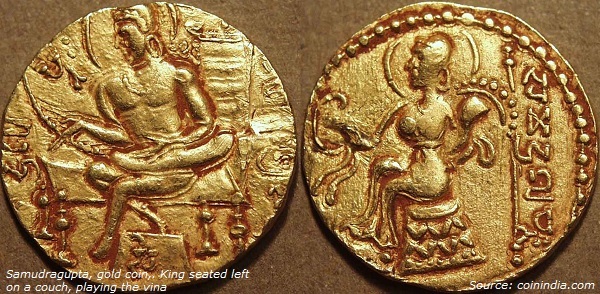
Samudragupta patronized learned men in his court and appointed them as his ministers.
Samudragupta died in about A.D. 380 and was succeeded by his son Chandragupta II.
Chandragupta II
Chandragupta II was the son of Samudragupta and Dattadevi and he was chosen by his father as his successor.
The Gupta Empire reached its highest glory, both in terms of territorial expansion and cultural excellence under Chandragupta II.
Chandragupta II had inherited a strong and consolidated empire from his father Samudragupta.
Chandragupta II had established a matrimonial alliance with Vakatakas by marrying his daughter Prabhavatigupta with Rudrasena-II of the Vakataka dynasty.
Chandragupta-II made an alliance with the Vakatakas before attacking the Sakas so as to be sure of having a friendly power to back him up in Deccan.
Prabhavatigupta acted as a regent on behalf of her two minor sons after the death of her husband Rudrasena II.
Chandragupta-IIs victory over the mighty Sakas dynasty was his foremost success. The annexation of Sakass kingdom comprising Gujarat and part of Malwa strengthened the Gupta Empire, but also brought it into direct touch with western sea ports. This gave a great motivation to foreign trade and commerce.
Ujjain, a major centre of trade, religion, and culture became the second capital of the Gupta Empire after the conquest.
After the victory over Sakas, Chandragupta-II adopted the title of Vikramaditya.
Chandragupta-II issued dated silver coins to commemorate his victory over Saka kshatrapas.
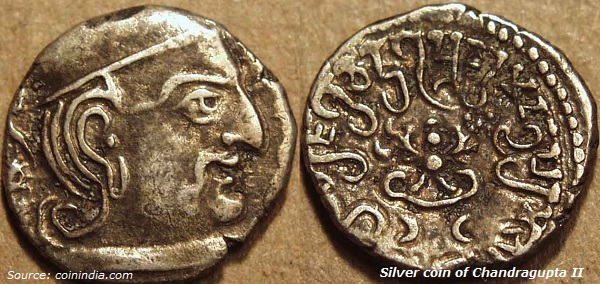
The Mehrauli iron pillar inscription records portray a king named Chandra.
The king Chandra is generally identified as Chandragupta-II. This would mean his kingdom extended from Bengal to the north-west frontiers.
Chandragupta-II's reign is remembered for his patronage of literature and arts and for the high standard of artistic and cultural life.
Kalidas, the great Sanskrit poet was a member of Chandragupta-IIs court.
Fa-Hien, the Chinese Buddhist pilgrim visited India between A.D. 405 and A.D. 411. He visited for collecting Buddhist manuscripts and text and studying at Indian monasteries.
Kumaragupta-I
Chandragupta-II died about A.D. 413. His son Kumaragupta became the next king.
Kumaragupta ruled for more than forty years. He performed an Ashvamedha sacrifice; though his military achievements are not known.
Kumaragupta issued Ashvamedha type of coins like his grandfather, Samudragupta.
The epigraphic records show that he organised the administration of vast empire and maintained its peace, prosperity, and security for a long period of forty years.
The Gupta Empire was challenged by the Pushyamitras at the end of Kumaragupta's reign.
Pushyamitras were living on the banks of the Narmada.
Skandagupta was the son of Kumaragupta-I.
Skandagupta
Kumaragupta-I died in A.D. 455. His son Skandagupta became the next king.
Skandagupta's reign seems to have been full of wars. He struggled with his brother Purugupta.
Hunas were the greatest enemies of Guptas empire during this period.
Hunas were a ferocious barbarian horde. They lived in central Asia.
Skandagupta successfully defeated the Hunas. So they did not dare to disturb the Gupta Empire for half a century. Though they continue to disconcert Persia during this period.
The important event of Skandagupta's reign was the restoration and repair of the dam on Sudarsana Lake after 8 hundred years of construction. It was built during Chandragupta Maurya's reign.
Sudarsana Lake was also repaired previously during the reign of Saka kshatrapa Rudradaman I.
Ancient Indian History - Decline of Guptas
The Gupta dynasty continued to be in existence for more than 100 years after the death of Skandagupta in A.D. 467.
Skandagupta was succeeded by his brother Purugupta. Nothing is known about his achievements.
Budhagupta was the only Gupta ruler who continued to rule over a large part of the empire.
Budhagupta inscriptions have been found from Bengal, Bihar, Uttar Pradesh, and Madhya Pradesh.
Hunas leader, Toramana attacked Gupta Empire in A.D. 512. He conquered a large part of north India up to Gwalior and Malwa.
Toramana was succeeded by his son Mihira kula. He founded his capital at Sakala (Sialkot).
Huna ruled in India for a very short period, but the Gupta Empire suffered much from it.
Huna rule was one of the shortest instances of foreign rule over India.
Hiuen-Tsang describes that Mihirkula invaded Magadha. He was defeated and captured by the Gupta king Baladitya. It is also mentioned that Mihirkulas life was saved at the intervention of the queen mother of Magadha.
Inscription from Malwa mentioned that Yasovarman was a powerful local ruler of Malwa. He also defeated Mihirakula (Huna Ruler).
Governance of Gupta Period
During the period between Guptas and Harsha, polity, religion, society, economic life, literature, art, and architecture and technology were in the highest state of glory. Because of this reason, this period is popular as a golden period of Indian history.
Structure of Administration
Set up of the governments was well organized during the Gupta period, which provided a strong base for them to hold together their extensive territories for such a long period.
In spite of intermittent wars among them, the reigns of the Guptas survived for two hundred years; the Chalukyas lasted for four hundred years; and Pallavas lasted for about six hundred years.
The basic (governance) functionalities of the different dynasties were almost same except some differences in their name.
The kingdom (Rajya) was divided into a number of provinces and they were known as Bhukti in the north and Mandala or Mandalam in the south.
The provinces were sub-divided as Vishaya or Bhoga in the north (India) and Kottams or Valanadu in the south (India).
Some other units of administration were the districts, which were called as Adhis, Thana, or Pattana in the north (India) and Nadu in the south (India).
The group of villages (i.e. modern tehsil) was known as Vithis in the north (India) and Pattala and Kurram in the south (India).
The villages were the lowest administrative units.
There was a number of central, provincial, and local official to carry on the administration.
Governance under Gupta Empire
The administration under Gupta Empire was largely dependent upon the old bureaucratic form of administration; however, they organized it much systematically and elaborately.
The governor of Bhukti was appointed by the king and known as Uparika.
-
The administrative work was undertaken by a Board of Advisors, consisting of four members representing the various important sections, namely −
The Nagarsresthis, were the chief of the guild of traders and bankers. They represented the guilds in particular and the urban population in general.
The Sarthavaha, were the head of guild of traders and represented the various trading communities.
The Prathamakulika (the chief of artisan) represented various artisan classes.
The Prathamakayastha might have represented the government official like the Chief Secretary of the present day. This body was known as Adhisthanadhikarana.
Each city administration had a council body.
The village administration was under the control of rural bodies consisting of a headman and the village elders.
During Gupta period, there was a remarkable growth of the local self-governing institutions such as the village committees and district committees.
Inscriptions and literature records describe the existence of local bodies since very early period. They mentioned about the nature and the activities of these local bodies and testify to the most wonderful organization that the ancient Indians evolved.
-
Two New classes of officers were introduced by the Guptas, namely −
Sandhivigrahika, he was the minister of peace and war i.e. modern foreign minister
Kumaramatyas, he was a body of top ranking officials attached not only to the king, but also to the crown-prince, and sometimes placed as in charge of districts.
Ayuktas were another important official, they were same as Yuktas mentioned in the Ashokan inscriptions and in Kautilya's Arthasastra.
During the Gupta period, many known officials - such as Mahapratihara, Mahabaladhikrita, and Mahadandanayaka, etc. used their title prefixed with Maha. The powers of all these officials and officers emanated from the king.
Gupta rulers assumed several titles such as Maharajadhiraja, Parambhattaraka, Parmesvara, etc.
In Allahabad pillar inscription, Samudragupta is described as equal to the Gods Indra, Varuna, Kuvera, and Varna and also as a God dwelling on the earth. Such titles were used by the rulers of foreign origin such as the Greeks, or the Kushanas, but never by a king of an Indian origin.
Guptas were the first who adopted high sounding titles in the history of India.
Literature of this period mentions the ideals of popular government.
The Smritis explain that "the ruler has been made by Brahma, a servant of the people, getting his revenue as remuneration".
During the Guptas period, the powers of the king were more restricted and he was advised to rule with the help of ministers and to respect the decision of guilds and corporate bodies.
The Gupta kings are usually represented on their coins. They have been described as an excellent and unrivalled chariot warriors and horsemen.
In the early history of India, Gupta period is considered as a landmark in the field of administration of law and justice. The legal literature, developed during this period, reflects a distinct advancement in the legal system.
Lawmakers drew a clear line between civil and criminal law for the first time.
The Brihaspatismriti enumerates eighteen titles of land and adds that fourteen of these have their origin in property (Dhanamula) and four in injury (Himsamula).
During the Gupta period, the land became private property that could be sold for money.
Detailed law about partition, sale, mortgage, and lease of land were mentioned in the law-books and in the inscriptions of this period.
Kautilyas Arthashastra enumerated a bigger list of taxes than those were found in the Gupta inscriptions.
The burden of taxation was decreased in Gupta period because of the prosperity of the state.
Land taxes were collected both in cash and kind. It was varying from one-fourth to one-sixth of the produce.
Special officers are mentioned in the inscriptions to kept proper records of assessment and collection of revenues, land transactions, etc.
Literature of Gupta Period
Gupta period was considered as the golden phase of Indian literature.
The wonderful literature was produced in prose, poetry, drama, and grammar. It is the noticeable product of the system of education and learning.
The Puranas preserved the traditions, legends, moral codes, religious, and philosophical principles. They are eighteen in number.
The Smritis are metrical texts containing the rules and regulations and laws for the guidance and governance of the society.
Smritis are based on dharmasutras and grihyasutras of Vedic literature. They are written in verse.
Some additions and alterations have been done to make Smritis suitable to the changing conditions of society.
The commentaries on the Smritis were written after the Gupta period.
The compilation of Ramayana and Mahabharata was completed by the 4th century A.D.
Kalidas has written the best works in poetry, drama as well as in prose. His kavyas such as Meghaduta, Raghuvamsa, and Kumarasambhava, and dramas such as Abhijnashakuntalam are the best literary works of this time and it is considered as the best even today. These works have been translated into many languages.
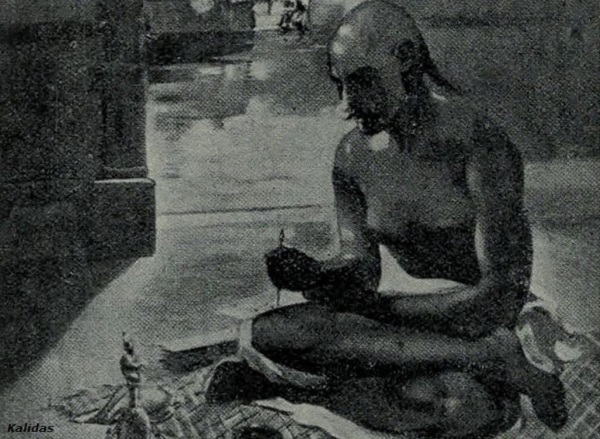
Kalidas adorned the court of Chandragupta-II, the king of Ujjayini, who was popular as Vikramaditya.
Inscriptions as Source
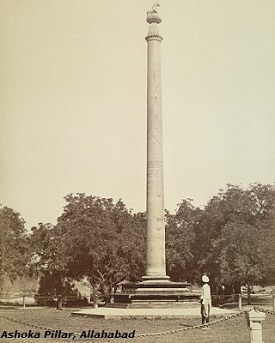
-
A few inscriptions of the period are −
The Allahabad pillar inscription composed by Harisen;
Mandsor inscription composed by Vatsabhatt; and
Junagarh rock inscription, Mehrauli Pillar inscription, Aihole inscription composed by Ravikriti.
These all inscriptions (listed above) consist most of the characteristics features of Sanskrit kavya.
The most notable in the field of drama were Bhasa, Sudraka, Kalidas, and Bhavabhuti.
Mrichchakatika (written by Sudraka), is considered one of the best plays of ancient India. This play is about the love of a Brahman with the beautiful daughter of a courtesan.
Vishakhadatta had written two plays, namely Mudrarakshasa and Devichandraguptam.
Famous plays written by Kalidas are Malavikagnimitram, Abhijnanashakuntalam, and Vikramorvasiyam.
Uttararama-charita and Malati-Madhava were written by Bhavabhuti.
Panchatantra, written by Vishnu Sharma, is one of the most famous works of this period. It was translated into Persian and Arabic in the 8th century A.D. and has been translated into almost all European languages by the time.
The popular work Hitopadesa is based on the Panchatantra.
Harshacharita is the biography of Harsha written by Banabhatta. It is an outstanding work of the period.
The development of Sanskrit grammar (based on Panini and Patanjali) was also seen in this period.
Bhartrihari composed three Shatakas. He had also written a commentary on the Mahabhasya of Patanjali.
The compilation of the Amarakosha by Amarasimha is memorable work of this period. Amarasimha was a popular personality in the court of Chandragupta II.
The Prakrit was popular language of the Gupta period (as it was earlier).
The Svetambara Jain canon have been written in Ardha-Magadhi Prakrit.
The religious texts of the Digambara Jain (of south India) were written in the Maharashtri and Sauraseni Prakrits.
The commentaries on Buddhist texts were written in Pali.
Prakritaprakasha written by Vararuchi and Prakritalakshana written by Chanda are the well-known grammar works on Prakrit and Pali language.
Katyayanaprakarna is a Pali grammar book.
Foreign Accounts
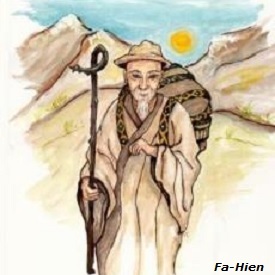
Fa-Hien, the Chinese pilgrim with four other monks, came to India during the reign of Chandragupta II.
Fa-Hien came to India through land route via central Asia and Kashmir and traveled across north India.
Fa-Hien stayed three years at Patliputra and here he learned the Sanskrit language.
Fa-Hien was interested only in Buddhism; however, he gave an idea of general peace and welfare during Guptas court.
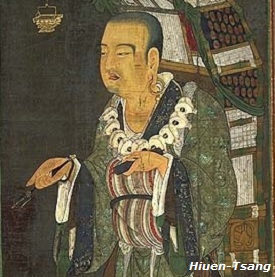
Hiuen-Tsang, another Chinese traveler, visited India during Harsha's reign. He spent thirteen years in India, in which eight years, he stayed in Harsha's kingdom.
Hiuen-Tsang had studied at Nalanda University. He visited various Indian kingdoms and mentioned about their condition. His book Si-yu-ki is a precious source of ancient Indian history.
Hiuen-Tsang was honoured by Harshavardhana of Kanauj and Bhaskarvarma of Assam.
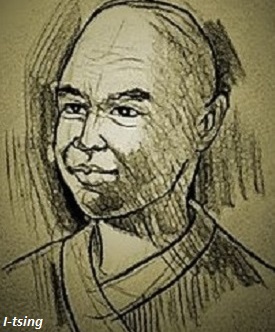
I-tsing, a Chinese traveler, came to India via sea route. He spent many years in Sumatra and Sri Vijaya and learned Buddhism.
I-tsing stayed at Nalanda for ten years and studied and translated Buddhist texts.
I-tsing compiled a Sanskrit Chinese dictionary and translated a number of Sanskrit texts.
I-tsing mentioned about Buddhist Religion as Practised in India. He gave a detailed account of Buddhism and general condition of India and Malaya.
Economy in Gupta Period
India had developed an advanced system of agriculture, industry, and trade long before the rise of the imperial Guptas.
The economic stability and prosperity facilitates all-round cultural progress made during this period.
The agriculture system was well developed and scientific methods were used to increase agricultural production.
The Amarakosha and Brihat Samhita contain special chapters on the study of plants and gardens, forest, crops, manure, etc.
Various branches of industry had developed because of the abundance of raw materials and the skill and enterprise of the artisans and the craftsmen.
The literary works also describe a large variety of clothing such as cotton, silk, wool, and linen.
Hiuen-Tsang described the classification of Indian clothing materials under the heads as - silk, cotton, linen, wool, and goat hair.
Amarakosha mentions various terms used for the finer and coarser varieties of cloth as well as for unbleached and bleached silk.
Ajanta wall paintings also exposed different techniques of weaving.
The major centres of textiles production were Banaras, Mathura, Dashapura, and Kamarupa.
The Mandsor inscription gives details about the guilds of silk weaver and corporate activities of the period.
Ivory work flourished. A seal found in the excavation at Bhita reveals about the guilds of ivory workers.
The leather industry also flourished. Leather boots and shoes were shown in the contempary sculptures and paintings.
The art of the jewelery was in the advanced condition. The Brihat Samhita describes twenty-two jewels. Jewels were used at this period for a large variety of purposes.
Ratna pariksha mentioned the science of testing gems. Technical sciences were utilised for the manufacture of metals.
Vatsyayana mentions about Ruparatnapariksha, Dhatuveda, and Maniragakarajnanam i.e. testing of precious stones, the smelting of metals, and the technology of jewels accordingly.
Hiuen-Tsang also mentioned that brass, gold, and silver were produced in abundance.
The Mehrauli iron pillar (of Gupta period) is the best example of metal workmanships. The seals, gold, and silver coins of this period also reflect the advance stage of the metal industry.
The ship building industry was also well developed in Gupta period that facilitated trade and communication activities.
Smritis described in detail the laws of partnership, contract, right and duties of the individual members of the guild, and structure of guild that corroborated by contemporary literature and inscriptions.
The seals and inscriptions mention about the legends Sreshthi-kulika-nigama and Sreshthisarthavaha- kulika-nigama. These permanent endowments reveal the function of the guilds in the capacity of banks as well as confirm their stable position in terms of business stability.
Public works were undertaken and executed by the state as well as by the guilds.
The repairs of Sudarshana lake dam and the connected irrigation canal in the province of Saurashtra were carried out by provincial governor Parnadatta and his son Chakrapalita during the rule of Skandagupta.
Trade and commerce
Trade was carried on both through the land as well as the coastal routes.
India had trade relations with both the eastern and the western countries.
India maintained regular maritime relation with Sri Lanka, Persia, Arabia, Byzantine Empire, Africa, and even further west.
India also developed commercial relations with China, Burma, and South East Asia.
The important trade items were silk, spices of various kind, textiles, metals, ivory, sea produce, etc.
-
Some important sea ports of the Gupta period were −
Tamralipti,
Arikamedu,
Kaveripattnam,
Barbaricum,
Muziris,
Pratishthana,
Sopara, and
Brighukachchha.
All these ports (enumerated above) were well connected through inland routes from all parts of India.
According to Fa-Hien, people of the 'Middle Kingdom' were prosperous and happy in the beginning of the 5th century and he also mentioned the similar account of prosperity and peace in India.
People were maintaining a high standard of living and luxury of the town life.
The land grants were given to Brahmans, temples, viharas, mathas to run the educational institutions and other social welfare activities.
The tradition of land grants for the charitable purposes continued into the medieval period as well. These were known as Madad-i-mash, Suyarghal, etc.
Science and Tech of Gupta Period
India had much advanced knowledge in the fields of mathematics, astronomy, and medicine during this period in comparison to any other country in the world.
Arabs borrowed Indian knowledge of science and technology then it was taken by the western world from them.
The mathematics and astronomy originated in Vedic period itself.
Aryabhata, a great mathematics, wrote the book Aryabhatiya in Kusumpura (Pataliputra) at the age of 23 years.

Aryabhatiya is divided into four parts and the most important features of Aryabhata's mathematical system was the unique system of notation. It is based on the decimal place-value system unknown to other ancient people.
Aryabhata explained various principals of geometry, an area of a triangle, the area of circle and the theorem relating to rectangles.
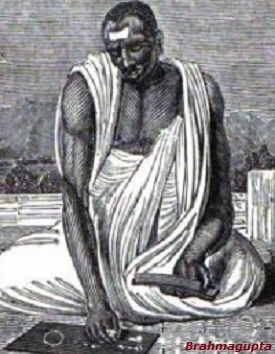
Brahmagupta was also a famous mathematician. He wrote Brahmsiddhanta in A.D. 628. He developed rules for operating with negative qualities and with zero. He began to apply Algebra to astronomical problems.
Jyotisa was an ancient term used for astronomy and astrology. Varahamihira wrote Panchasiddhantika in A.D. 505. He was popular person in the court of Chandragupta II.
Panchasiddhantika consisted five works (siddhantas), which is popular as Paitamaha, Romaka, Paulisa, Vasishtha, and Surya.
The Suryasiddhanta is the most important and complete work on the astronomy of the period.
Varahamihira wrote Brihatsamhita. This is considered as an encyclopedic work on astrology.
Varahamihira's son, Prithuyashas also wrote a book on astronomy in about A.D. 600, named as Harashatpanchashika.
Medicine
Ayurveda, literally means science of longevity. This is the name of Indian medical sciences. It originated during the Vedic period.
Vedic literature, particularly, Atharvanaveda consisted of more than seven hundred hymns on the topics related to Ayurveda.
Hastayurveda is a guide book that describes (elaborately) the animal diseases particularly about elephants.
Asvasastra was written by sage Salihotra. It is a treatise on the horse.
Metallurgy
Chemistry was another science that developed along with the medicine that helped in the development of metallurgy.
Nagarjuna the great Mahayanist was also genus in chemistry.
The Mehrauli iron pillar is a living memorial of this period. It portrays the progress in metallurgy achieved 1,500 years ago by the Indians. It has been surviving without rusting since its establishment (i.e. for over 1,500 years).
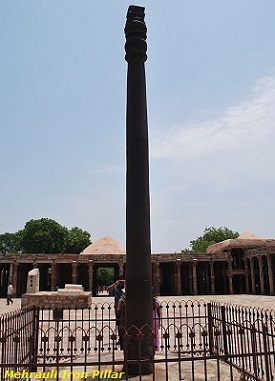
Art and Architecture
The economic prosperity of the country during the Gupta period led to all round development in the field of sculptural art, architecture, and painting.
In the Deccan, rock-cut caves were excavated. There are nine caves at Udaygiri near Vidisa. These are partly rock-cut and partly stone-built.
Ajanta caves were built on the new line of architecture by the great beauty of their pillars of varied design and size and the fine paintings with which the inner wall and ceiling are decorated.
Elloras rock-cut monasteries and chaitya halls are other piece of architecture. The Brahmanical, Buddhist, and Jain caves portray the final phase of development.
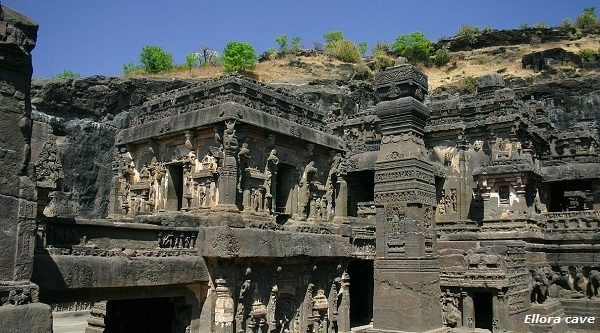
Kailash temple is a magnificent monolithic temple with a spacious hall and finely carved pillars. It was carved into a block of hill.
The seven monolithic temples and number of pillared halls at Mamallapuram were carved by the Pallava kings Mahendravarman and Narasimhavarman in the 7th century A.D.
These monolithic temples were popularly called as Rathas. These massive structural temples were completely cut out of rock.
Monasteries and stupas were also built during this period. These Monasteries were also the centers of education.
The famous centers were at Bodhgaya, Sarnatha, Kusinagara, Srayasti, Kanchi, and Nalanda.
The Nalanda University grew into the most prestigious establishment during the 5th century A.D.
Hiuen-Tsang mentioned in detail about the great temples, monasteries, and library buildings of Nalanda mahavihara.
Dharmarajaratha at Mamallapuram is the earliest examples of the rock-cut temple of Dravidian styles.
The structural temples at Kanchi, known as Kailasanatha and Vaikuntha Perumal were all built by the Allava Kings.
India after the Gupta Period
- After the Gupta period, India was divided into different small and medium kingdoms.
North India
-
There were four major kingdoms in north India between the period in which the Guptas declines and the rise of Harsha (i.e. in the beginning of 7th century), namely −
Guptas of Magadha;
Maukharis of Kanauj;
Maitrakas of Valabhi (Saurashtra); and
Pushyabhutis of Thaneswar.
These four kingdoms (enlisted above) were competed with each other to succeed to the past glory of the Guptas.
The Guptas of Magadha were different from the main imperial Gupta dynasty. It was a minor dynasty of Magadha. It could not be determined whether they were connected in any way with the imperial Guptas. But some of the kings of this Gupta family were very powerful and ruled up to as far as the Brahmaputra River.
The Maukharis occupied the region of western Uttar Pradesh around Kanauj. They captured a part of Magadha.
Isanavarman and his son Sarvavarman were powerful Maukhari kings. They have adopted the title of Maharajadhiraja.
Isanavarman successfully restrained the Hunas who had once again attempted to move towards the heart of India.
The Maitraka clan founded a kingdom in Saurashtra in the west. They made their capital at Valabhi.
Valabhi developed as a seat of learning and culture along with a center of trade and commerce.
The Maitrakas survived the longest and ruled until the middle of the 8th century; however, they were defeated by the Arabs.
The Pushyabhutis of Thaneswar was the fourth Kingdom. It was destined to play a distinguished part in Indian history.
The Pushyabhuti family became known after the Huna invasion. Prabhakarvardhana became a powerful king of this kingdom. He played an important role in the history of India.
Prabhakarvardhana assumed the title of Paramabhattaraka Maharajadhiraja.
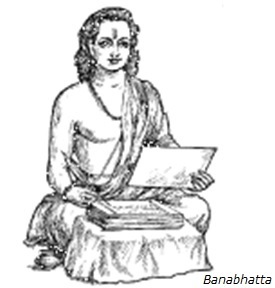
Banabhatta described him as a lion to the Huna deer, a burning fever to the king of Sindhu, a troubler of sleep of Gurjara king, a bilious fever to that scent-elephant, the lord of Gandhara, a destroyer of the skill of the Latas, an axe to the creeper, which is the goddess of fortune of Malwa."
Prabhakarvardhanas sovereign kingdom was extended to the whole of Punjab in the north-west and part of Malwa in the south.
There was a Huna invasion in the last phase of Prabhakarvardhanas rule.
Prabhakarvardhana had two sons, Rajyavardhana and Harshavardhana and a daughter Rajyasri. He married his daughter to the Maukhari king Grahavarman.
Prabhakaravardhana had been rapidly extending the boundaries of his kingdom towards the west and south. During this period, two powerful kingdoms were established in Bengal and Assam.
About A.D. 525, one independent kingdom was established in Bengal.
Gauda kingdom comprises western and northern parts of Bengal. They declared their independence; however, the Maukharis defeated them.
Sasanka became the king of Gauda kingdom about half a century later. He founded his capital at Karnasuvarna (near Murshidabad). He occupied the whole of Bengal. He captured Orissa and then advanced towards Kanauj in the west against the Maukharis.
The Maukhari king Grahavarman was married to Rajyasri, daughter of Prabhakaravardhana. This marriage alliance strengthened the position of the two families.
Sasanka (Gauda), with the help of Malwa king, invaded Kanauj after the death of Prabhakaravardhana. The King Grahavarman of Kanauj, was killed and the queen Rajyasri was thrown into prison.
Hearing the news of Kanauj defeat, Rajyavardhana (brother of Harsha) started campaign to suppress the kings of Gauda and Malwa. But he was deceitfully killed by Sasanka.
Ancient Indian History - Period of Harsha
Rajyavardhana was killed by Gauda king Sasanka. Harshavardhana (younger brother of Rajyavardhana) was ascended the Pushyabhuti throne in A.D. 606 at the age of sixteen. He was also known as Siladitya. He ruled for forty-one years.
After Grahavarman's death, the Councilors of Maukhari state offered the throne to Harsha.
Sources of Harshas History
History of the Harsha period is well documented by Banabhatta. He was a poet and he had written Harshacharita. It is a detailed account of the events of the reign of Harsha.
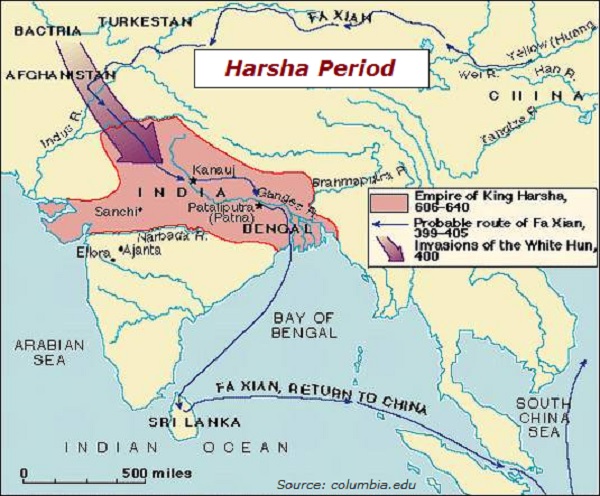
HiuenTsang (Chinese pilgrim) also had written in great detail about Harsha and India (of Harsha's time).
Harsha proceeded towards the east against Sasanka with a view to avenge the death of his brother, Rajyavardhana and brother-in-law, Grahavarman.
Harsha did not get success in his first expedition against Gauda. But after the death of Sasanka, in his second expedition, he conquered Magadha and Sasanka's empire.
Gauda kingdom was divided between Harsha and Bhaskaravarman.
Bhaskaravarman was the king of Kamarupa. He was an ally of Harsha against Gauda Kingdom.
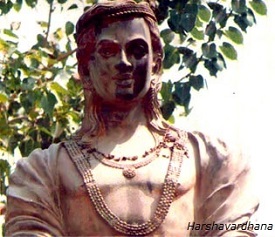
Harsh was successful in his military enterprise, and conquered a large part of the northern India.
Harsha also launched a campaign to extend his empire beyond the Narmada, but he failed to do so.
Aihole inscription mentions that Harsha was defeated by Pulakesin-II (Pulakesin-II was a Chalukya king of Badami).
Hiuen-Tsang also mentioned that Harsha could not defeat the Chalukya king.
Harsha's empire was extended from the Punjab to northern Orissa and from Himalayas to the banks of Narmada.
Harsh made military coilation with Dhruvabhatta II, the Maitraka king of Valabhi and Bhaskaravarman, the king of kings, Kamarupa.
Harsha earned an undying reputation in the history of India for his peaceful activities as described by Hiuen - Tsang and by his biographer Banabhatta.
Harsha, as a great emperor, was a patron of learning. He was himself a talented author. He wrote three Sanskrit plays, namely Nagananda, Ratnavali, and Priyadarsika.
Banabhatta had written Harshacharita and Kadambari. He was a lerned poet.
Harsha was an efficient administrator. He personally looked into the affairs of the state, and constantly travelled over different parts of his empire to see things with his own eyes.
He was also a tolerant king. He was a Saiva by faith; however, he had given equal respect to other religious sects as well.
Hiuen Tsang describes him as a liberal Buddhist who also honoured gods of others sects.
Harshs charitable acts benefitted all the communities, sects, and religions.
Harsha built rest houses, hospitals, and endowed numerous Brahmanical, Buddhist, and Jain establishments.
The two most celebrated events of Harsha's reign were the assemblies at Kanauj and at Prayaga.
The Kanauj assembly was held in honor of Hiuen-Tsang for whom he had great affection and regard.
Kanauj assembly was attended by 24,000 Buddhist monks, and about 3,000 Jains and Brahmans.
After the ceremony at Kanuaj, Harsha along with Hiuen-Tsang went to Prayaga (Allahabad), at the confluence of the rivers Ganga, Yamuna, and Saraswati. Here he used to celebrate religious festivals at the end of every five years.
Harsha performed the ceremony of dana (donation), which lasted for about three months. During these three months, he donated all his accumulated wealth of five years. He even gave his clothes and jewelry and once begged from his sister an ordinary garment to put on.
Harsha attended six such assemblies at Prayaga in his life time and donated all he had.
In A.D. 641, Harsha sent an embassy with Hiuen-Tsang to the Chinese emperor and received the Chinese embassy in return.
Harsha did not have any heir to his throne. Therefore, after his death in A.D. 647, his empire was grabbed by his minister.
South India during the Harsha Period
The Satavahanas rule ended in the first half of the 3rd century A.D. from Deccan and south India.
In the second half of the 3rd century A.D., the Vakatakas came into power. However, much is not known about the founder of the Vakatakas dynasty,
Vakataka Empire
Pravarasena was the (known) founder of the Vakataka Empire in western and central India.
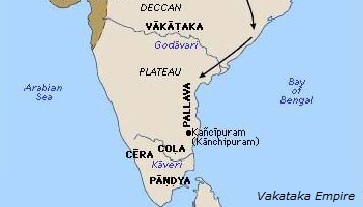
Vindhyasakti was the father of Pravarasena. He played an important role in establishing Vakataka Empire.
Pravarasena is the only Vakataka ruler to whom the title samrat was accorded. He performed Vajapeya and four Ashvamedhayajnas.
The successors of Pravarsena divided the Vakataka Empire into two parts. The main branch was known as Vatsagulma branch.
Chandragupta-II raised the importance of the Vakatakas as a political power in western and central Deccan. He married his daughter Prabhavati Gupta into the Vakataka family.
After this matrimonial alliance, the Vakatakas and the Guptas remained friendly for a long-time.
Kingdoms of Central and South India
-
After the Vakatakas, three major kingdoms (listed below) dominated the Deccan and south India for about 300 years −
Chalukyas of Badami,
Pallavas of Kanchipuram, and
Pandyas of Madurai.
The Vakatakas in the Deccan were followed by the Chalukyas of Badami.
The Chalukyas develop their base at Vatapi or Badami and Aihole. They moved northwards and captured the areas around Nasik and the upper Godavari region.
Pulakesin-II was the greatest king of Chalukya dynasty. He ruled from A.D. 610 to 642.
Pulakesin-II was the contemporary of Harshavardhana of Kanauj.
The Aihole inscription mentioned the detailed account of Pulakesin IIs victories as well as early history of the Chalukyas. This inscription was composed by Ravikirti.
Vishnuvardhan, son of Pulakesin-II, founded the eastern branch of the Chalukyas with its capital first at Pishtapuri. Later Vengi developed as a capital of the east Chalukyas kingdom.
This branch remained independent of the main western branch and exercised uninterrupted authority over the kingdom up to the 12th century.
The Rashtrakutas succeeded the Chalukyas of Badami and build a vast empire in the Deccan.
Dantidurga-I was the first known ruler of the Rashtrakuta dynasty. He defeated the Chalukyas and conquered Badami in A.D. 752.
The Chalukyas and the Pallavas were contemporaries of the Gangas and the Kadambas in the Deccan.
The western Gangas were distinguished from the eastern Gangas of Kalinga. The Chalukyas and the Pallavas were ruled over a large part of modern Mysore.This region was called after them as Gangavadi.
Konkanivarman Dharmamahadhiraja was the founder of the family. He ruled in the second half of the 4th century A.D. and had his capital at Kolar. He ruled independently from A.D. 350-550.
Durvinita was a prominent Ganga king. He was a scholar of Kannada and Sanskrit literature.
Sripurusha was another important ruler of (western Ganga) dynasty. He shifted his capital to Manyapura (Manne near Bangalore). His kingdom was known as Srirajya on account of its prosperity.
Ancient Indian History - Kadamba Dynasty
Mayurasharma established the Kadamba dynasty. He was a learned Brahman. It is said that Mayurasharma came to receive education at Kanchi, but he was insulted by some Pallava officials. To avenge his insult, he took up a military profession, defeated Pallava officials and then Pallavas recognized the independence of Mayursharma.
The Mayurasharma ruled from Banavasi from A.D. 345 to 365.
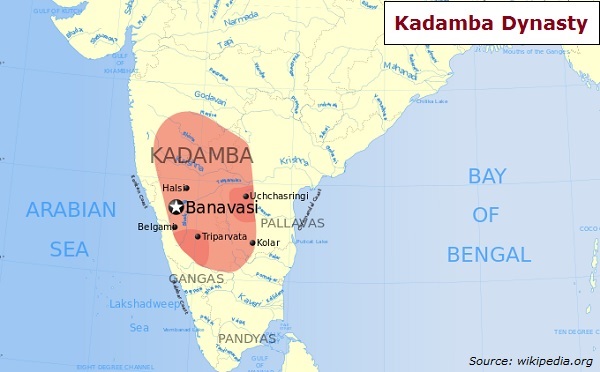
Kakusthavarman (A.D. 435-455) was the most powerful king and administrator of the Kadamba dynasty.
Kakusthavarman established matrimonial relations with the Gangas and the Guptas (dynasties). He also extended his territory.
Struggle of Kadamba Dynasty
After the death of Kakusthavarman, the Kadamba family split into two branches. One of the branches continued to rule from Banavasi and the other branch ruled from Triparvata.
Krishnavarma-I, the ruler from Triparvata, united the family. But around A.D. 540, the Chalukyas of Badami defeated the Kadambas and captured their kingdom.
In the southern Peninsula, three dynasties namely the Pallavas, Pandyas, and the Cholas were the major powers during this period.
The Pallavas became prominent after the fall of Satavahanas from the 3rd century until the rise of Cholas in the 9th century A.D. However, the origin of Pallava is under debate.
The Pallava kings were divided into two groups namely the early Pallavas and greater Pallavas.
The Tamil and Sanskrit inscriptions tell about the early Pallavas. It is mentioned that they performed sacrifices and ruled over a well organized territory that covered the northern part of the Peninsula extending from the eastern sea to the western sea.
Simhavishnu was the famous Pallava king ruling in the 6th century A.D. He increased the influence and prestige of his family.
Simhavishnus son and successor Mahendravarman-I (A.D. 600-630) was a versatile genius. He was both a poet and a singer.
Mahendravarman-I composed a play Mattavilas Prahasana (the Delight of the Drunkards) in Sanskrit.
During this period, the practice of scooping entire temples out of solid rock was introduced.
The Rathas of Mahabalipuram are fine examples of rock cutting temple.
Mahendravarman-I was the contemporary of the Chalukya king, Pulakesin-II and Harshavardhan of Kanauj.
During this period, Pulakesin-II had struggled with Harsha on the one hand and with Mahendravarman-I on the other. In both Pulakesin-II emerged victorious.
Pulakesin-II captured the northern provinces of Pallavas kingdom after defeating Mahendravarman-I.
Later on, Pulakesin-II was defeated by Narsimhavarman. He was son and successor of Mahendravarman-I.
Narasimhavarman conquered Badami and adopted the title of Vatapikonda.
Narasimhavarman had also defeated the Cholas, the Cheras, the Pandyas, and the Kalabhas.
Narasimhavarman gave political refuge to a Ceylonese prince Manavarman and sent two naval expeditions to Ceylon to help him to secure the throne again.
Narasimhavarman was one of the most powerful rulers of south India and raised the power and prestige of the Pallavas as far as Ceylon and South East Asia.
Narasimhavarman-II ruled peacefully during the A.D. 695-722.
During this period, a particular style of temple architecture was developed. This is popularly known as the Dravidian style of temple architecture.
Pallavas faced attacks from the Chalukya king Vikramaditya-II (A.D. 733-745) during the first half of the 8th century. He is said to have overrun Kanchi thrice.
The Pallavas had also been condemned of Pandyas and Rashtrakutas during the reign of Dantivarman (around A.D. 796-840).
Because of the continuous struggles, the power of the Pallavas began to decline.
The Pallavas were succeeded by the Cholas. They also developed as the greatest imperial power in the south. They had influence over Ceylon and the South East Asian countries.
Ancient Indian History - History of Kamarupa
The modern Assam was known as Kamarupa and Pragjotish during the ancient times.
Pragjotish was the capital of Kamarupa.
The Allahabad inscription of Samudragupta mentioned about the Davaka kingdom as the border state along with Kamarupa in this region.
The kingdom of Kamarupa was extended up to northern and western Bengal, and bordering lands of China as well as Davaka.
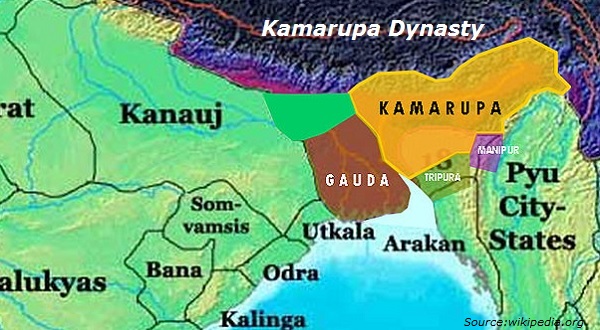
This region was ruled by a single dynasty from the time of Mahabharata up to the middle of the 7th century, till Bhaskaravarma.
Kamarupa Dynasty
The Kamarupa dynasty claims its descent from the Asura Naraka.
This Kamarupa dynasty is also known as Bhauma (i. e. the son of Bhumi).
Asura Naraka had a son namely Bhagadatta who had taken part in the Mahabharata War.
The inscriptions of the dynasty proved that the king Bhagadatta and his successors ruled for about 3,000 years in Kamarupa prior to king Pushyavarma.
The king Pushyavarma was a contemporary of Samudragupta.
The 8th king, Bhutivarma had ruled in the mid of the 6th century is known for his own records.
The time period of the first king Pushyavarma had been fixed A.D. 350 approximately. He had acknowledged the supremacy of Samudragupta.
Pushyavarma assumed the title of Maharajadhiraja and the lord of Pragjotish as mentioned in the Nalanda seal.
The 7th king, Narayanavarma, performed horse sacrifices, which shows that he become independent of the Gupta Empire during the first half of the 6th century.
The 8th king Bhutivarma or Mahabhutivarma was a powerful king. He ruled in the middle of the 6th century A.D.
Kamarupa became a powerful kingdom during the reign of Bhutivarma.
During Bhutivarmas reign kamrupa included the whole of the Brahmaputra valley and Sylhet and extended upto the Karatoya River in the west. It remains to be the traditional boundary of Kamarupa for a long time.
Chandramukhavarma, son of Bhutivarma, was not so known. However, his son Sthitavarma (grandson of Bhutivarma) had performed a horse sacrifice.
The king Susthitavarma mentioned in the Aphsada inscription of the later Gupta King Adityasen.
Mahasenagupta had defeated Susthitavarma on the banks of river Lauhitya (Brahmaputra).
Sasanka may be identified with the same Gauda king who defeated and imprisoned Supratisthitavarma and Bhaskaravarma soon after the death of their father Susthitavarma.
Supratishthitavarma had not yet ascended the throne. Both of them managed to escape from the prison of the Gauda king and Supratishthitavarma ruled for a short period. His brother, Bhaskaravarma, succeeded him.
Bhaskaravarma
Bhaskaravarma had been described in Harshacharita of Banabhatta. He was an ally of the king Harshavardhana.
Bhaskaravarma sent his ambassador Hamsavega with presents to have a coalition with Harsha.
The king of Kamarupa had been earlier defeated and imprisoned along with his elder brother by the king of Gauda. Therefore, this coalition was a good diplomatic move by the king of Kamarupa.
Rajyavardhana, the elder brother of Harsh was killed deceitfully by the same king of Gauda and Harsha had declared to destroy them. Therefore, this was a coalition between the two kings against their common enemy.
Banabhattas account has disturbed the chronological sequence of the events and therefore some confusion has cropped up about the history of the time.
The coalition force of Harsha and Bhaskaravarma defeated the Sasanka, king of Bengal and as a result of this Bhaskaravarma succeeded in occupying a large portion of Bengal.
Hiuen-Tsang mentioned in his account that Bhaskaravarma had great influence over the Buddhist monastery of Nalanda.
Hiuen-Tsang mentioned that King Bhaskaravarma sent a messenger to Silabhadra, the head of Nalanda monastery, to send the 'great pilgrim from China' to him. But this request was compiled only after a threat.
On the invitation, Hiuen-Tsang visited Kamarupa and stayed there for about a month. Thereafter, Harsha demanded from the king of Kamarupa to send back the Chinese pilgrim to his court. This also complied after a threat to Bhaskaravarma.
Bhaskaravarma met Harsha in person along with Hiuen-Tsang at Kajangala.
Bhaskaravarma also attended the great religious assembly called by Harsha at Kanauj and Prayaga.
Hiuen-Tsangs account shows that Bhaskaravarma had control over north Bengal and also had influence over Nalanda in Bihar.
After the death of Bhaskaravarma, this ancient dynasty came to an end.
Later on, the Kamarupa kingdom was occupied by a Mlechchha ruler named Salastambha.
Names of a few successors of Salastambha are known, but no details are available about them.
Ancient Indian History - India after Harsha
Harsha died in the mid of 7th century AD (A.D. 647). Delhi Sultanate founded in the 12th century A.D. The intervening period span was of 600 years and evidenced an array events.
Major Events
-
Important events during six centuries were −
The rise of important kingdoms in eastern, central, and southern India.
The cultural traditions of these kingdoms remained stable even though they often fought among themselves.
The economy, social structure, ideas, and beliefs were hardly changed rather followed the previous system. The changes in these fields had taken place more gradually than the changes in political structure.
The spread of Muslim rule over the major part of northern India at the end of 12th century.
Yashovarman
Kanauj became the seat of power in north India since the days of Maukharis equally as Pataliputra (Patna) enjoyed before.
Hiuen-Tsang described Kanauj as a prosperous center of Buddhism along with Hinduism.
Kanauj was a well-fortified city extending about four miles on the bank of the Ganges.
Kanauj lost its status as the capital city after the death of Harsha. But during Yashovarman time (i.e. in the beginning of the 8th century A.D.) Kanauj became a center of power again in north India.
Yashovarman ruled over a huge empire, which included almost the whole of northern India.
Gaudavaho written by Vakpatiraja, is a kavya literature, which describes the victory of king Yashovarman over Bengal.
Yashovarman sent an embassy to China in A.D. 731.
Famous dramatist Bhavabhuti and famous poet Vakpatiraja adorned his court.
Malati-Madhava, Uttara Rama-charita, and Mahavira-charita all were written by Bhavabhuti.
Yashovarman ruled till about A.D. 740.
Kanauj, from the 6th century A.D. till the period of Mohammad Ghori, in 1194 A.D., played an important role in the history of the north India.
Ancient Indian History - Gurjara Pratiharas
- The early history of Gurjara Pratiharas is not known.
Sources of Gurjara Pratiharas History
Historians believe that after the Gupta period, Gurjara Pratiharas came to India from the central Asian region and settled in Rajasthan. Gradually, they gained political importance.
The bardic tradition of Rajasthan claims that the Gurjara Pratiharas, Chalukyas, Parmaras, and Chahmanas were born out of a yajna done at Mount Abu. Therefore, these four dynasties are also known as agnikulas (fire-clans).
The four dynasties of Rajputs were created for the protection of the country from external aggressions.
The literary meaning of Pratihara is door keeper. It is believed that their ancestor Lakshmana served as a door keeper to his brother Rama. Therefore, they were called as Pratihara.
The geographical name of Gujarat is supposed to be derived from Gurjara.
Rulers of Gurjara Pratiharas
The Gwalior inscription mentioned the early history of the family. The inscription was founded by King Bhoja in the 7th century. He was the most famous king of the Gurjara Pratiharas dynasty.
Nagabhatta-I was the real founder of the fame of family. He defeated the Muslim forces from the Arabs.
During A.D. 775-800, Vatsaraja followed an aggressive imperial policy. He defeated Pala king Dharmapala of Bengal.
The Rashtrakuta king Dhruva defeated Vatsaraja and took away the political benefit of the defeat of Pala king.
Dharmapala took advantage of the defeat of Vatsaraja and installed his own nominee Chakrayudba on the throne of Kanauj.
Vatsarajas son, Nagabhatta II (A.D.815) made an alliance with Andhra, Vidharbha, and Kalinga. He made extensive preparation to fight against his rivals.
Nagabhatta II first defeated Chakrayudha and captured Kanauj. Then he defeated Dharmapala and fought with Govinda-III, the Rashtrakuta king.
Nagabhatta also defeated Sultan Vega who was the son of the governor of Sind under the Caliph-l Mamun.
Nagabhatta-II was succeeded by his son Ramabhadra.
Ramabhadra was succeeded by his son Bhoja-I about A.D. 836.
Bhoja-I restored the falling prosperities and reputation of his dynasty.
A golden opportunity to the king Bhoja-I was provided by the death of Devapala of Bengal and Rashtrakuta's invasion of Bengal thereafter.
The Rashtrakuta king, Krishna II was involved in the struggle with the Eastern Chalukyas.
Bhoja-I defeated Krishna-II and captured the region of Malwa and Gujarat.
After victory over two great rivals, Bhoja-I founded his sovereignty over the Punjab, Avadh, and other territories of north India and consolidated his empire.
Bhoja-I was a devotee of Vishnu, and adopted the title of Adivaraha. It has been inscribed in some of his coins. He is also known by other names as 'Mihir', 'Prabhasa,' etc.
Bhoja-I was succeeded by his son Mahendrapala-I about A.D. 885.
Mahendrapala-I also extended the boundaries of his empire. During his reign, the Pratihara Empire stretched almost from the Himalayas in the north to the Vindhyas in the south and from Bengal in the east to Gujarat in the west.
Mahendrapala-I was also known as 'Mahendrayudha', and 'Nirbhayanarendra.' He was a liberal patron of learned men.
Rajashehara was learned man of his court. He had written Karpuramanjari, Bala-Ramayana, Bala Bharata, Kavyamimansa, Bhuvana Kosha, and Haravilasa.
The Pratiharas dynasty dominated north India for over two hundred years from the 8th century to the 10th century A.D.
Arab scholar, Al-Masudi, visited India in A.D. 915-916.
Al-Masudi mentioned about the great powers and prestige of the Pratihara rulers and the vastness of their empire.
Al-Masudi says that empire of AI-Juzr (Gurjara) had 1,800,000 villages, the cities and rural areas were about 2,000 km in length and 2,000 km in breadth.
The Rashtrakuta king, Indra-II again attacked Kanauj between A.D. 915 and A.D. 918 and completely destroyed it. This weakened the Pratihara Empire.
Krishna-III was other Rashtrakuta ruler invaded north India in about A.D. 963. He defeated the Pratihara rulers. This led to decline of Pratihara Empire.
The Pratiharas were patrons of learning and literature.
Rajashekhar (Sanskrit poet) lived at the court of Mahendrapala-I.
The Pratihara kings were followers of Hinduism.
They build with many fine buildings and temples at Kanauj.
The epigraphic records show that the building of temples and the educational institutions attached with them, formed community projects, in which the entire village community participated.
Many Indian scholars went to the court of the Caliph at Baghdad along with embassies. However, the names of the Indian kings are not known who sent these embassies.
This interaction between India and Arab led to the spread of Indian culture, literature, and science, especially mathematics, algebra, and medicine to the Arab world from where these were further transmitted to Europe.
Although the Pratiharas were well known for their aggression to the Arab rulers of Sindh.
Despite all this, the movement of scholars and trade between India and west Asia remained uninterrupted.
Ancient Indian History - Palas of Bengal
After the death of Harsha and up to the rise of the Palas, the history of Bengal is not clear.
During this time, West Bengal was known as Gauda and East Bengal as Vanga.
Bengal was subject to internal disorder, which has been termed as Matsyanyaya.
Rulers of Pala Dynasty
Gopala was the elected king by the people in a revolution to end the Matsyanyaya.
The history of Gopalas early life is not known.
Gopala introduced peace in the kingdom and laid the foundation for the Pala dynasty.
Dharmapala became ruler after Gopala in about A.D. 780. He undertakes the expansion of his empire.
Dharmapala defeated Indrayudha, the king of Kanauj and installed his nominee Chakrayudha to the throne of Kanauj.
Dharmapala held a grand darbar at Kanauj, which was attended by several kings. However, he could not consolidate his position.
Rashtrakuta king, Dhruva defeated Dharmapala near Monghyr (Bihar) in a battle.
Meanwhile Nagabhatta II, Pratihara king became more powerful.
After Dharmapala, his son Devapala became the ruler. He was the mightiest Pala king. He conquered Pragjotishpur (Assam) and Utkala (Orissa).
The kings Palas dynasty ruled over Bihar, Bengal, and parts of Orissa and Assam with many ups and downs for over four centuries.
Arab merchant Sulaiman testifies their power. He calls the Pala kingdom Ruhma (or Dharma), short for Dharmapala,
Sulaiman mentioned that the Pala rulers were at war with their neighbors the Pratiharas and the Rashtrakutas, but his troops were more in number than his adversaries.
Sulaiman also mentioned that it was usual for the Pala king to be accompanied by a force of 50,000 elephants.
The Tibetan chronicles also provide detailed information about the Palas dynasties.
According to Tibetan historians, Pala rulers were great patrons of Buddhist learning and religion.
Dharmapala founded the famous Buddhist monastery at Vikramashila. It became eminent as Nalanda (in fame).
During Pala reign, Nalanda University became famous all over the world.
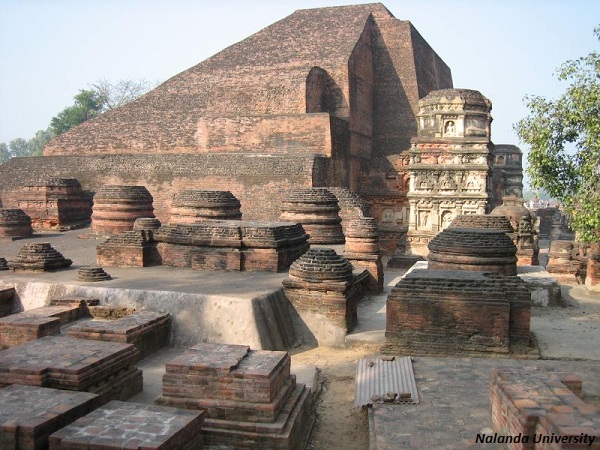
During this period, Nalanda had more than 10,000 students and teachers coming not only from different parts of India, but also from central Asia, China, South East Asia, and Sri Lanka.
Nalanda University was considered as one of the biggest educational institutions of its time.
It imparted education in various branches of knowledge.
Dharmapala donated the royal income from two hundred surrounding villages to meet the expenses of Nalanda University.
Devapala also donated income from five villages.
The king of Suvarnadvipa (modern Malaya Peninsula, Java and Sumatra), Maharaja Balaputradeva erected a monastery in Nalanda and requested Devapala to donate five villages for the maintenance of that monastery.
The Pala kings patronized Hinduism as well.
Vinayakapala built one thousand temples in honor of the Lord Saiva. They also gave donations to Brahmans to settle in their country and run gurukuls.
The powerful Sailendra dynasty of South East Asia sent many embassies to the Pala kings. They ruled over Malaya, Java, Sumatra, and neighboring islands.
The Palas had close trade contacts and cultural links with South East Asia and China.
The trade with South East Asia and China was very profitable and added greatly to the prosperity of the Pala Empire.
Rashtrakutas of Deccan
The Pala kings ruled in the eastern India, the Pratiharas ruled in the north India, and Rashtrakutas ruled in the Deccan.
The term Rashtrakuts literarily means officers in-charge of territorial divisions (known as Rashtras).
The Rashtrakuts were the officers of Rashtra (province) under the early Chalukyas of Badami.
Rulers of Rashtrakutas
Dantivarman or Dantidurga was the founder of the Rashtrakuts dynasty. He made his capital at Manyakhet or Malkhed near modern Sholapur.
Dantivarman was succeeded by his uncle Krishna I about A.D. 758.
Krishna-I extended his kingdom from Maharashtra to Karnataka.
Dhruva became king in about A.D. 779. It was the opening of a new era in the history of Rashtrakutas.
Dhruva was the first Rashtrakuta ruler from Deccan who had intervene in the tripartite struggle of supremacy in north India. He had defeated two powers of the North India i.e the Pratihara king Vatsaraja and the Pala king Dharmapala of Bengal.
Dhruva added the emblem of Ganga and Yamuna to his imperial emblem after his successful campaigns in north India.
Dhruva was succeeded by Govinda-III (A.D. 793-813).
Govinda-III also made invasions into north India and fought successfully against the Pala king Dharmapala and Chakrayudha the ruler of Kanauj.
Govinda-III shattered the union of the Ganga, Chera, Pandya, and Pallava rulers in south India.
Govind-III was succeeded by his son Amoghavarsha-I (A.D. 814-878).
Amoghavarsha-I had been ruled for 60 years. He is better known for his leanings towards religion and literature.
Amoghavarsha supported Jainism. He was a patron of literature and patronized as the men of letter.
Amoghavarsha wrote Kavirajamarga. It was earliest Kannada work on poetics.
Amoghavarsha was a great builder. He built the capital city Manyakhet.
The successor of Amoghavarsha were Indra-III (A.D. 915-927) and Krishna-III (939- 965). Both were the great Rashtrakuta rulers.
Indra-III had defeated the Pratihara king Mahipala-I and ransacked his capital Kanauj.
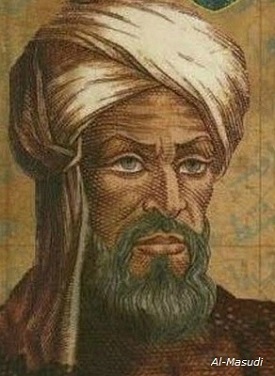
Arab traveler, Al-Masudi, calls the Rashtrakuta king as the greatest king of India.
Krishna-III was the last famous king of Rashtrakuta. He struggled against the Paramaras of Malwa and eastern Chalukya of Vengi.
Krishna-III also struggled against the Chola ruler of Tanjore. He reached up to Rameshwaram and built a pillar of victory and a temple there.
The dominance of the Rashtrakutas in the Deccan is the remarkable period in the history of India.
Rashtrakuta ruled more than three hundred years. They patronized Saivism and Vaishnavism. In addition, they also protected Jainism, Buddhism, and Islam.
The Rashtrakuta rulers permitted the Muslim merchants to settle in their kingdom, build mosques, and preach their religion.
Rashtrakuta rulers equally support Sanskrit, Prakrit, and Kannada along with Apabhramsa languages.
Rock-cut cave temples excavated at Ellora are the symbols of Rashtrakutas religious toleration. They are one of the splendors of Indian arts.
The Kailash temple was built by the Rashtrakuta king Krishna-I. It is a supreme piece of art.
Tripartite Struggle
-
There were three great powers in India in the early phase of 8th century A.D., namely −
The Gurjara Pratihara in the north,
The Palas in the east, and
The Rasthrakutas in the Deccan.
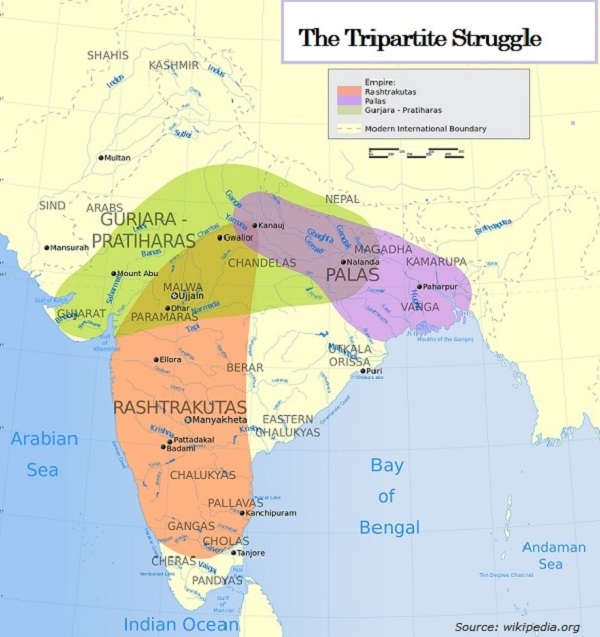
The tripartite struggle for the supremacy between the Palas, the Gurjara Pratiharas, and the Rashtrakutas was the important event of these centuries.
The main cause of this struggle was the desire to possess the city of Kanauj, which was then a symbol of sovereignty. And, some other cause of this struggle was to have control over the intermediate fertile regions.
The shifting of the power among these three was determined both by the internal strength of the respective region and the inability of the rulers to extend their control beyond their respective regions for a longer duration.
All of the three dynasties (enlisted above) were having more or less same military equipment, administrative machinery, and the strategic concepts.
The Arab travelers also affirmed that these three powers were equal in strength.
Because of the balance of power, there was a great political stability within the regions, which nurtured the development of culture and education.
The first encounter took place among the Pratihara king Vatsaraja, the Pala king Dharmapala, and Rashtrakuta king Dhruva.
Rashtrakutas achieved a complete victory in the first phase. But the unfortunate death of Dhruva was a great set back to Rashtrakutas.
Pala king Devapala (A.D. 821-860) was the most prominent in the second phase because his contemporary Pratihara and Rashtrakuta kings were weak rulers.
Pratihara kings Bhoja (A.D. 836-885) and Mahendrapala (A.D. 885-910) proved to be more powerful in the third phase (during the 9th century).
Each of the three kingdoms Pratiharas, Pala, and Rashtrakutas declined almost simultaneously around the end of the 10th century A.D.
The end of these three dynasties marked the end of the glorious era of more than 300 years.
Literature after the Harsha Period
Sanskrit remained the main language of the literature.
Pali and Prakrit were used for writing the Buddhist and Jain religious literature.
Vakapati's Gaudavaho was the biography of Yashovarman of Kanauj. It was the last major work in the older tradition of Prakrit.
Apabhramsha represented the last stage of Prakrit languages. This was considered as an important development in the field of literature because the modern languages, such as Hindi, Gujarati, Marathi, and Bangla have all evolved from it.
A number of kavyas with great significance constitutes a special feature of this period.
The Ramacharita of Sandhyakara Nandi written during the reign of king Mahipal of the Pala kingdom, represents both the story of Rama and the life of king Ramapala of Bengal.
The Raghavaphandavija of Dhananjaya Shrutokriti describes the stories of the Ramayana and the Mahabharata at the same time.
The marriage of Siva and Parvati; and Krishna and Rukmini are described in the Parvati-Rukminiya written by Vidyamadhava.
Vidyamadhava was the court poet of the Chalukya king Somadeva.
Hemachandra composed a work entitled as Saptasandhana (having seven alternative interpretations).
The style of writing in the intricate patterns of double, triple or even more meanings is found in the literature of this period.
Shatarthakavya written by Somaprabhacharya, is an example of literary climax in which every verse was meant for being interpreted in a hundred ways.
Jaina Teachings
-
In addition to all these (discussed above), a large number of Jaina narratives dealing with the lives of Jain teachers were composed. The significant of them are −
Adinathacharita by Vardhamana
Shantinathacharita by Devachandra
Prithvichandracharita by Shantisuri
Parshvanathacharita by Devabhadra
Kuarapalacharita and Neminathacharita by Hemachandra
Sukumalachariu by Shrihara
Neminathacharita by Haribhadra
Other Literary Works
The Neminathacharita by Haribhadra and Sukumalachariu by Shrihara have been entirely written in Apabhramsa.
Rajatarangini written by Kalhana is the most remarkable historical texts in the kavya form. It is the only known attempt to write history in the modern sense.
Rajendra Karnapura is a eulogy of king Harsha of Kashmir written by Shambu.
-
Other literary works of this category are −
Prithviraja Vijay of Jayanka
Dvayashraya Mahakavya by Hemachandra
Kirtikaumndi by Someshvara
Vikramankadevacharita of Bilhana
Navasahasankacharita of Padmagupta
Kirti Kaumudi by Somadeva
-
The most important among the treatises were the poetic works. Some such works are −
Kavyamimamsa by Rajashekhara
Dasharupa by Dhananjaya
Saraswati Kanthabharana by Bhoja
Kavyanushasana of Hemachandra
Kavikanthabharana by Kshemendra
-
The famous work in the field of prose literature are −
Brihatkathamanjari by Kshemendra
Kathasaritasagara by Somadeva
Kathakoshaprakarana by Jineshvara Suri
-
The famous dramas are −
Lalitavigraharaja nataka by Somadeva,
Harikeli nataka by Visaladeva
Prasannaraghava by Jayadeva
Karnasundari by Bilhana
Abhidhana Chintamani, Deshinamamala, Anekarthasamgraha, Nighantushesha, all written by Hemachandra.
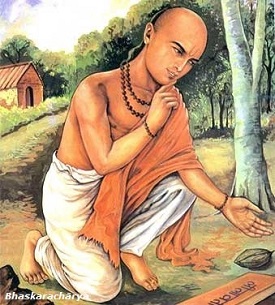
The famous mathematician Bhaskaracharya also belonged to the 12th century. A.D.
Siddhanta-Shiromani, comprises in four parts, namely Lilavati, Vijaganita, Grahaganita, and Gola. Gola deals with astronomy.
Siddhanta Shiromani propounded the principle of Perpetual Motion. It was transmitted by Islam about A.D. 1200 to Europe. This led to the development of the concept of power technology.
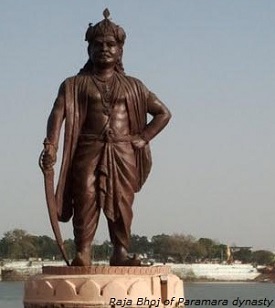
Rajmariganka is the work on astronomy written by King Bhoja of Paramara dynasty.
Madhava wrote several works on medicine. Nidana or Riguimshchana is his best known work on Pathalogy. It was translated into Arabic under the guidance of Harunal Rashid.
Chikitsa Kutamudgara and Yogavyakhya were also written by Madhvav.
Chikitsakalika or Yoga-mala written by Vagabhata II's son Tisata.
Yogaratnasamuchchhaya was written by Chandratha. He was the son of Tisata.
Brinda of Bengal wrote his Siddhayoga between A.D. 975 and 1,000.
-
Some commentaries compiled during this period are −
Krityakalpataru written by Lakshmidhara
Chaturvarga Chintamani written by Hemadri
Mitakasara written by Vijnaneshvara
Dayabhaga (Law of inheritance) written by Jimutavahana
Vyavaharamatrika and Kalaviveka Manuvritti by Govindaraja
Smrityarthasara written by Shridhara
A commentary on the Yajnavalkyasmriti written by Apararka
A commentary on the Yajnavalkyasmriti was also written by Vijnaneshvara
Smritichandrika written by Devanna Bhatta are other outstanding creations of this period.
-
Important works on polity are −
Nitishastra written by Mathara
Nitisara written by Kamandaka
Nitivakyamrita by Somadeva suri
Society after the Harsha Period
-
Two important trends continuing in society since the 7th century A.D. and onwards were −
The continuity of the assimilation of foreign elements and
The segregation of jati system.
Caste System
There were four original varnas with several jatis, which were further subdivided into numerous subsections.
Law of this period accepted birth, profession, and residence as the deciding factor in the determination of jati system.
By the time, Brahmans came to be identified by their gotra, ancestor, branch of Vedic learning, original home, and village.
The Kshatriyas also multiplied as a result of the assimilation of foreigners and other local people.
-
Two important factors that raise the number of mixed jatis were −
Transformation of a specific profession into jati and
Increasing phenomenon of hypergamous unions between different jatis.
Jatis were also formed on the basis of religious sects such as Lingayats, Virasaivas, Svetambaras, and Digambaras, etc.
Chandalas were the most important representatives of Antyajatis, which were the lowest of all Jatis.
The traditional professions related to four Varnas were not rigorously followed during this period.
There were Brahmans, who did not habitually confine their activity to studying, teaching, worshipping, and the performance of priestly functions.
Vaisya Brahman lived by engaging himself in agriculture and trade.
Sudra Brahman sells lac, salt, milk, ghee, honey etc.
The kshatriyas, vaisyas, and sudras deviated from their traditional professions and formed several mixed castes.
Kayasthas was an important class emerged as a jati during this period. Kayasthas were engaged as clerks of the administration, they were responsible for writing documents and maintaining records.
Kayasthas emerges from the Mauryan period itself, but by the 7th century, they came to be regarded as distinct jati.
The marriages were often arranged by parents or other guardians of the parties and sometimes girls chose their husbands. But generally, in marriage old rules as mentioned in the Smritis were followed.
New ideas and practices regarding the remarriages were also seen. The words like punarbhu and didhishu were frequently used in the literature. This means, remarriage of a woman was permitted.
The women's right to inherit property was accepted by the authorities.
The widow was entitled to succeed to the whole estate of her issueless and/or deceased husband.
Economy after the Harsha Period
The literary and inscriptional evidences of the post Harsha period illustrate the advanced state of agriculture, trade, and economy.
Agriculture
Medhatithi (who was is one of the oldest and most famous commentators on the Manusmti) included a group of seventeen articles in the category of grain (dhanya).
Abhidhanaratnamala mentioned the scientific knowledge of agriculture. A large variety of cereals and other food grains with their synonyms are mentioned.
Classification of soil as fertile, barren, fallow desert, excellent as well as those green with grass or abounding in needs are also mentioned along with the types of soil such as black or yellow soil.
Different kinds of fields were selected for different classes of crops.
Irrigation by the arahata (Persian wheel) and by leather buckets is mentioned.
The inscriptions show that the Persian wheel was present in India much prior to the arrival of Muslim rulers.
It is mentioned by Medhatithi that the agriculturist should be expected to know about what seed was to be sown thickly and what sparsely, what soil was fit for a particular kind of seed and what soil was not so fit, and what harvest was expected from a special variety of seed.
Textile was the oldest industry. The progress of Gupta period continued during this period.
A number of variety and qualities of textiles such as woolen and hempen yarns, garments made of silk, deer's hair, and sheep and goats wool are find mentioned in the contemporary literature.
The contemporary literature of this period also mentioned about the professions of weavers, dyers, and the tailors.
Various metal namely copper, brass, iron, lead, tin, silver, and gold were used during this time. Some centers of metal industry were developed, for example, Saurashtra for bell industry and Vanga for the tin industry were known.
Trade
Indian, Chinese, and Arab sources mentioned the flow of trade between east and west through India.
The Arab traveler, Ibn Khordadbah in the end of the 9th century, mentioned about Indian exports consisting of diverse products including sandal wood, camphor, and camphor water, nutmeg, clove pink, coconut, precious, and semiprecious stones, pearls, fisheries, textiles of cotton, and silk and variety of metal products.
The best breeds of horses were imported from central and western Asia.
Foreign merchants were gradually settled in India. They were attracted by the prosperity of coastal towns of Gujarat, Malabar, and Tamil.
Arab geographers mentioned some of the India ports located on the west coast namely Debal (in Indus delta), Cambay Jhana, Sopara, and Quilon.
The Arab travelers gave descriptive details about the prosperity of Sailendra kings. He established political, cultural, and economic relations with Indian kings.
The guilds continued to play an important part as in the previous centuries.
Medhatithi mentions both the industrial and mercantile guilds.
Guilds consisted of people following common profession such as tradesmen, artisans, money lenders, etc.
South Indian inscriptions mentioned about the working of two famous trading corporations.
Manigramam was the first trading corporations. It was known since the 9th century to the 13th century. It carried on in the coastal as well as inland towns of south India.
Art and Architecture
This phase was undoubtedly a fruitful age for the art and architecture, which are apparent from the numerous temples standing for the 1,200 years.
These temples are among the most beautiful structures of that era and famous for their styles of architecture.
Bhubaneshwar temple of Orissa is an excellent example of the Nagar style or north Indian style.
The great Lingaraja temple of Bhubaneshwar and Sun temple of Konark are the monumental examples of architecture.
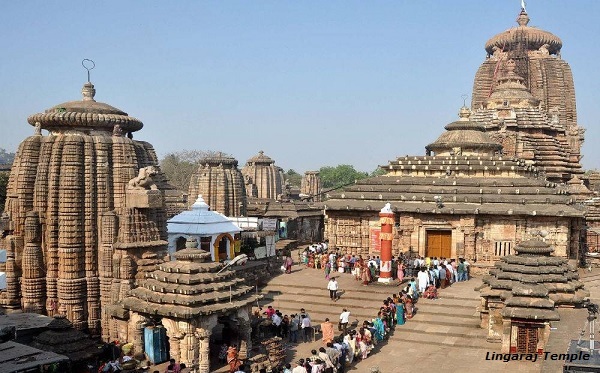
Khajuraho temples in Bundelkhand are excellent Nagar style temples built by the Chandelas. They were built on raised plinth and known for their carving and erotic sculptures.
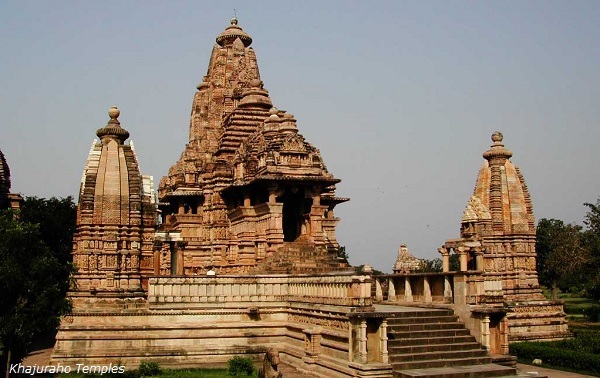
Kandarya Mahadeva temple is another example of excellent architecture.
The Sun temple in Kashmir, called as the Martanda temple was built by Lalitaditya Muktapida around the 8th century A.D., It is the best example of Kashmir style of architecture.
The Jains temples generally have the octagonal dome and are decorated with subjects drawn from the Jain mythology.
The famous temples of Dilwara (Mt. Abu) and Satrunjaya (Palitana) are the best examples of Jain architecture. These temples are famous for their elegant carvings and rich design.
57 feet high Jainis sculpture of Gommatesvara at Sravanabelagola in Hasan, Mysore is one of the largest free standing images in the world.
In the Deccan, the temples of Vatapi (Badami) and Pattadakal (Bijapur) are stylistically different. Further, Hoysalesvara temples (Halebid), though are incomplete, but distinct for its structural and decorative features.
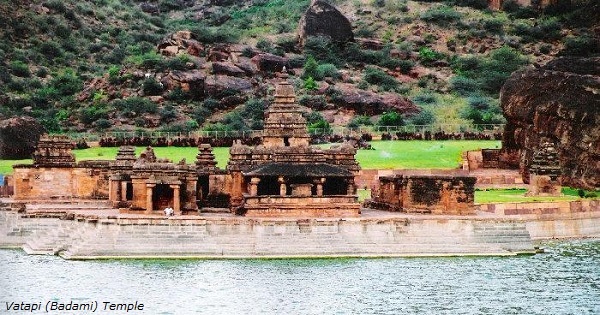
Pallavas built several temples in south India. Important among them are Dalavanur temple at (Arcot district) Pallavaram, Vallam (in Chinglepeet district), and Rathas.
The Kailash temple at Ellora is an example of solid rock temple, dedicated to Siva. It was excavated during the reign of Krishna I of the Rashtrakuta dynasty. It is one of the architectural marvels of this period.
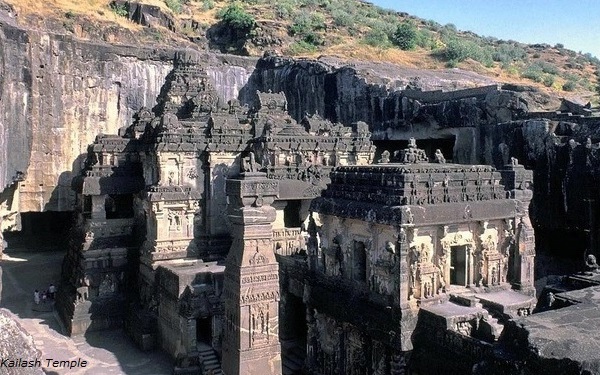
Meenakshi temple of Madurai is the specimen of the Dravidian style of temples.
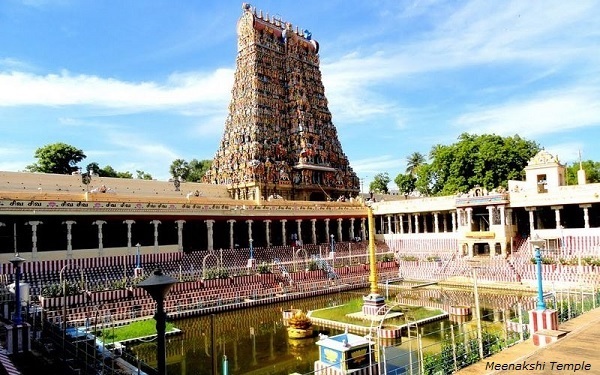
The older tradition of wall painting continued to be used to decorate the walls of temples and palaces.
Religion after the Harsha Period
The fundamental features of religion characterized during the previous period continued during this period.
Buddhism and Jainism developed some similarity with Saivism and Vaishnavism on theistic tendencies.
Buddhism witnessed depravity of pure Hinayana and Mahayana Buddhism during this period
Buddha's teachings, which were earlier free from rituals gradually gave way to new ethical and devotional attitude in which Buddha had begun to be worshiped as a god.
This worship became more elaborate with devotional songs accompanied by rites and ceremonies.
Vajrayana Buddhism (the vehicle of thunderbolt) shows the influence of Tantric ideas on Buddhism.
Kanchi was the great center of Buddhism in south India.
The Chola kings also gave donations to Buddhists.
-
During this period, Buddhism began to decline because −
It did not get the royal patronage;
Attacks on monasteries and killing of monks resulted in migration of Buddhists from eastern India; and
The coming of Islam
Jainism gained popularity among the trading classes in north and west India.
It received extensive royal patronage in south India.
It was honored by the Gangas, Chalukyas, and by Rastrakuta rulers in the Deccan.
Jain doctrines of the four gifts (learning, food, medicine, and shelter) helped to make Jainism popular among the people.
Hinduism became popular in the forms of Saivism and Vaishnavism.
In Vaishnavism, the incarnation of Vishnu became more popular. The most popular incarnation was Krishna.
Krishna and Radha were worshiped and their love was interpreted as attachment of the human soul for the universal soul.
Alvars, in the south, represented the emotional side of Tamilian Vaishnavism.
Acharyas represented the intellectual and philosophical sides of Vaishnavism.
Saivism attained a dominant position in the society. The main principles remained the same, though there were local variations and consequent doctrinal differences.
The bhakti movement became popular during the 9th and 10th century A.D.
The bhakti movement led by Nayanars (Saiva saint) and Alvars (Vaishnav saint) spread all over the country.
Lingayats or Virasaivas were another popular movement spread in south India during this time.
Tantricism
Tantricism had originated in the 6th century, but became popular from the 8th century onwards. It was very popular in north eastern India and Tibet. Some of its rituals came from the Tibetan practices.
Tantricism was open to all castes as well as to women. It is propagated that Tantricism is the simplification of the Vedic worships.
Tantric practice centered on prayers, mystical formulae, magical diagrams, and symbols and the worship of a particular deity.
Mother image was accorded great worship, as the life is created in the mother's womb. In this way, it is connected with the Sakti worships.
The guru had the highest place in Tantricism.
Philosophy after Harsha Period
Sankara was the greatest intellectuals and philosophers of this period. He was also known as Adi-Sankaracharya.
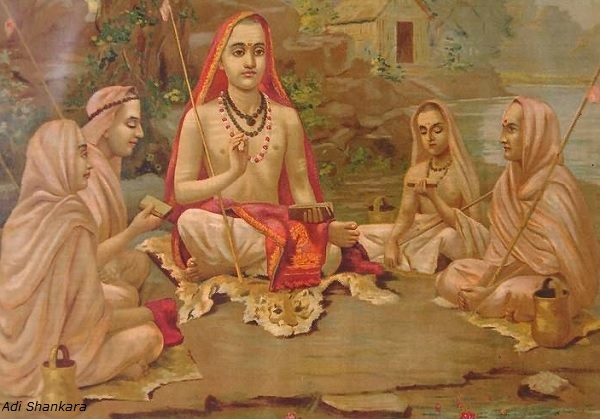
Sankara took birth in the family of Yajurvedin Brahman in Kerala around A.D. 788. His father Shivaguru died when he was only three years old.
At the early age of 8 years, Sankara chose an ascetic life. He studied at Kasi and he died at the early age of 32.
The philosophy of Sankara is known as Advaita meaning 'non-dual'. He believed that absolute reality is called Brahma is non-dual.
-
Sankara upheld the Vedas as the source of true knowledge and written many works, for example −
Brahmasutra-bhashya,
Commentaries on the Upanishads, and
Commentaries on Bhagavad-Gita
Sankara organized the ten branches of Advaita school of Saivism known as Dashanamis.
-
Sankara founded four mathas in the four corners of the country for the purpose of better interaction, namely −
Badrinath in the north;
Sharadapitha at Dvaravati (Dwaraka) in the west;
Govardhanamatha at Puri in the east; and
Shringeriinatha in the south
Each matha has presiding deities called Gotra.
Ramanuja, who was a Tamil Brahman, was a great philosopher and intellectual. He was born at Tirupati around A.D. 1017.
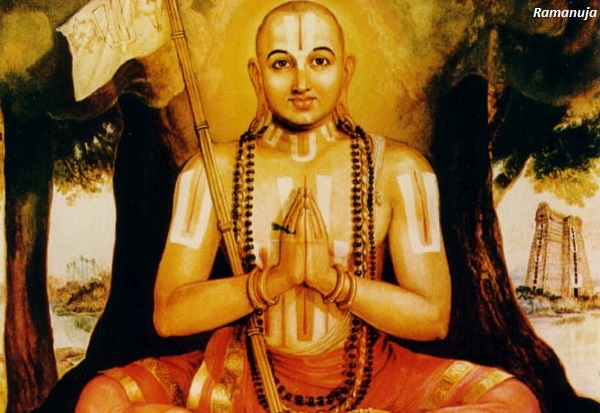
Ramanuja disagreed with Sankara on the idea of knowledge being the primary means of salvation. He assimilates Bhakti to the custom of Vedas.
Ramanuja tried to build a bridge between the bhakti and the knowledge of Vedas.
References and Disclaimer
Statement of Copyright and Fair Use
The facts of the study material (Ancient Indian History), presented here are based on NCERT Ancient History, Old Edition (Class XI written by Makkhan Lal) under the copyright guidelines.
Furthermore, the Ancient History Study Materials available on this website is published in good faith and only for general information. However, if the authority of this study material feels otherwise, kindly contact us at contact@tutorialspoint.com. We will make changes or even remove those parts.